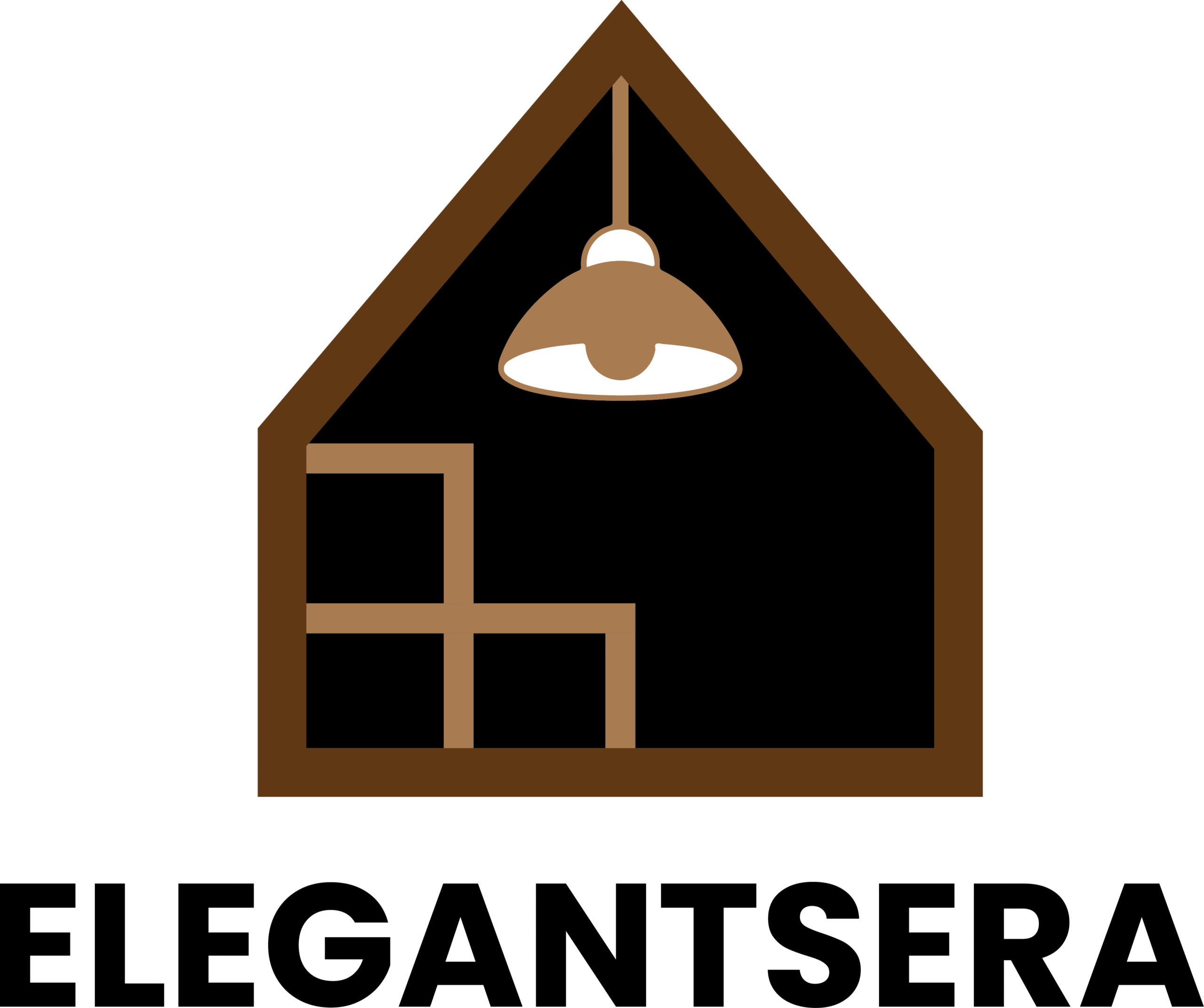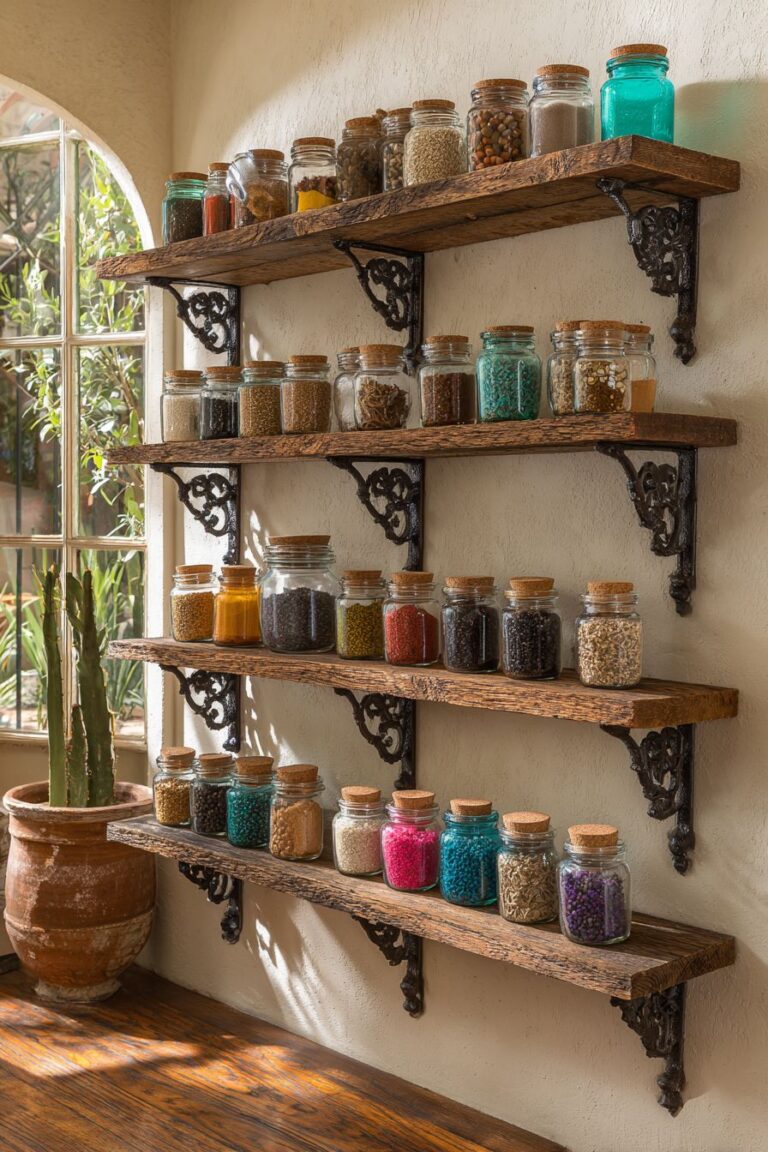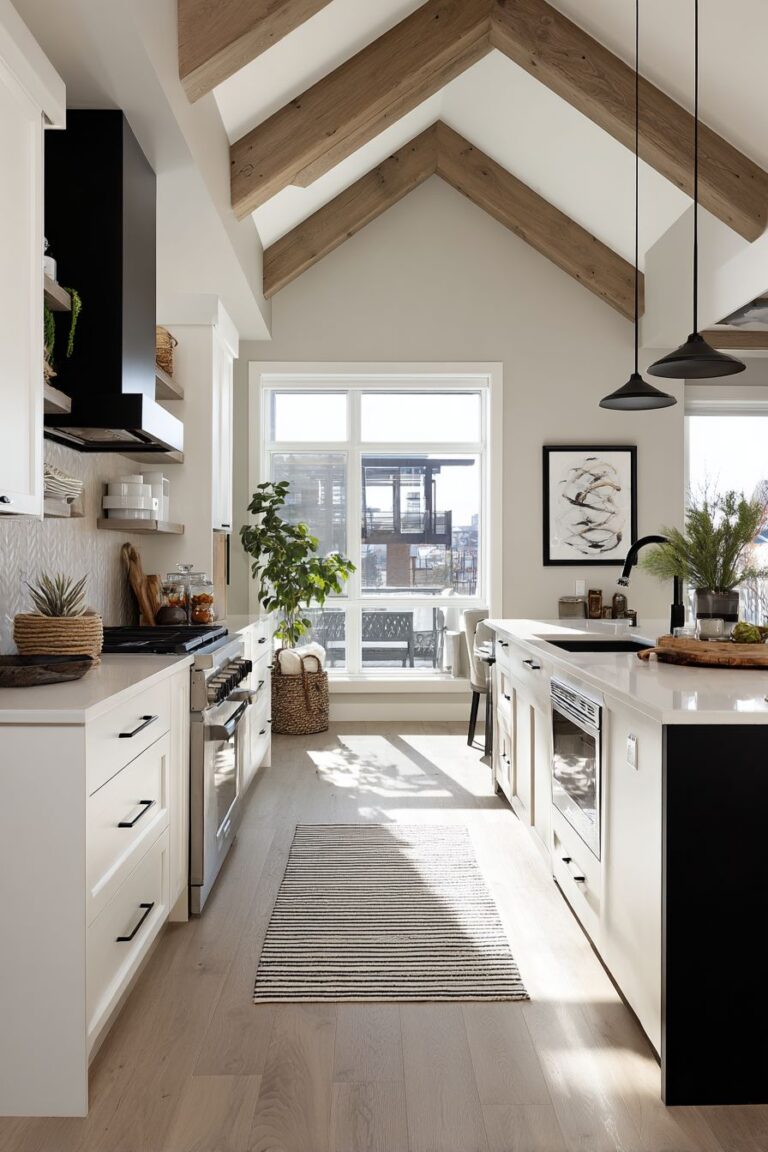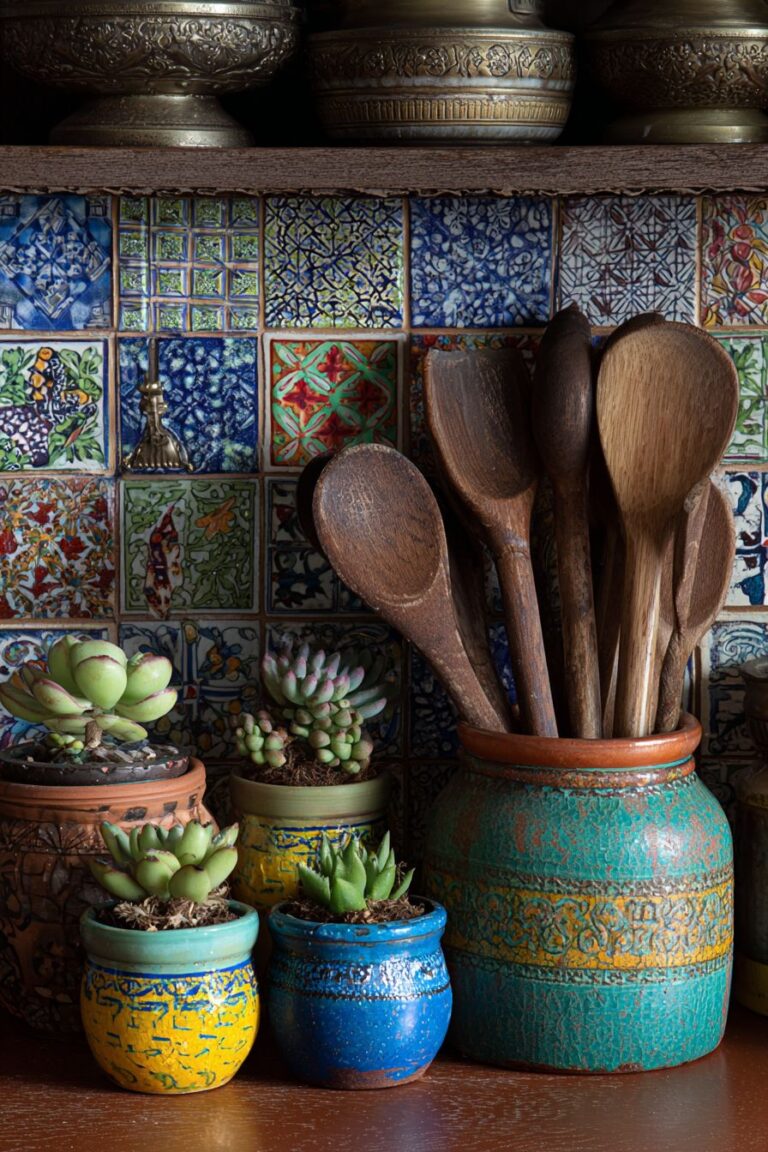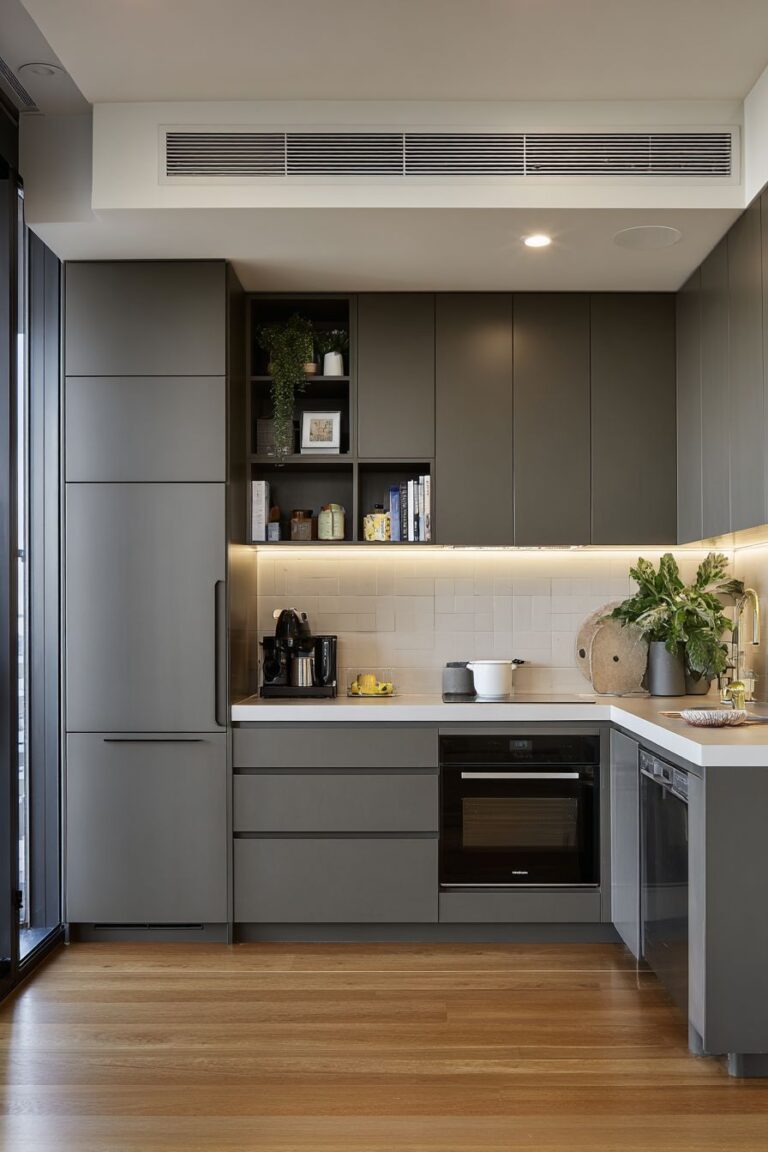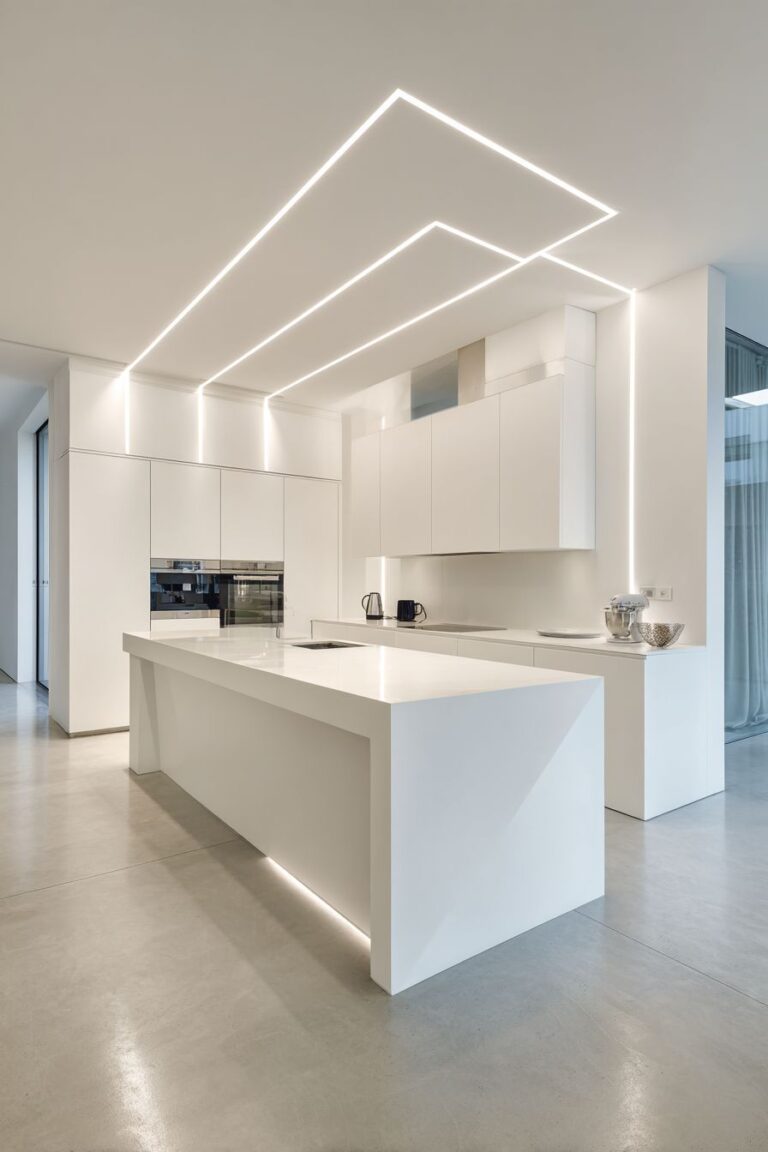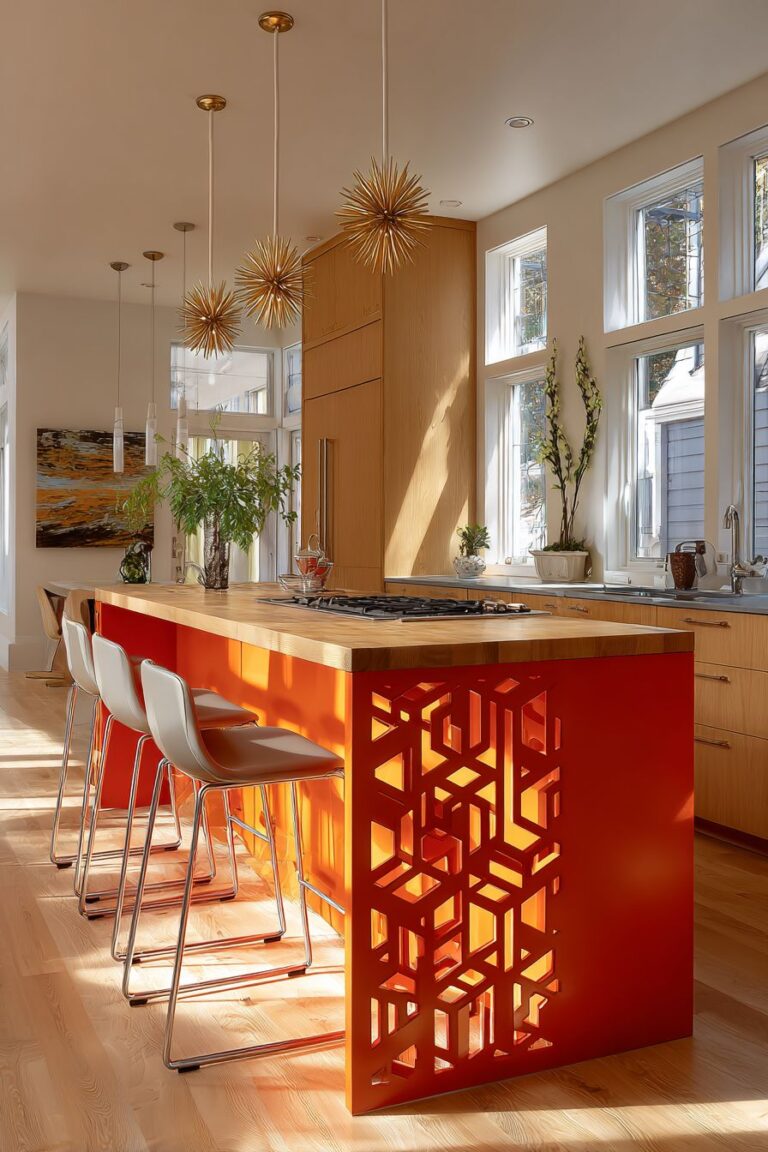30 Inspiring Kitchen Decor Ideas For Every Style and Space
The kitchen has evolved far beyond its traditional role as a purely functional cooking space. Today’s kitchens serve as the heart of the home—a place where families gather, friends connect, and culinary creativity flourishes. Thoughtful interior design in the kitchen creates an environment that not only supports efficient meal preparation but also reflects your personal style and enhances daily living. Whether you’re drawn to the warmth of rustic farmhouse charm, the sleek sophistication of modern minimalism, or the timeless appeal of traditional craftsmanship, the right design elements can transform your kitchen into a space that truly inspires.
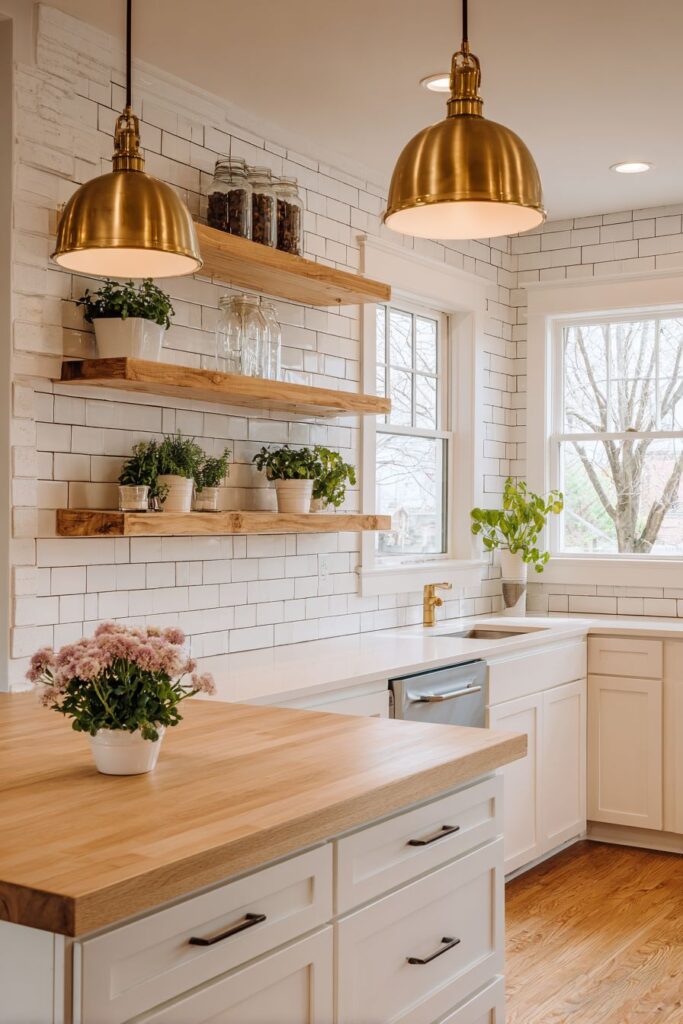
The beauty of kitchen design lies in its incredible diversity and adaptability. From compact galley kitchens that maximize every inch of space to expansive chef’s kitchens with professional-grade appliances, each design approach offers unique solutions to common challenges while expressing distinct aesthetic preferences. The following collection showcases thirty distinctive kitchen design concepts, each carefully crafted to demonstrate how different materials, colors, textures, and layouts can create spaces that are both beautiful and highly functional.
These designs span the spectrum from bold statement-making spaces to quietly elegant environments, offering inspiration for homeowners with varying tastes, budgets, and spatial requirements. Each concept represents a thoughtful approach to balancing form and function, proving that exceptional kitchen design is achievable regardless of your home’s architectural style or size constraints.
1. Farmhouse-Style Open Shelving Display
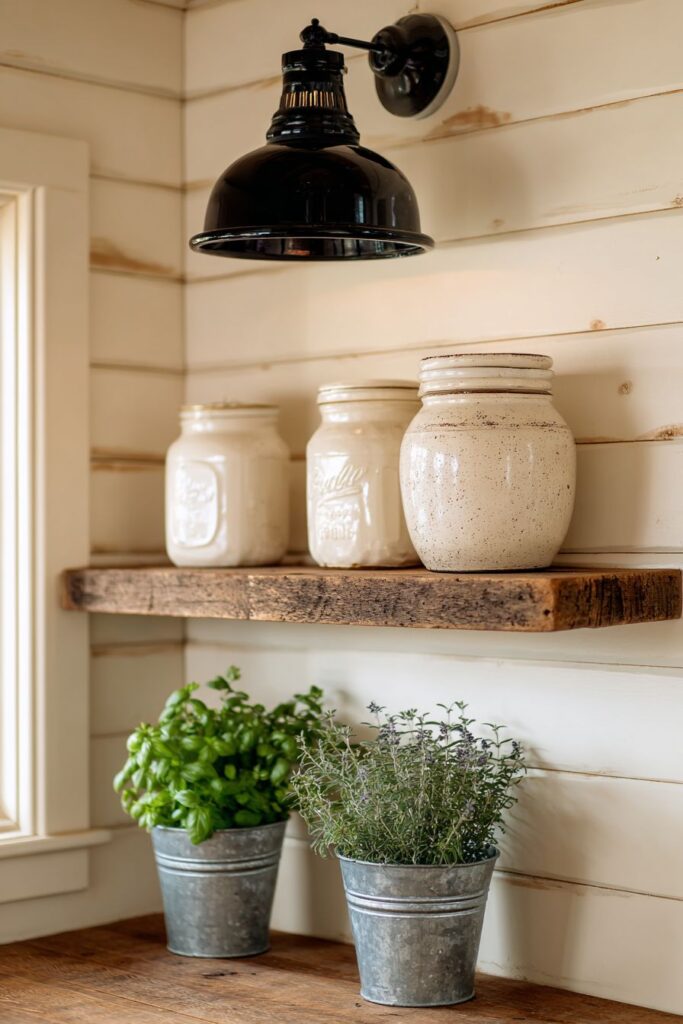
Step into a kitchen where farmhouse charm meets practical functionality through the artful display of open shelving. Against a crisp white shiplap backsplash, reclaimed wood shelves showcase a carefully curated collection of vintage mason jars, weathered ceramic crocks, and thriving herb gardens housed in galvanized metal planters. The natural wood grain tells its own story through visible knots, weathering, and the patina that only comes with age and use.
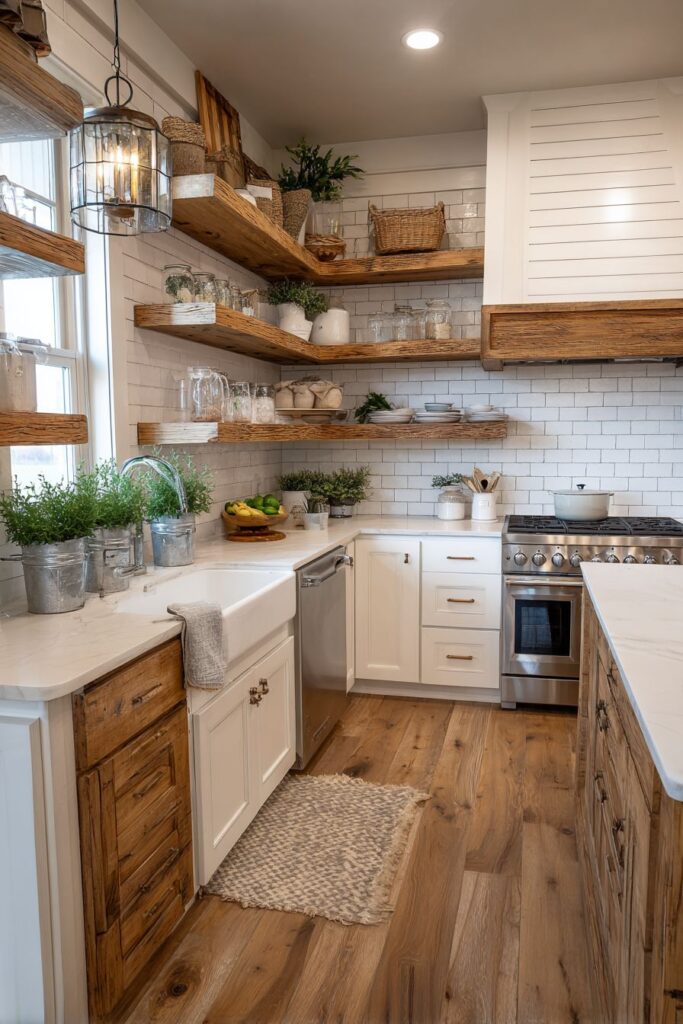
The magic of this design lies in its ability to make storage feel like decoration. Each shelf becomes a vignette, with everyday items arranged in pleasing compositions that celebrate both form and function. The warm pendant lighting casts gentle shadows that emphasize the wood’s texture while creating pools of inviting illumination throughout the space. The interplay between the smooth, painted shiplap and the rough-hewn shelves creates visual interest without overwhelming the senses.
This rustic aesthetic extends beyond mere decoration to encompass a philosophy of sustainable living and appreciation for handcrafted objects. The galvanized planters not only provide homes for fresh herbs but also introduce the satisfying contrast of metal against wood that defines authentic farmhouse style. The overall effect is a kitchen that feels both timeless and thoroughly contemporary in its approach to open storage solutions.
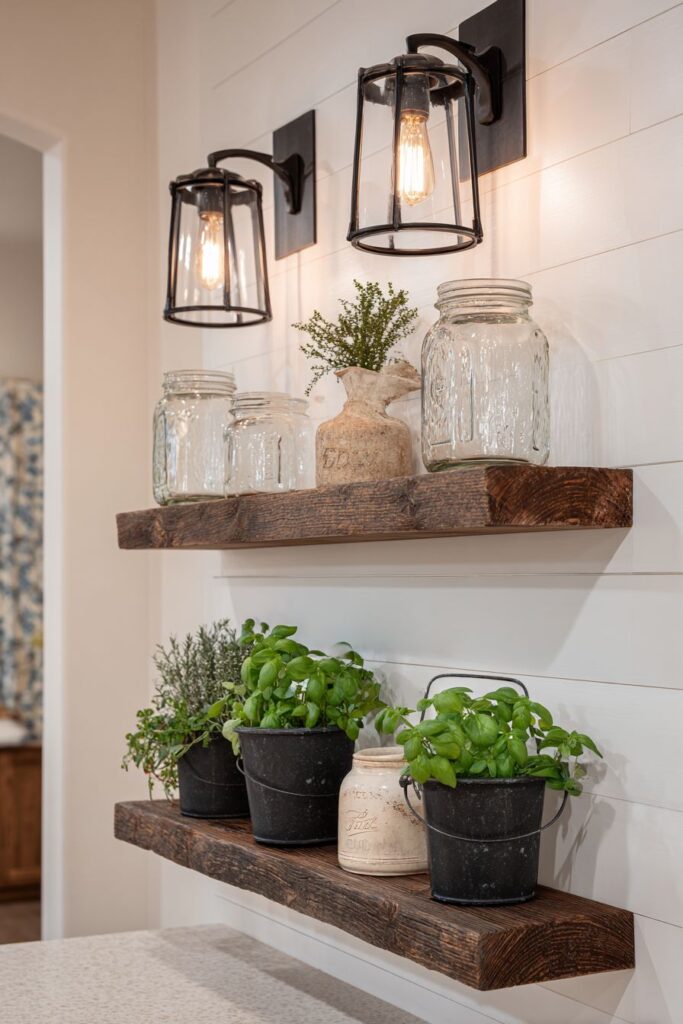
The functionality of this design cannot be overstated. Open shelving encourages organization and makes frequently used items easily accessible, while the natural materials create a sense of warmth and authenticity that mass-produced cabinets simply cannot match. The integration of living herbs brings both color and functionality to the space, creating a connection to the garden that enhances the farm-to-table cooking experience.
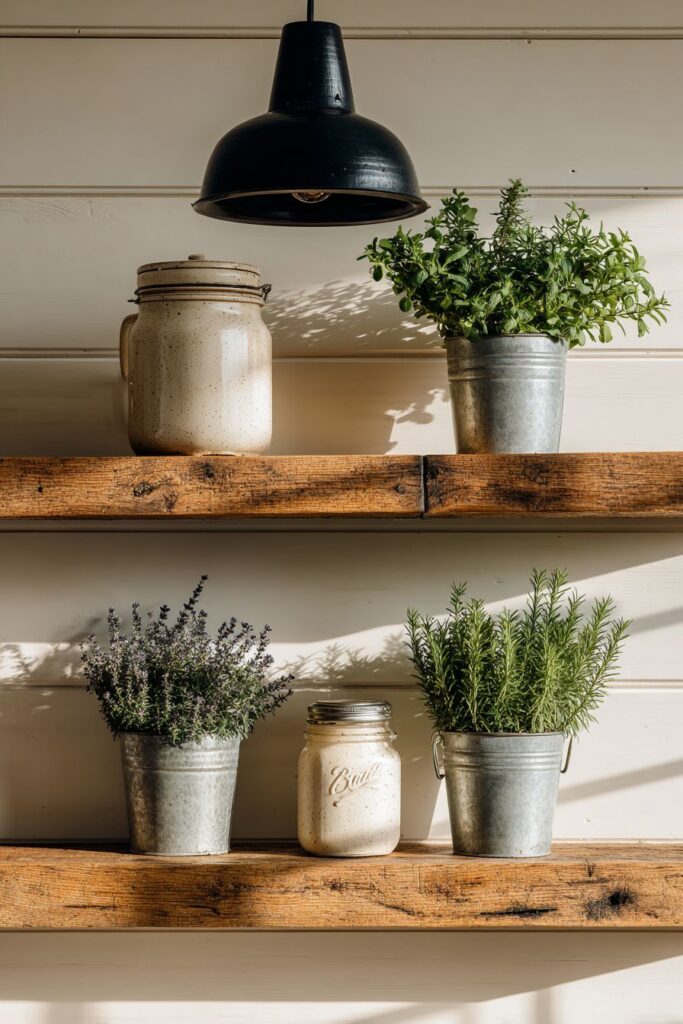
Key Design Tips:
- Select reclaimed wood with visible character marks for authentic farmhouse appeal
- Group items in odd numbers and varying heights for natural-looking displays
- Include living elements like herbs to add freshness and functionality
- Use warm-toned lighting to enhance wood grain and create an inviting atmosphere
- Balance open storage with some closed cabinets to maintain visual calm
2. Modern Subway Tile Sophistication
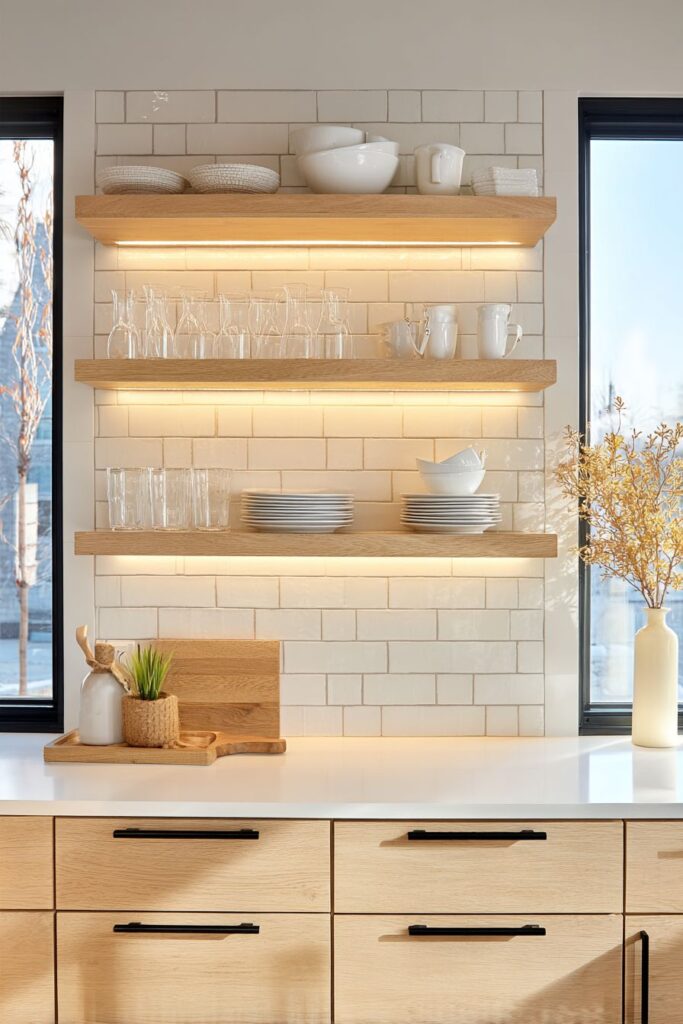
The timeless appeal of subway tile receives a contemporary update in this elegantly restrained kitchen design. Classic white rectangular tiles extend from countertop to ceiling, creating a seamless backdrop that feels both spacious and sophisticated. The strategic use of dark grout lines adds definition and visual interest while maintaining the clean, geometric quality that makes subway tile eternally popular in modern kitchen design.
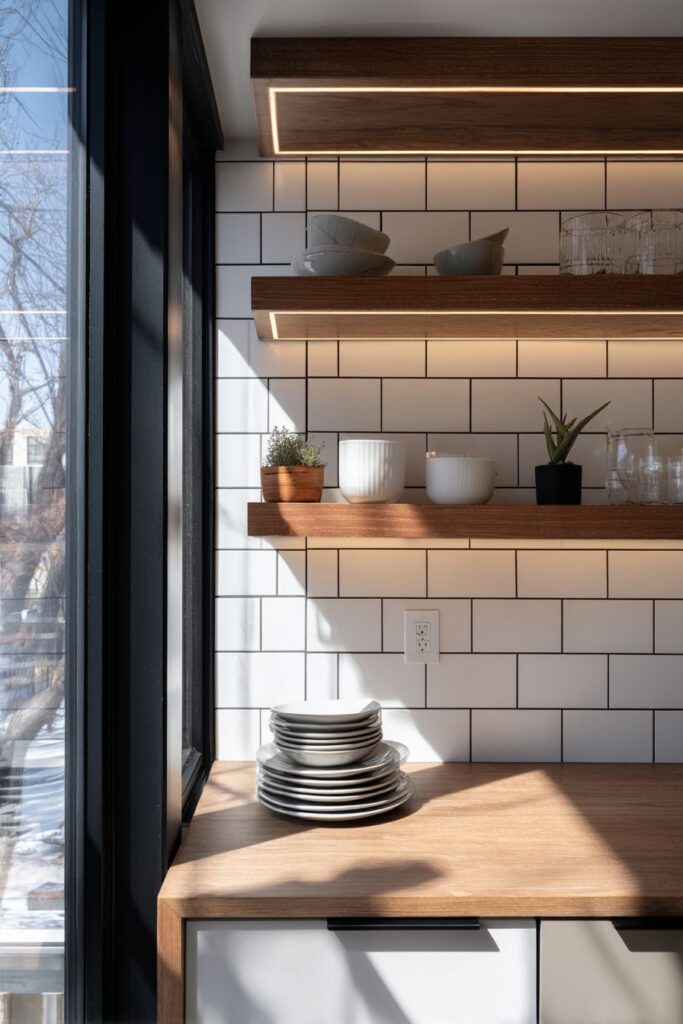
Floating wooden shelves with integrated LED strip lighting create a stunning display area for minimalist white dishes and crystal-clear glassware. The wood introduces warmth to the otherwise cool palette, while the LED lighting transforms functional storage into an attractive focal point. The shelves appear to hover against the tiled wall, creating a sense of lightness that prevents the design from feeling heavy or overwhelming.
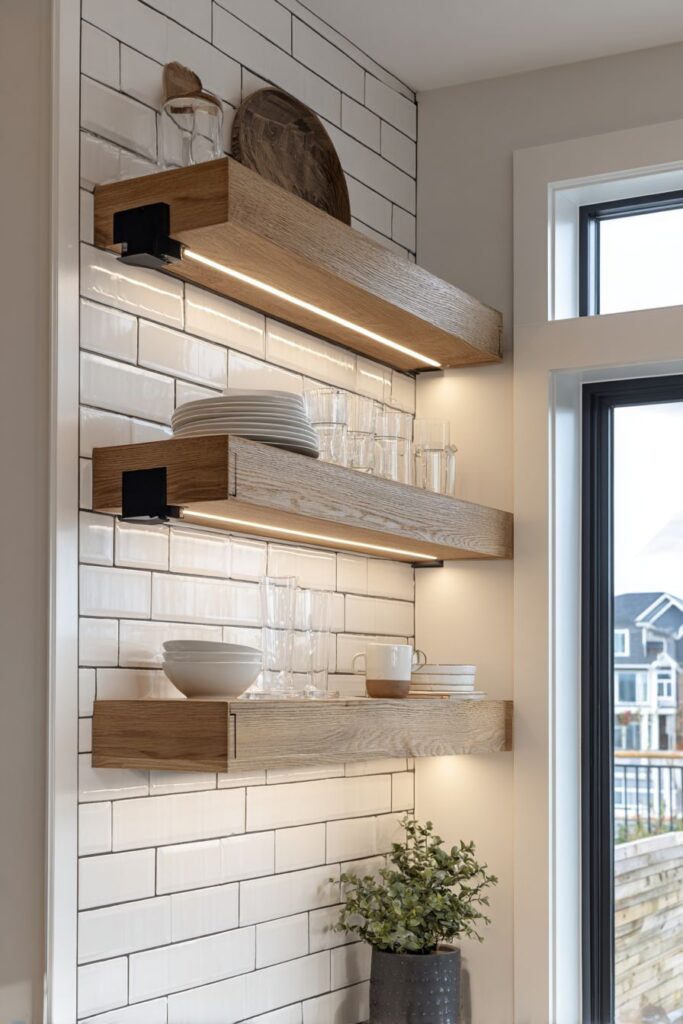
The addition of matte black hardware on lower cabinets provides a sophisticated contrast that grounds the design and adds visual weight where needed. This strategic use of dark elements creates balance and prevents the all-white scheme from appearing sterile. Natural daylight streaming through nearby windows enhances the interplay between light and shadow, making the space feel bright and airy throughout the day.
This modern kitchen design exemplifies the principle that simplicity, when executed with precision and attention to detail, can be far more impactful than elaborate ornamentation. The clean lines and balanced proportions create a sense of calm that makes cooking and entertaining a pleasure rather than a chore.
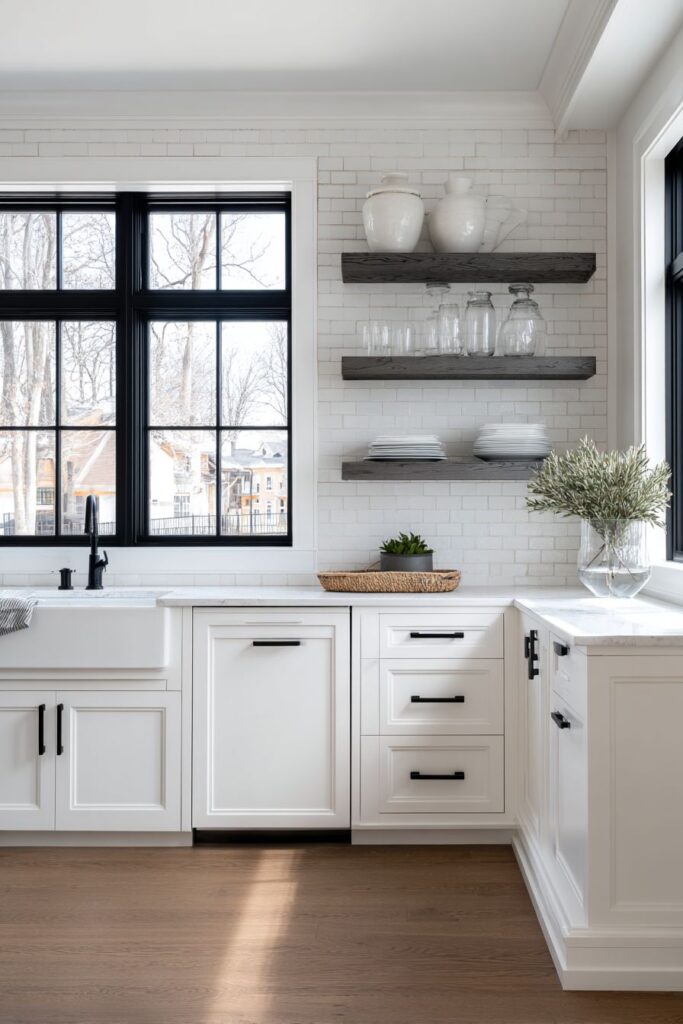
Key Design Tips:
- Extend subway tile to the ceiling for maximum visual impact
- Use dark grout to define tile patterns and add architectural interest
- Incorporate LED lighting in shelving for both function and dramatic effect
- Balance light colors with strategic dark accents for visual grounding
- Choose matte finishes on hardware to reduce fingerprints and glare
3. Bold Geometric Tile Statement
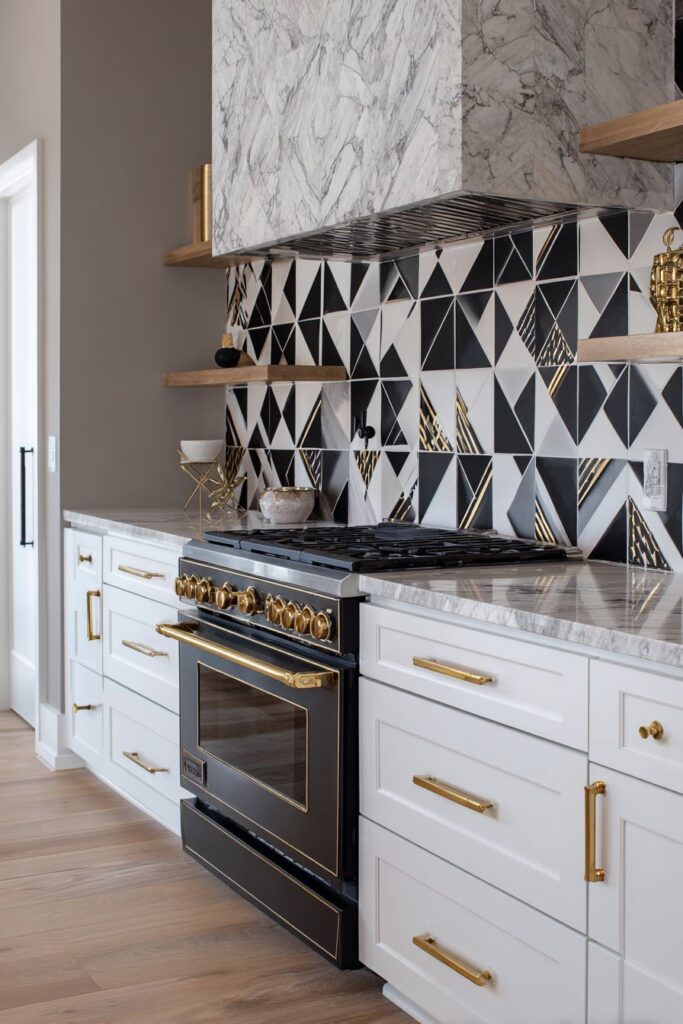
A striking navy blue and white geometric tile backsplash transforms the area behind the range into a captivating focal point that commands attention while maintaining sophisticated elegance. The intricate pattern plays with perception, creating visual movement that energizes the space without overwhelming other design elements. This bold choice demonstrates how a single dramatic element can define an entire kitchen’s character.
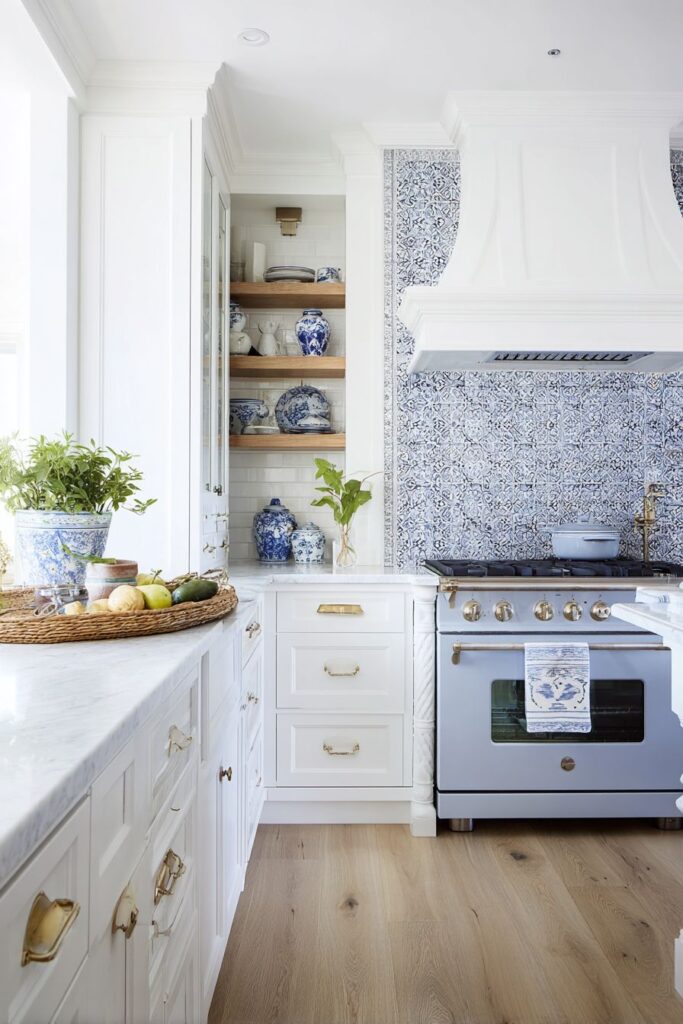
The geometric pattern works in harmony with brass hardware and fixtures, creating a warm metallic accent that complements both the deep navy and crisp white elements. The brass adds a touch of luxury and warmth that prevents the bold pattern from feeling too stark or cold. White cabinetry provides a neutral foundation that allows the patterned tiles to shine while maintaining visual balance throughout the space.
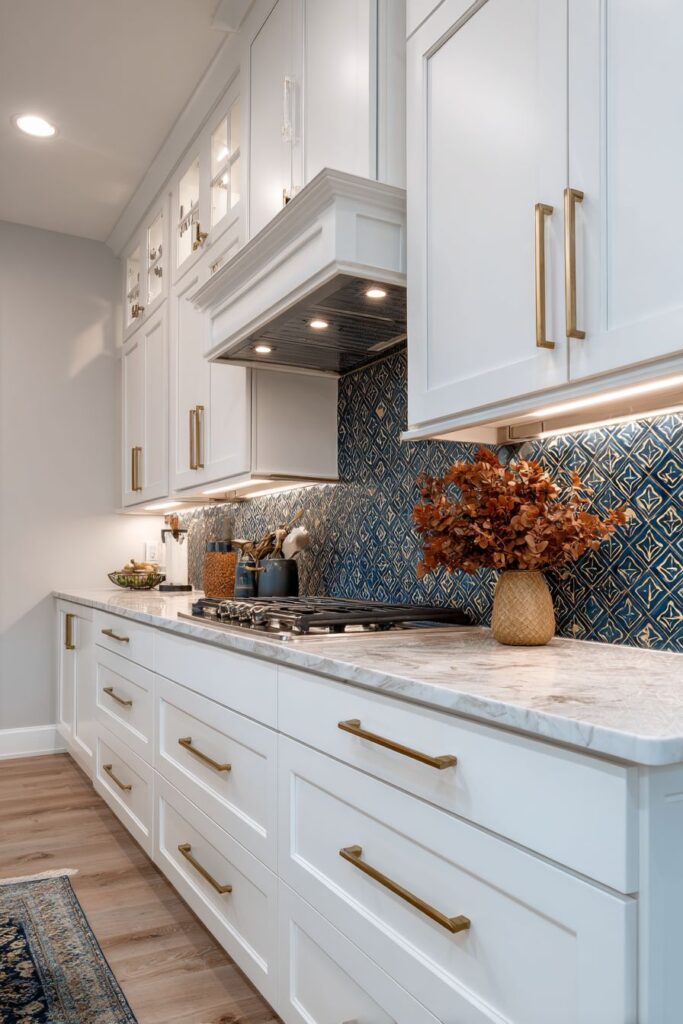
Natural marble countertops with subtle gray veining add another layer of pattern and texture that somehow manages to coexist beautifully with the geometric tiles. The organic patterns in the marble provide a soft counterpoint to the rigid geometry of the backsplash, creating a sophisticated interplay between natural and man-made elements that keeps the eye engaged.
The success of this design lies in its confident use of pattern and color. Rather than playing it safe with neutral tones, this kitchen embraces bold choices while maintaining harmony through careful material selection and thoughtful proportions. The result is a space that feels both timeless and thoroughly contemporary.
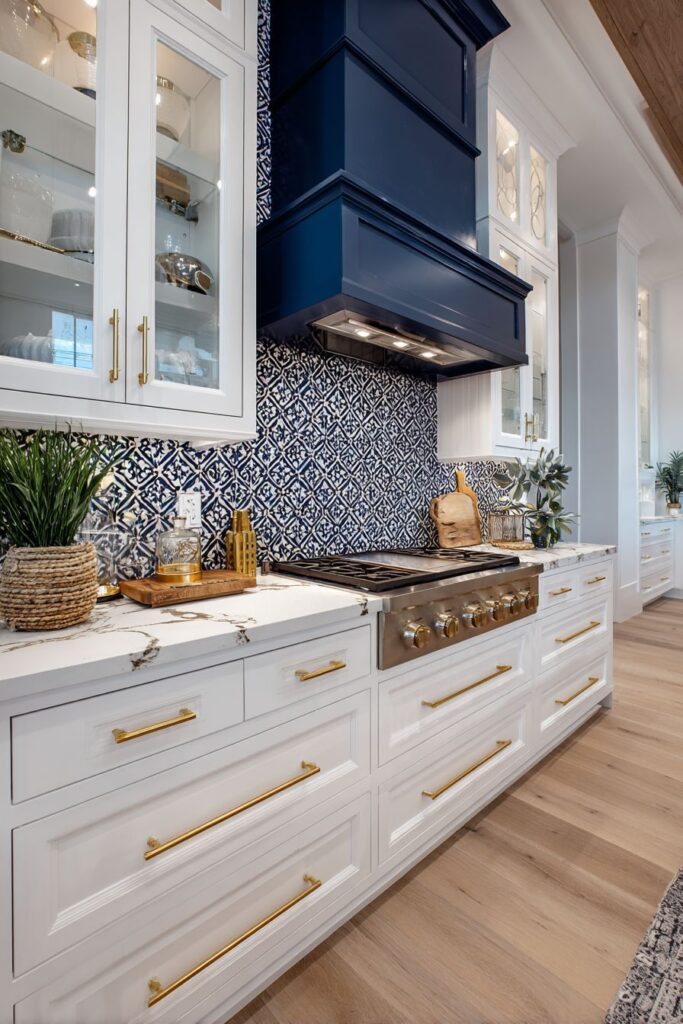
Key Design Tips:
- Choose one statement element and keep other finishes relatively simple
- Use warm metallic accents to soften bold color combinations
- Balance geometric patterns with organic textures like natural stone
- Ensure adequate lighting to showcase intricate tile patterns
- Consider the pattern’s scale in relation to the room’s proportions
4. Dedicated Coffee Station Luxury
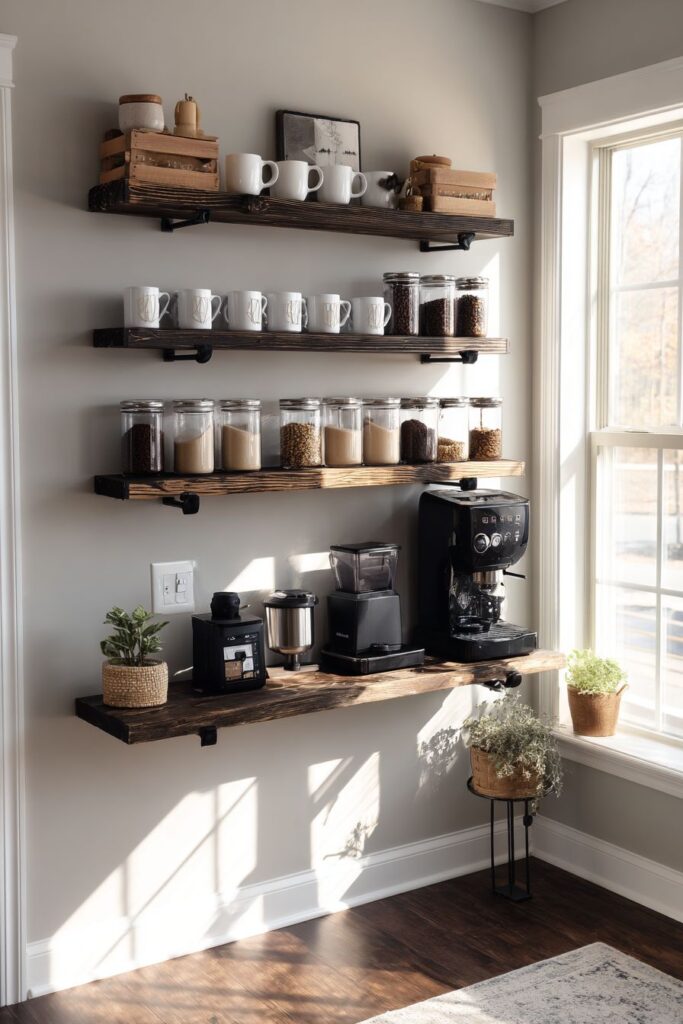
The modern coffee enthusiast deserves a dedicated space that celebrates the ritual of brewing the perfect cup. This thoughtfully designed coffee station features floating dark walnut shelves against a soft gray wall, creating a sophisticated backdrop for an integrated cup storage system and built-in espresso machine nook. The rich wood grain adds warmth and luxury to what could otherwise be a purely utilitarian area.
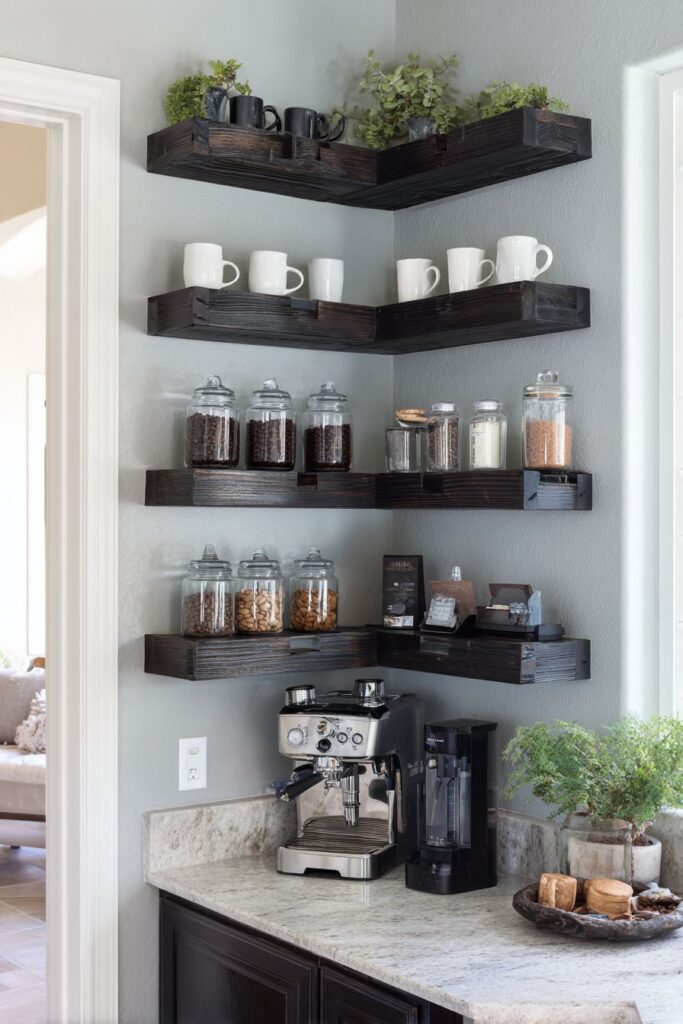
Organization becomes art in this carefully curated display. Coffee mugs hang from purpose-built hooks, while glass containers showcase an array of coffee beans, creating both storage and visual interest. Small appliances are given designated homes that keep countertops clear while ensuring everything needed for the morning ritual is within easy reach. The design transforms a functional necessity into a beautiful focal point.
The soft morning light that filters into this area creates the perfect ambiance for the day’s first cup of coffee. The strategic placement near a window ensures natural illumination that highlights the rich walnut grain and creates gentle shadows that add depth and interest to the display. The overall effect is reminiscent of a high-end coffee shop, bringing that same sense of anticipation and luxury to the home environment.
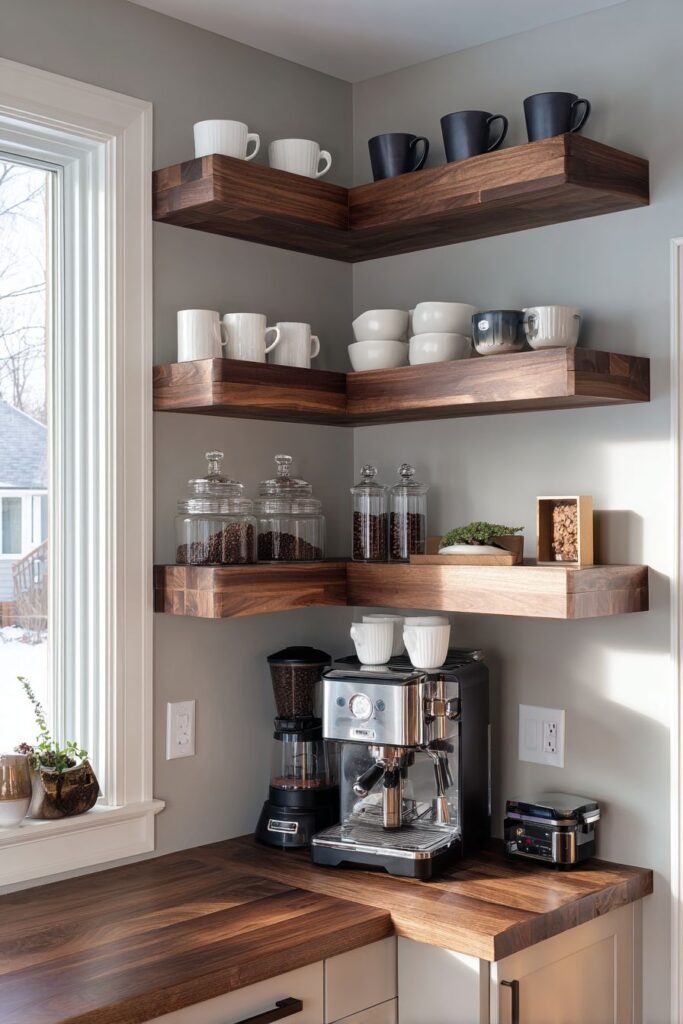
This dedicated coffee station represents a growing trend toward specialized zones within the kitchen. Rather than scattering coffee-related items throughout various cabinets and countertops, this approach creates a cohesive, beautiful, and highly functional area that elevates the daily coffee routine to something approaching ceremony.
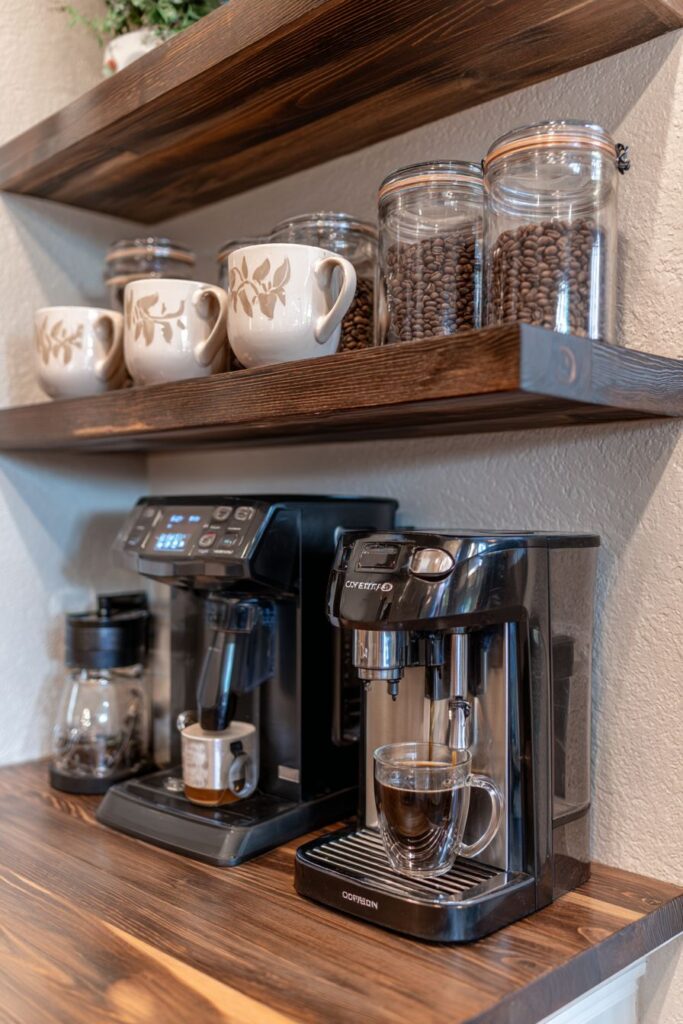
Key Design Tips:
- Create dedicated storage for each coffee-related item
- Use transparent containers to display beans and add visual interest
- Position the station near natural light for optimal morning ambiance
- Include adequate electrical outlets for multiple appliances
- Choose rich wood tones to add warmth and luxury to the space
5. Waterfall Edge Island Centerpiece
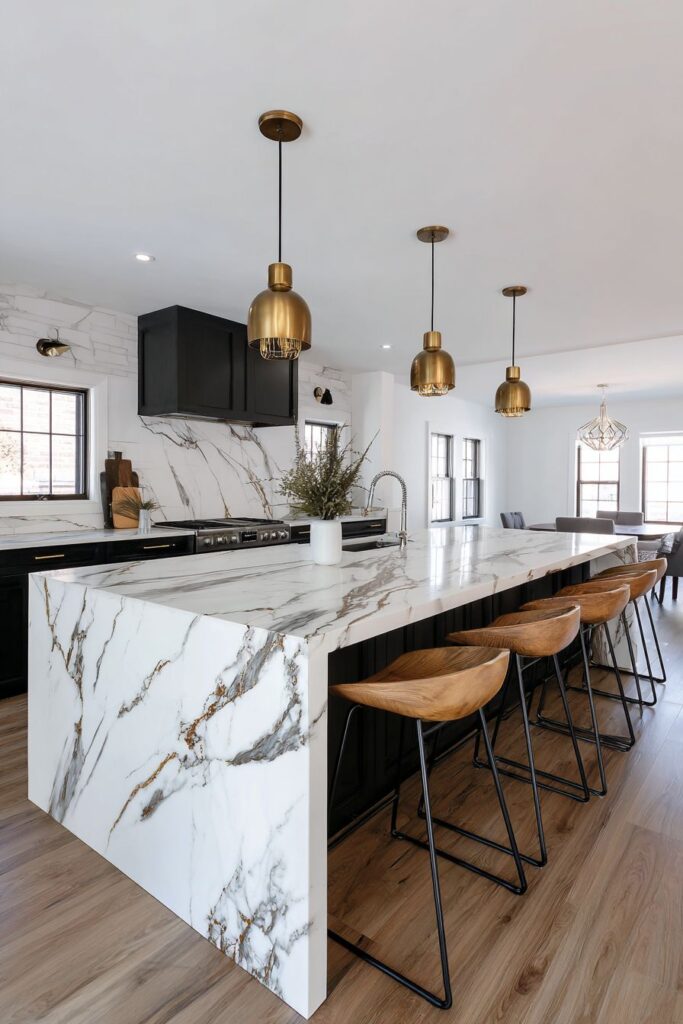
The kitchen island takes center stage in this design, featuring a dramatic waterfall edge quartz countertop in a stunning calacatta marble pattern. The continuous veining that flows over the edge creates a sense of movement and luxury that immediately draws the eye and establishes the island as the room’s focal point. This bold design choice demonstrates how a single material, when used dramatically, can transform the entire character of a space.
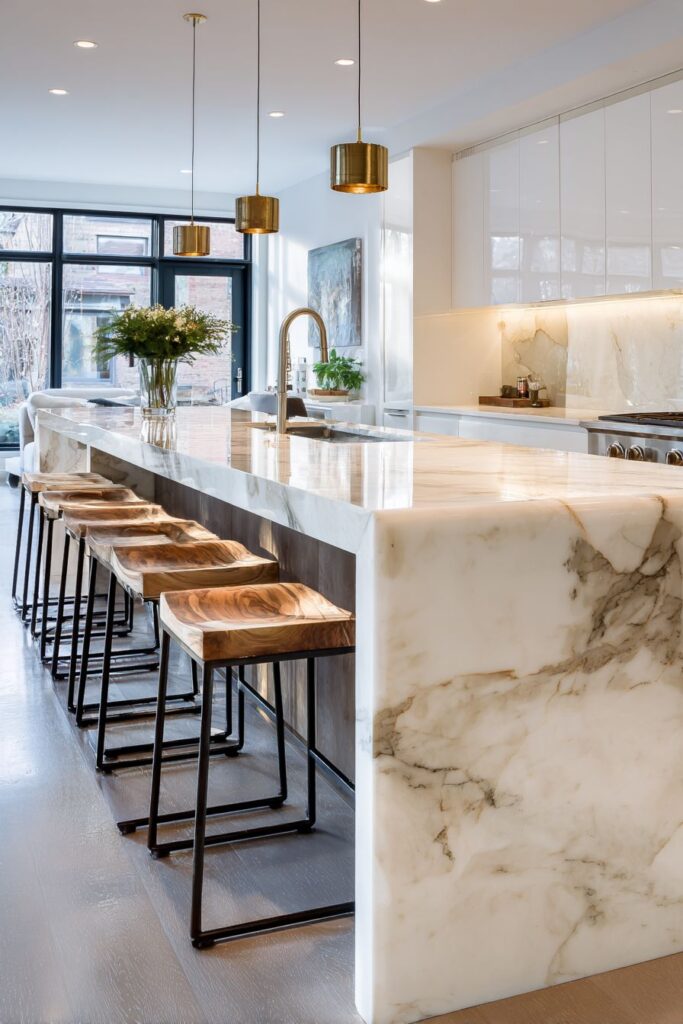
Natural oak bar stools with sleek black metal frames provide comfortable seating while maintaining the design’s sophisticated aesthetic. The contrast between the warm wood seats and cool metal frames creates visual interest while ensuring the stools complement rather than compete with the island’s dramatic stonework. The clean lines of the seating echo the contemporary feel of the waterfall countertop.
Brushed brass pendant lights hang at precisely the right height to provide task lighting without interfering with conversation or sight lines across the island. The warm metal finish adds a luxurious touch that complements the marble’s golden veining while providing necessary illumination for food preparation and casual dining. The spacing and scale of the fixtures create a perfect balance above the expansive island surface.
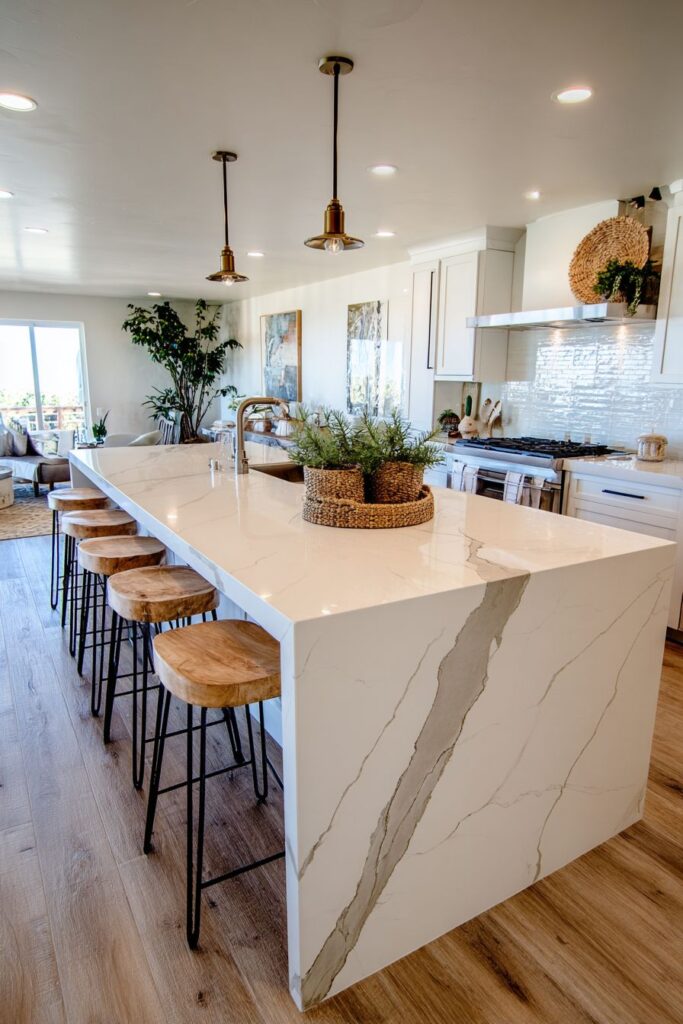
The waterfall edge detail represents the pinnacle of stone fabrication craftsmanship, requiring precise cutting and seamless joining to achieve the continuous pattern flow. This level of detail transforms functional furniture into sculptural art, creating a kitchen feature that serves as both workspace and conversation piece.
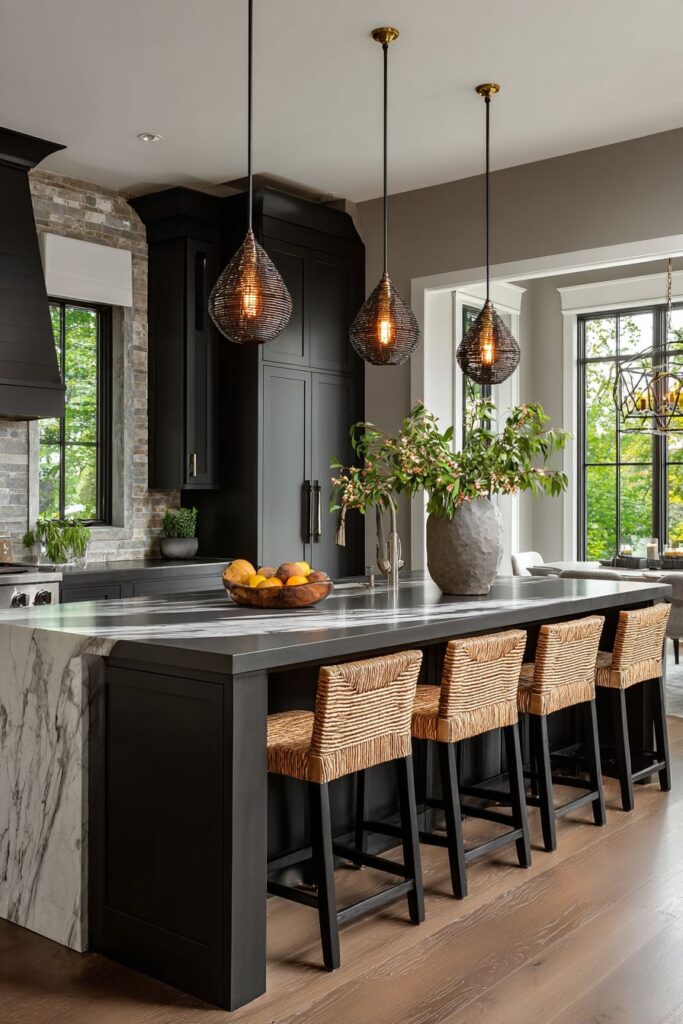
Key Design Tips:
- Book-match stone slabs to create continuous veining patterns
- Ensure pendant lights hang 30-36 inches above the counter surface
- Choose seating that complements without competing with the island design
- Plan electrical and plumbing carefully before stone installation
- Use consistent materials throughout to maintain design cohesion
6. Industrial Chic Exposed Elements
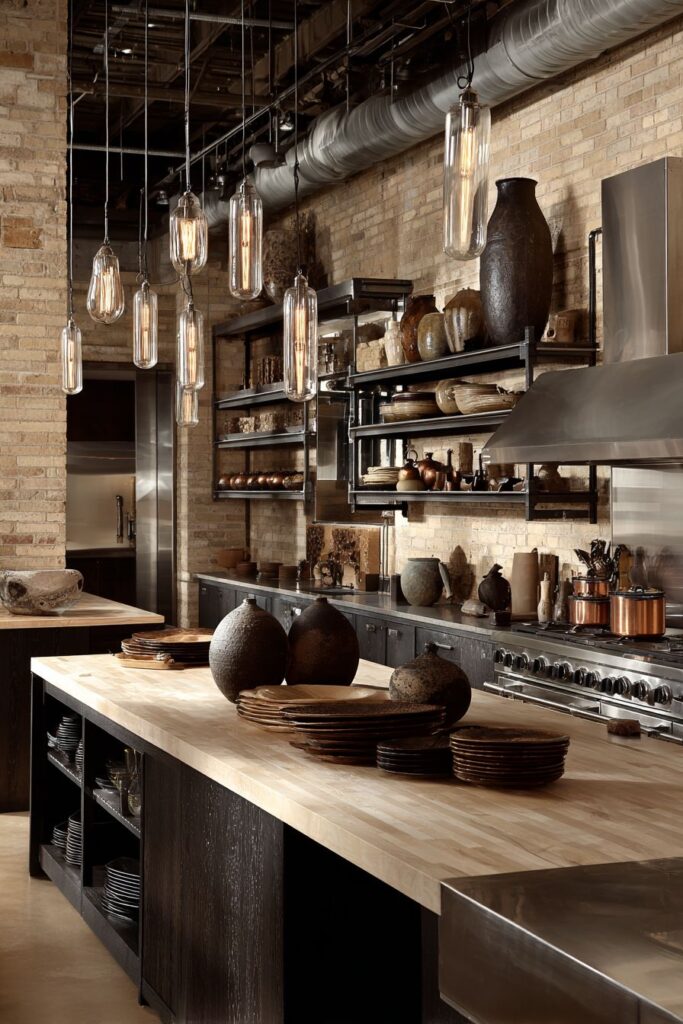
Raw industrial materials take center stage in this urban-inspired kitchen design, where exposed brick accent walls provide texture and character that no manufactured material can replicate. The weathered brick creates a dramatic backdrop for open metal shelving that displays an artisanal collection of ceramics and gleaming copper cookware. Each piece tells a story, creating a display that feels both intentional and effortlessly collected over time.
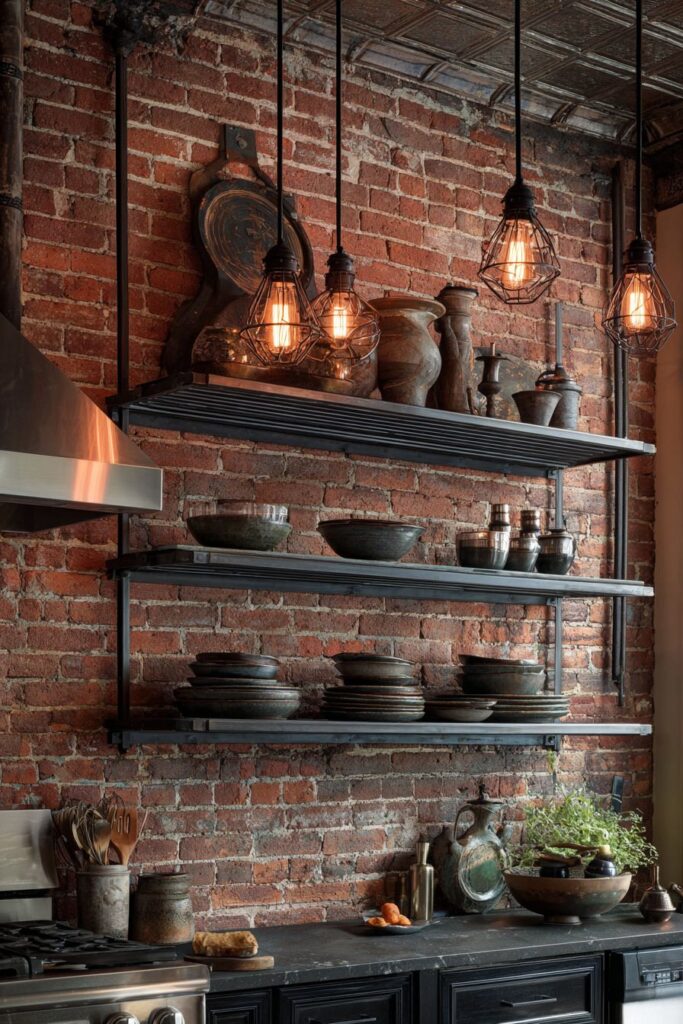
Edison bulb pendant lighting casts warm, golden light that enhances the brick’s natural texture while creating dramatic shadows that add depth and mystery to the space. The vintage-style bulbs complement the industrial aesthetic while providing a softer, more residential feel than harsh fluorescent lighting. The interplay between light and shadow transforms the raw materials into something approaching art.
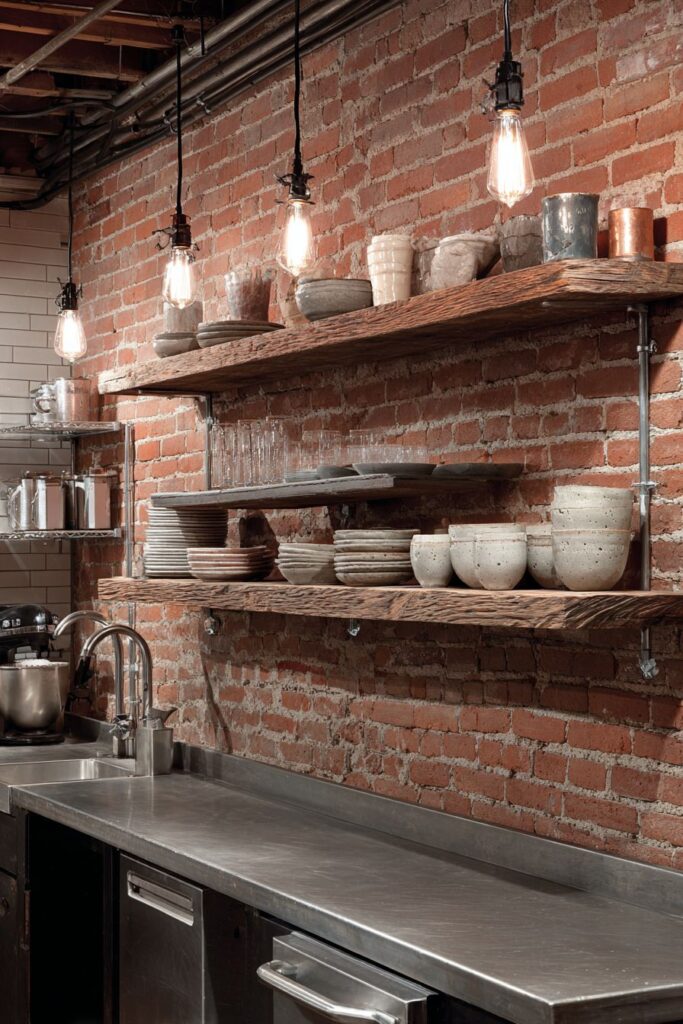
Stainless steel appliances integrate seamlessly with the urban aesthetic, their sleek surfaces providing a contemporary counterpoint to the aged brick and weathered metal. The professional-grade appliances suggest serious cooking capabilities while maintaining the space’s industrial credibility. The contrast between old and new materials creates a dynamic tension that keeps the design interesting and engaging.
This industrial kitchen design celebrates authenticity and craftsmanship, embracing materials in their natural state rather than hiding them behind decorative facades. The result is a space that feels honest and unpretentious while maintaining a sophisticated edge that appeals to contemporary sensibilities.
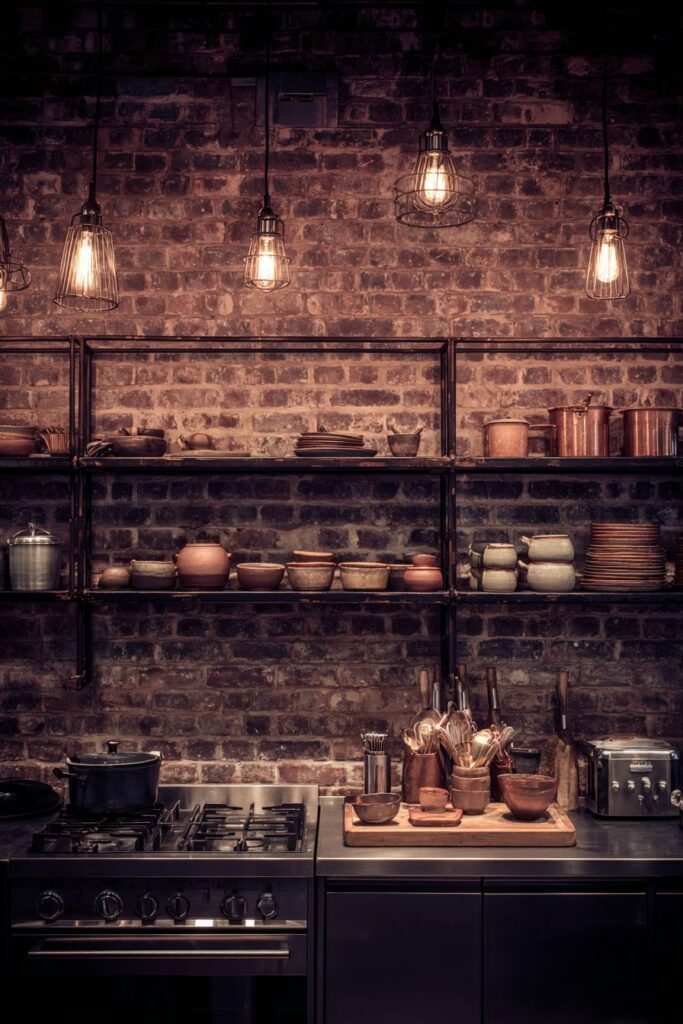
Key Design Tips:
- Preserve original brick texture by avoiding paint or sealers when possible
- Mix warm and cool metals for visual interest and authenticity
- Use Edison bulbs for ambient lighting that enhances industrial materials
- Display functional items as decoration to maintain the utilitarian aesthetic
- Balance raw materials with refined elements to maintain sophistication
7. Scandinavian Minimalist Serenity
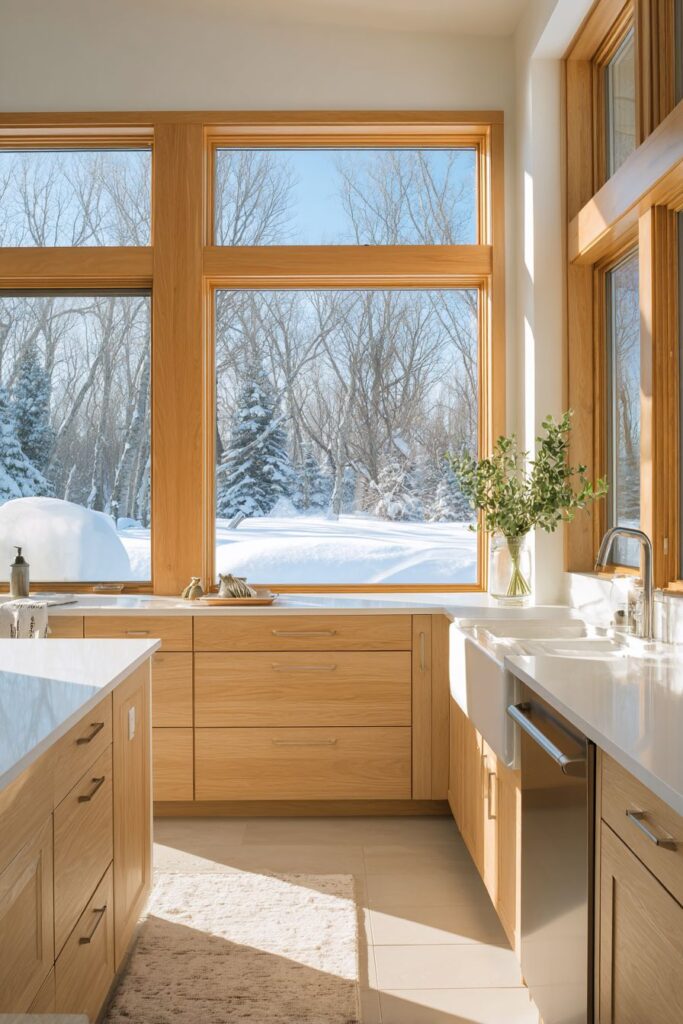
Light oak cabinets create a foundation of natural warmth in this Scandinavian-inspired kitchen, where every element serves a purpose and nothing is superfluous. The pale wood grain adds subtle texture and visual interest while maintaining the clean, uncluttered aesthetic that defines Nordic design. White quartz countertops provide pristine work surfaces that complement the light wood without competing for attention.
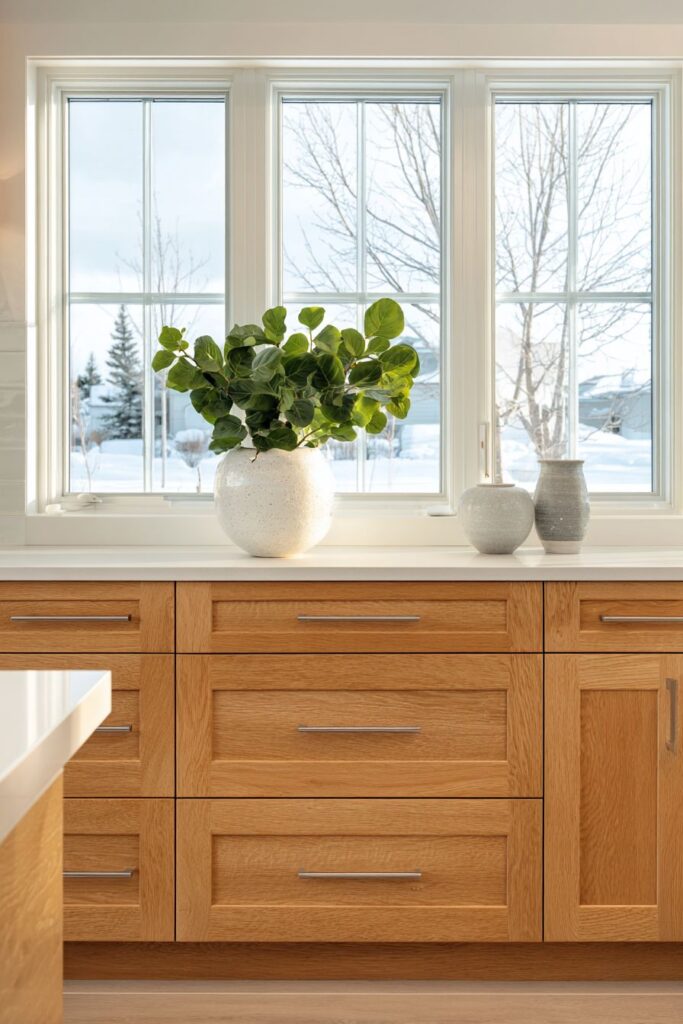
Minimal hardware in brushed stainless steel maintains the design’s restraint while providing necessary functionality. The simple, geometric shapes of the pulls and knobs echo the overall aesthetic philosophy, proving that even the smallest details contribute to the cohesive whole. A single green plant on the counter provides the only color accent needed, bringing life and freshness to the neutral palette.
Large windows without window treatments maximize natural light, creating the bright, airy atmosphere that Scandinavian design is famous for. The abundance of daylight makes the space feel larger and more connected to the outdoors, while eliminating the need for excessive artificial lighting during daylight hours. The clean window frames become part of the design, their simple lines reinforcing the minimalist aesthetic.
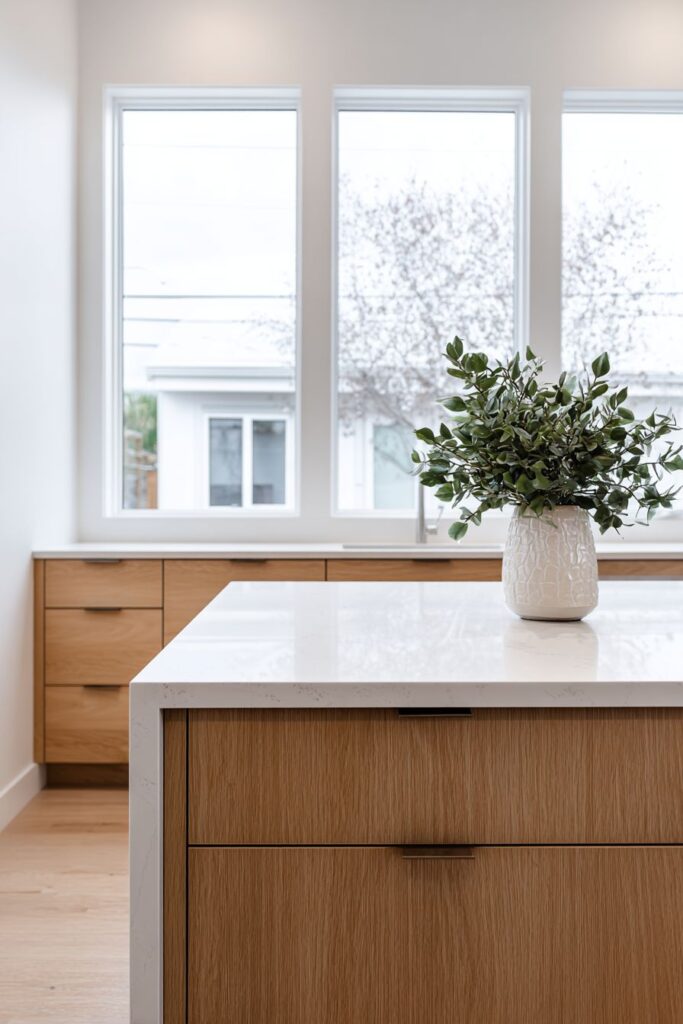
This approach to kitchen minimalism demonstrates that simplicity does not mean sacrificing functionality or beauty. Instead, it represents a thoughtful editing process that eliminates unnecessary elements while perfecting those that remain. The result is a space that feels calm, organized, and conducive to both cooking and contemplation.
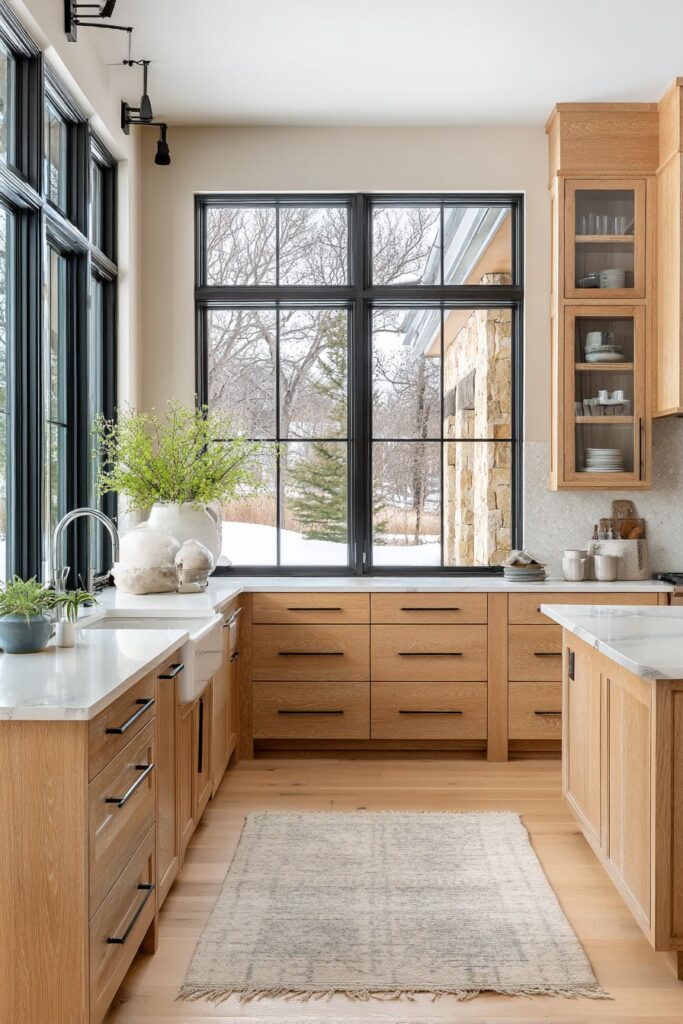
Key Design Tips:
- Choose light wood tones to maximize brightness in northern climates
- Limit color accents to natural elements like plants or fresh fruit
- Maximize natural light through strategic window placement and minimal treatments
- Select hardware with clean, geometric shapes that complement the overall aesthetic
- Maintain clutter-free surfaces to preserve the minimalist atmosphere
8. Vintage Farmhouse Sink Charm
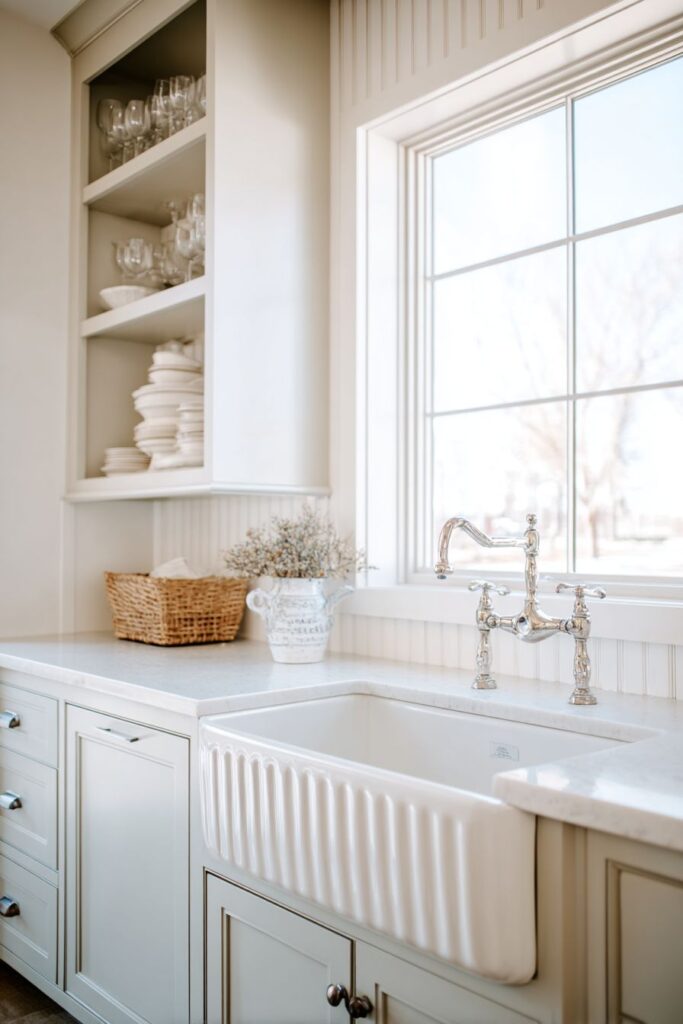
An apron front farmhouse sink becomes the centerpiece of this vintage-inspired kitchen design, its generous proportions and classic lines immediately establishing the space’s character. The bridge faucet in polished nickel finish adds period-appropriate detail while providing modern functionality. The substantial presence of the sink creates a focal point that anchors the entire design scheme.
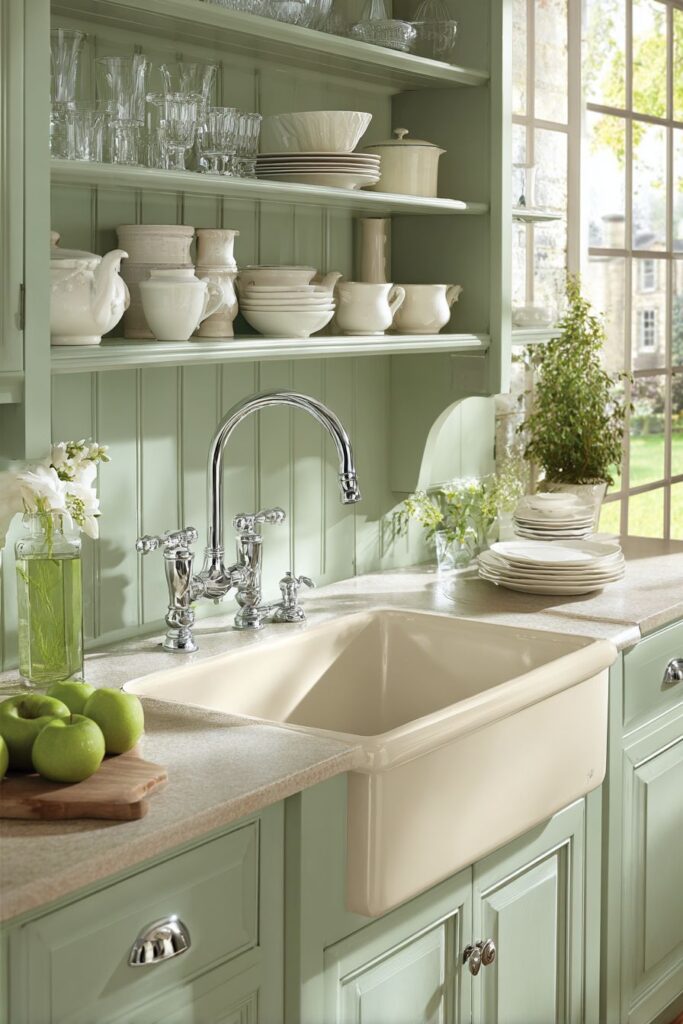
Surrounding cabinetry features beadboard details painted in soft sage green, a color choice that feels both fresh and timeless. The vertical lines of the beadboard add texture and visual interest while maintaining the cottage-style aesthetic. Open shelving displays white ironstone dishes and vintage glassware, creating storage that doubles as decoration and adds to the authentic farmhouse feeling.
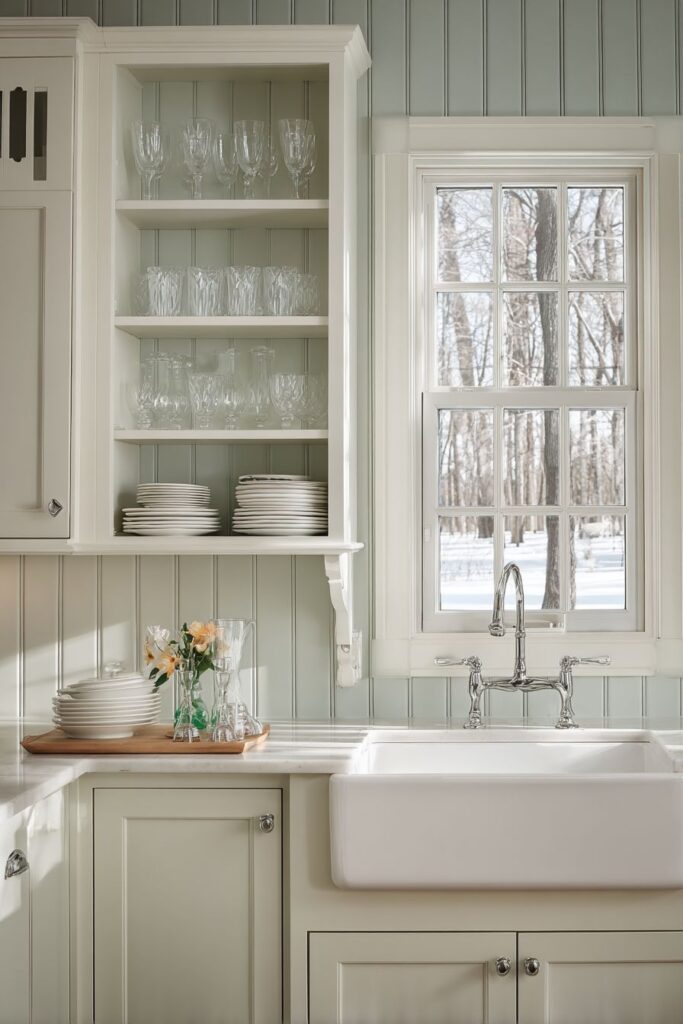
Natural light from nearby windows creates gentle highlights on the ceramic sink’s surface, emphasizing its handcrafted quality and substantial presence. The interplay of light and shadow throughout the day transforms the sink area into a dynamic focal point that changes character as the sun moves across the sky. The positioning near the window also provides pleasant views during dishwashing and food preparation tasks.
This farmhouse kitchen design celebrates traditional craftsmanship and timeless materials while incorporating modern conveniences. The vintage-inspired elements create a sense of history and permanence that makes the kitchen feel like it has evolved naturally over time rather than being installed all at once.
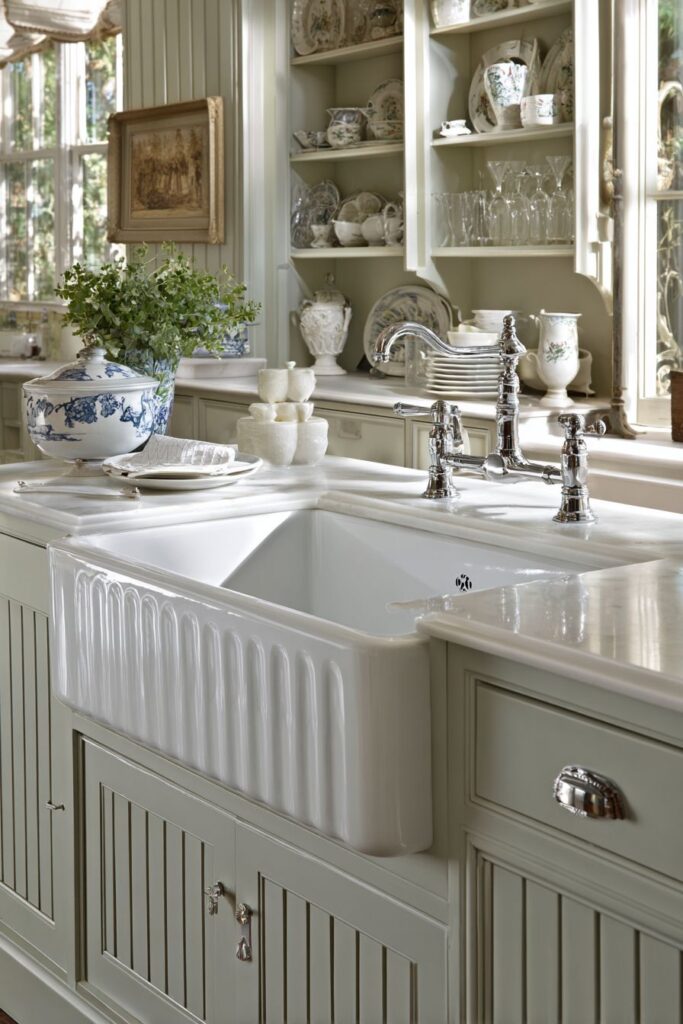
Key Design Tips:
- Choose sink proportions that complement the overall kitchen scale
- Select cabinet colors that feel authentic to the farmhouse period
- Display vintage dishes and glassware to enhance the period aesthetic
- Position the sink near natural light for both function and beauty
- Use period-appropriate hardware and fixtures for authenticity
9. Mediterranean Mosaic Elegance
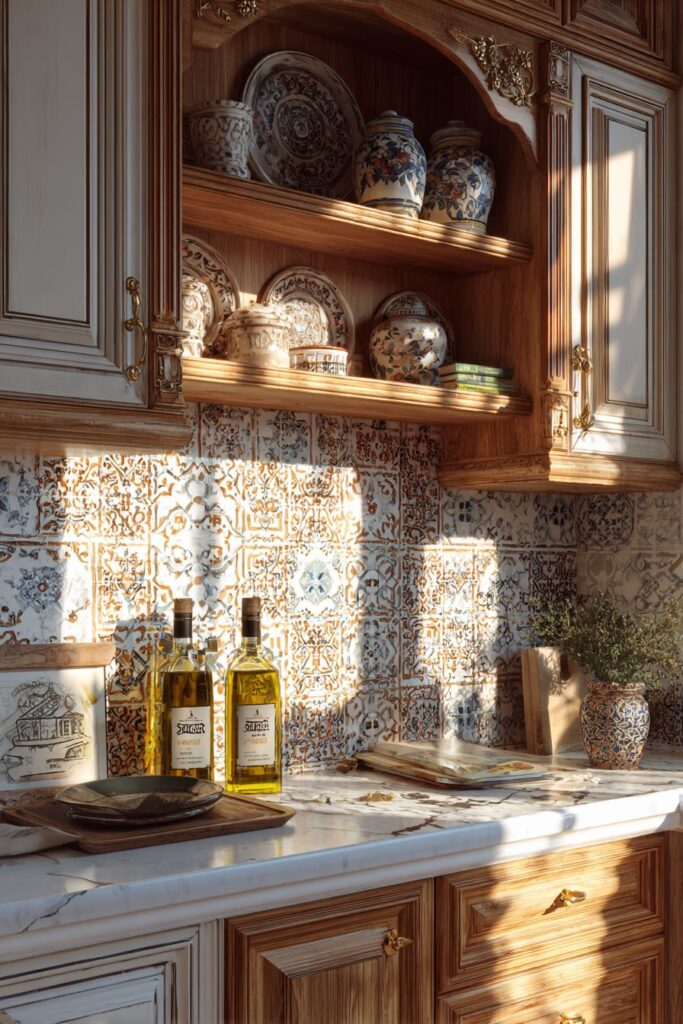
Warm earth tones of terracotta, cream, and gold come together in a stunning mosaic tile backsplash that transports the senses to the sun-drenched coastlines of the Mediterranean. Each small tile contributes to a larger pattern that creates movement and visual interest while maintaining the organic, handcrafted quality that defines authentic Mediterranean design. The varied tones and subtle irregularities speak to traditional tile-making techniques.
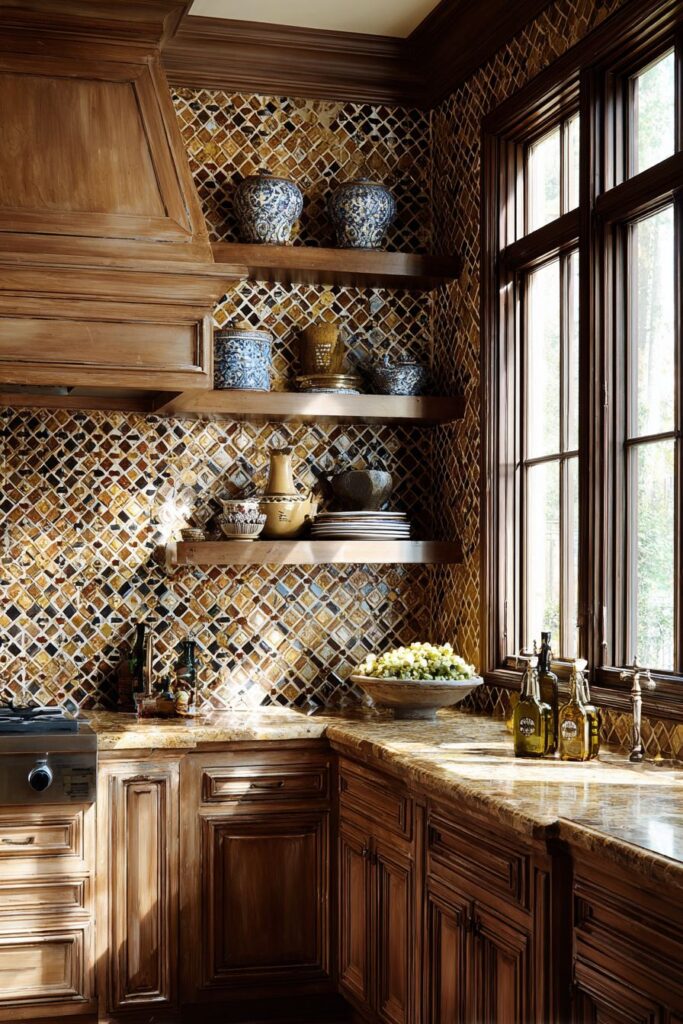
Hand-painted ceramic accessories and olive oil bottles create an authentic display on open shelving, their organic shapes and artisanal glazes complementing the mosaic’s handcrafted aesthetic. These functional items serve as decoration while reinforcing the Mediterranean theme through their traditional forms and warm colors. The combination of textures creates a rich, layered appearance that rewards close examination.
Warm wood cabinets with traditional raised panel doors provide a substantial foundation for the design while maintaining the region’s preference for natural materials. The wood’s honey tones echo the golden elements in the mosaic while providing necessary storage in an attractive, traditionally styled package. The panel details add architectural interest without overwhelming the space.
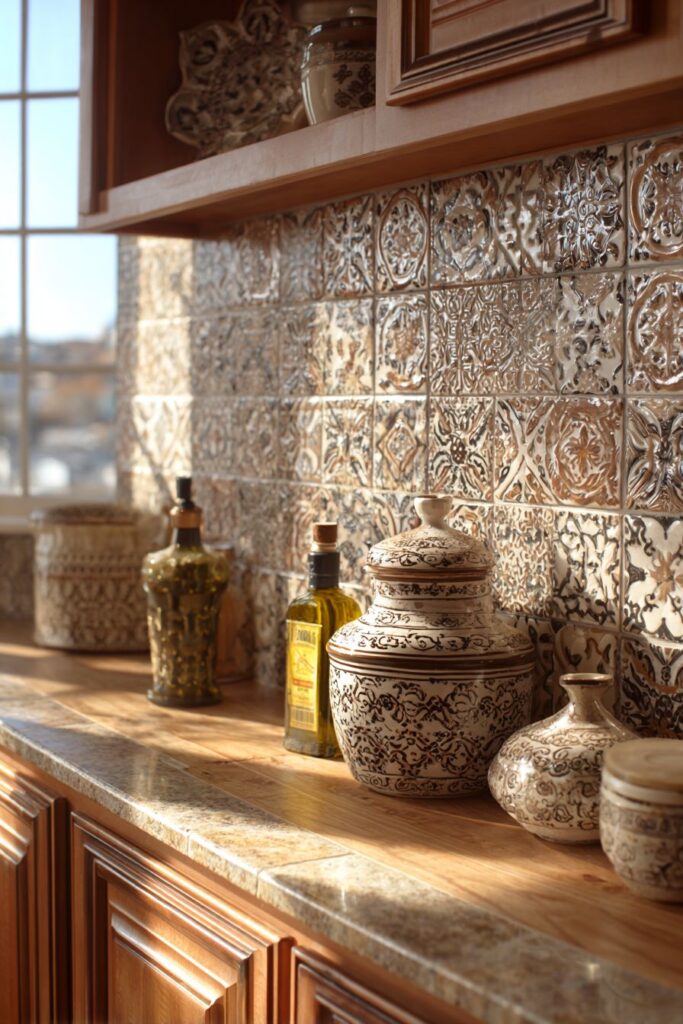
Golden hour lighting transforms this kitchen into a warm, inviting space that captures the essence of Mediterranean living. As sunlight filters through windows, it highlights the mosaic’s varied surfaces and creates the kind of warm, dappled light that makes everything look more beautiful. The overall effect is one of relaxed elegance and connection to traditional crafts.
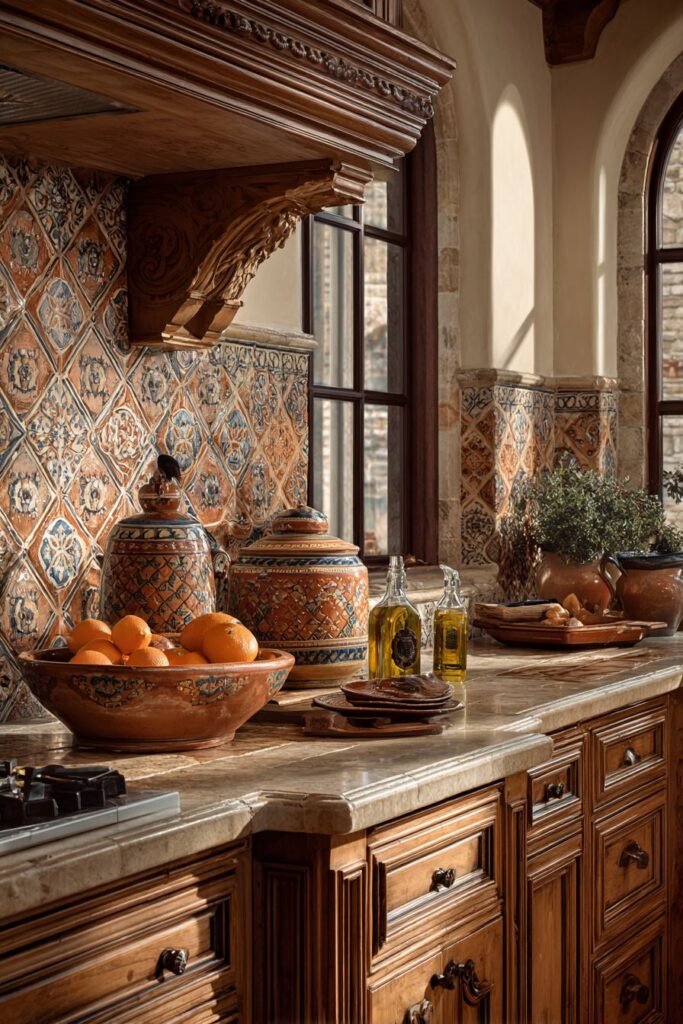
Key Design Tips:
- Choose mosaic tiles with subtle color variations for authentic handmade appeal
- Display traditional ceramics and vessels to reinforce the regional aesthetic
- Use warm wood tones that complement the earth-tone tile palette
- Position lighting to enhance the mosaic’s texture and depth
- Include functional items like olive oil bottles as decorative elements
10. Smart Storage Solutions Showcase
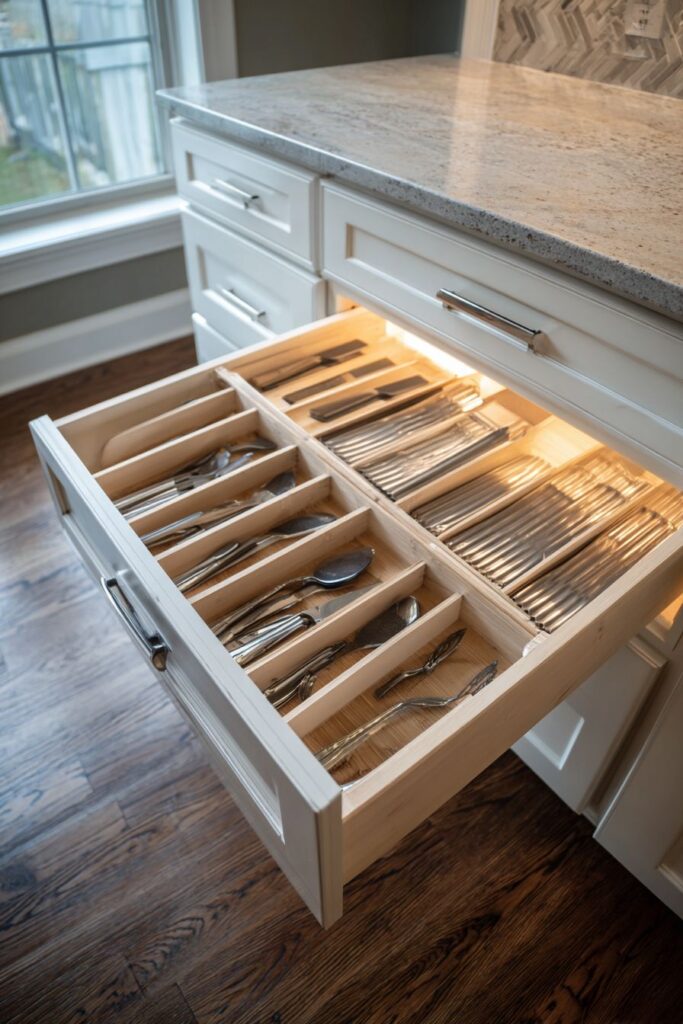
Organization becomes an art form in this intelligently designed kitchen where every inch of storage space is optimized for both function and beauty. Pull-out drawer organizers, spice rack inserts, and vertical dividers for baking sheets transform chaotic cabinets into models of efficiency. Clean white cabinetry with soft-close mechanisms provides a sophisticated backdrop for these organizational systems.
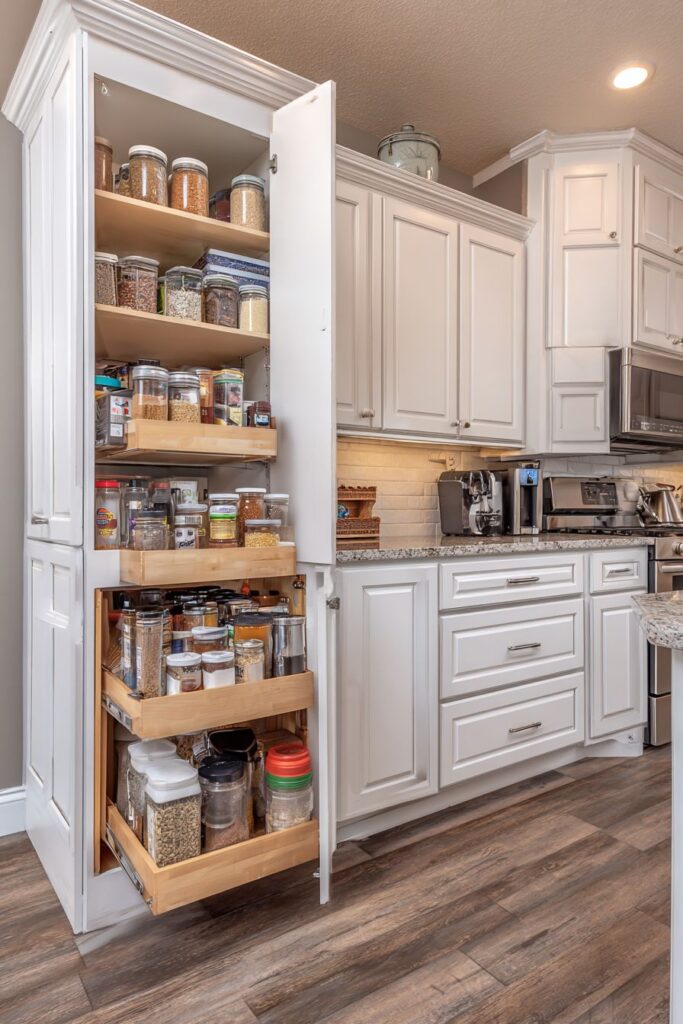
Internal LED lighting reveals the organized interior when cabinet doors open, creating a jewel-box effect that makes finding items easy while adding a touch of luxury to everyday tasks. The lighting transforms practical storage into something approaching exhibition quality, proving that organization can be beautiful as well as functional. Each compartment becomes clearly defined and easily accessible.
The thoughtful placement of every organizational element demonstrates how proper planning can dramatically improve kitchen functionality. Spices are arranged at eye level for easy identification, while pull-out drawers bring items from the back of deep cabinets to the front where they can be easily accessed. Vertical dividers keep baking sheets and cutting boards organized and prevent the avalanche effect common in deep cabinets.
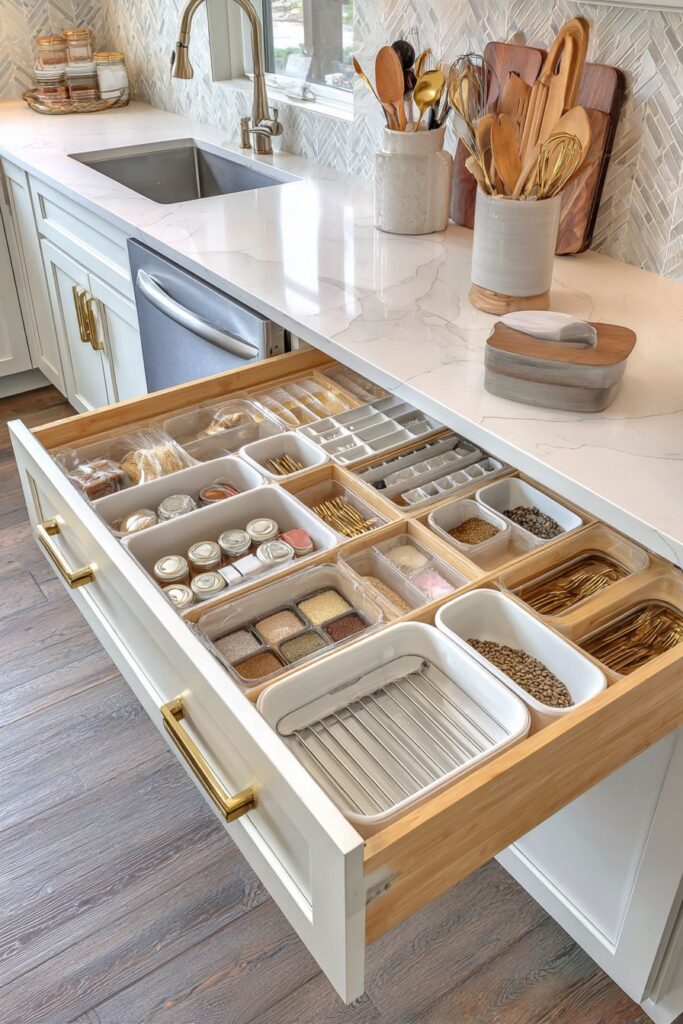
This approach to kitchen organization proves that beautiful design and practical function are not mutually exclusive. The clean lines and sophisticated finishes create a visually appealing environment while the smart storage solutions make cooking and meal preparation more enjoyable and efficient.
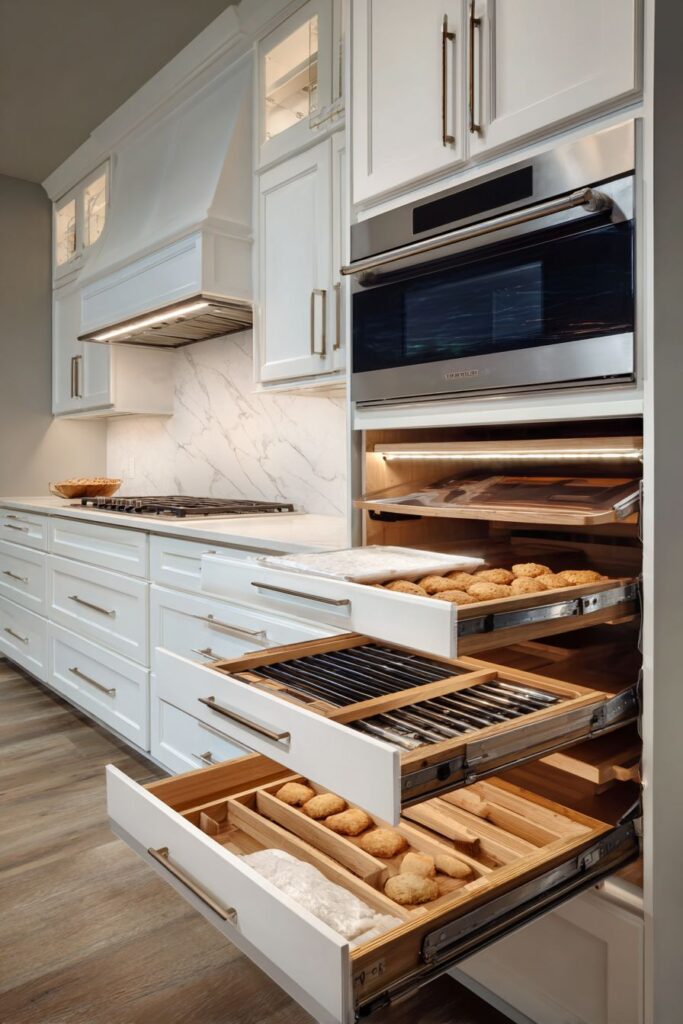
Key Design Tips:
- Install pull-out organizers in deep cabinets for easy access to back items
- Use vertical dividers to prevent stacking and improve organization
- Include internal LED lighting to illuminate cabinet contents
- Choose soft-close mechanisms for a luxurious, quiet operation
- Plan storage solutions during the design phase for optimal integration
11. Classic Black and White Drama
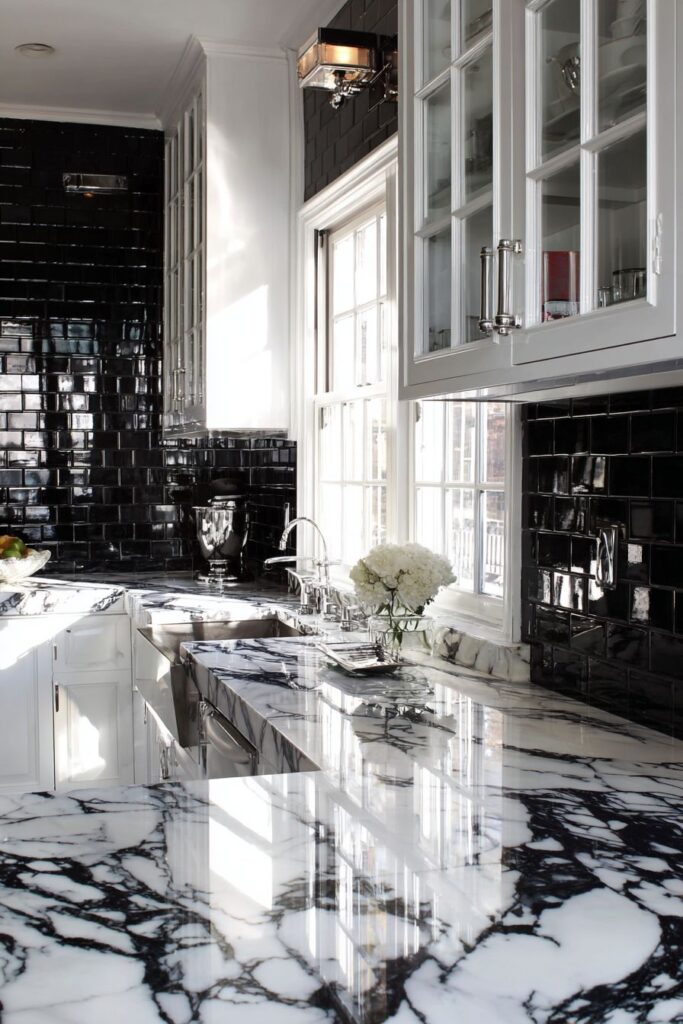
Bold contrasts create a stunning visual impact in this sophisticated black and white kitchen design. Glossy black subway tile creates a dramatic backsplash that challenges traditional expectations while maintaining the classic appeal of the subway pattern. The high-gloss finish reflects light and adds depth to the dark surface, preventing it from feeling heavy or oppressive.
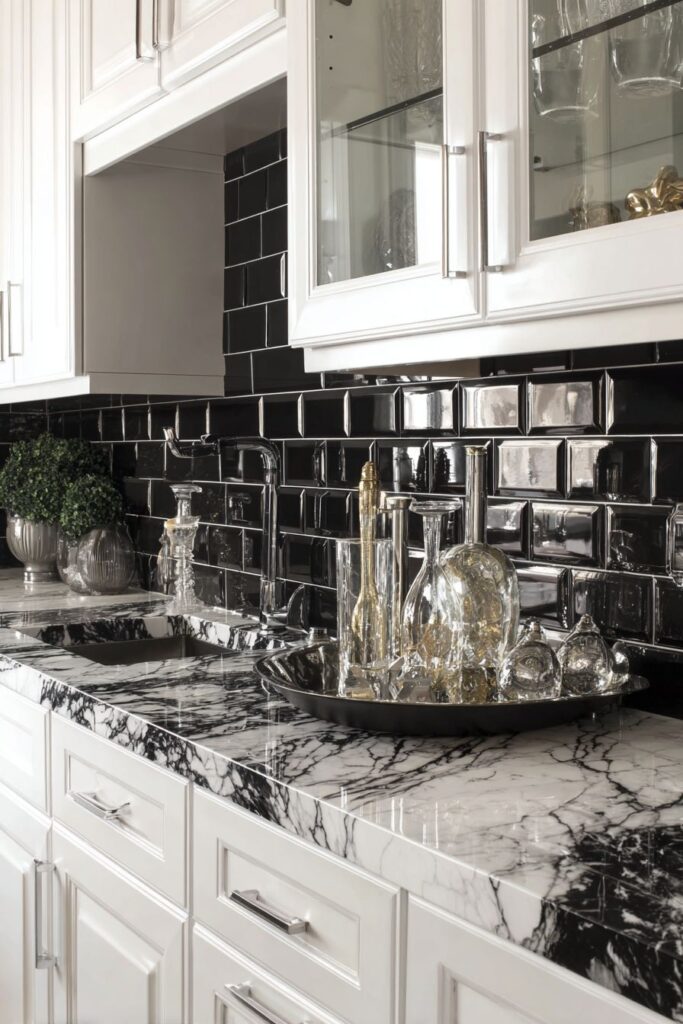
White cabinetry provides a crisp contrast that makes the black tiles appear even more dramatic while maintaining balance in the overall design. Marble countertops with bold black veining create visual interest and tie the two primary colors together through natural stone’s organic patterns. The veining provides movement and life to what could otherwise be a stark color scheme.
Chrome hardware and fixtures maintain the monochromatic palette while adding reflective surfaces that enhance the play of light throughout the space. The polished metal surfaces create additional contrast points while maintaining the sophisticated, graphic quality of the overall design. Each element reinforces the bold simplicity of the black and white theme.
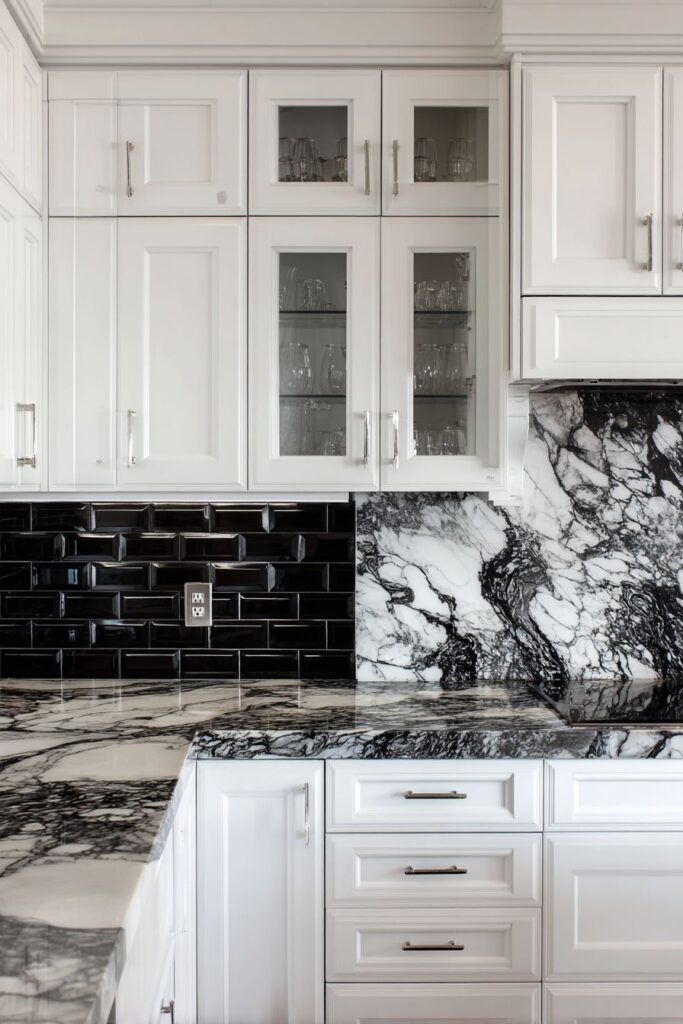
This monochromatic kitchen design demonstrates how limiting the color palette can actually create more visual impact rather than less. The high contrast between elements creates drama and sophistication while the consistent material quality maintains elegance and refinement.
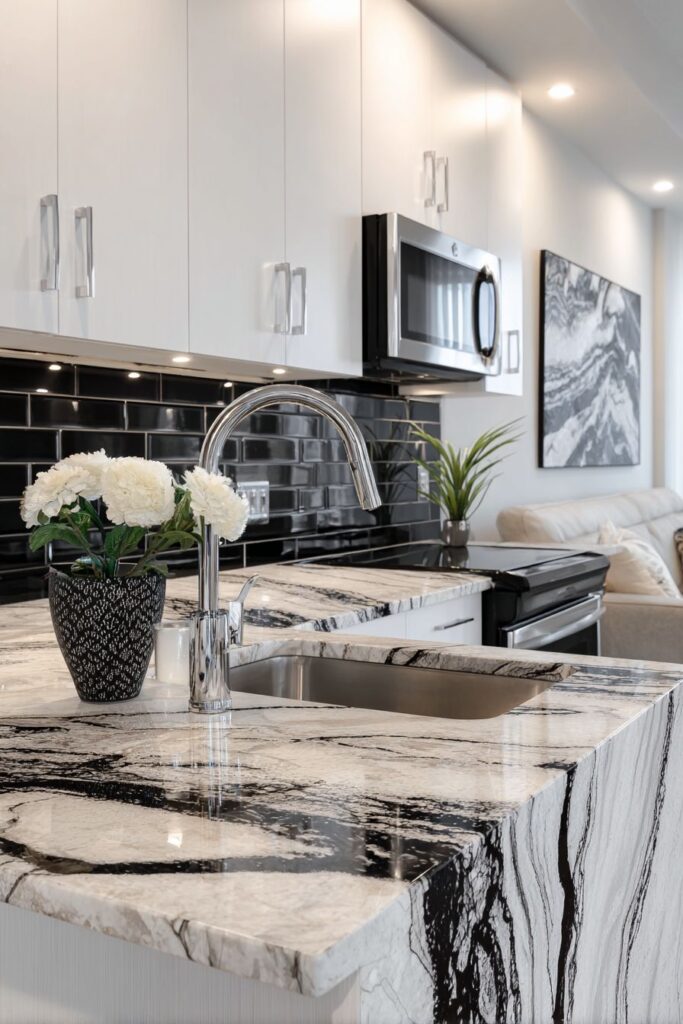
Key Design Tips:
- Use high-gloss finishes on dark surfaces to prevent them from absorbing too much light
- Balance dark elements with equal amounts of light surfaces
- Choose natural stone with veining that incorporates both primary colors
- Include reflective metal surfaces to add light and movement
- Maintain consistent quality in all materials to support the sophisticated aesthetic
12. Rustic Ceiling Beam Character
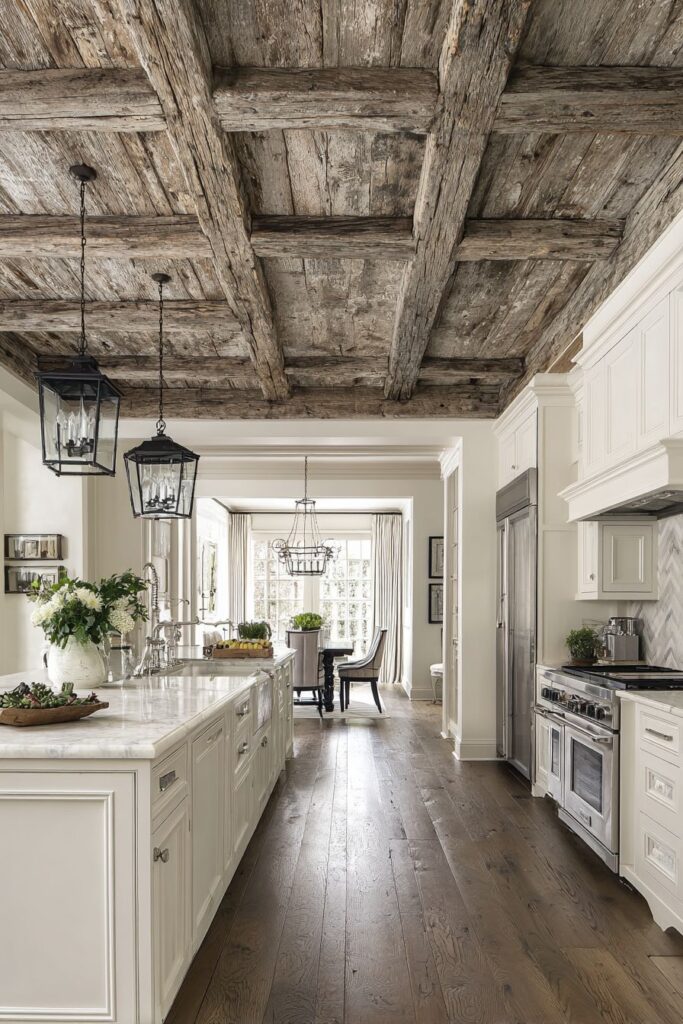
Reclaimed wood ceiling beams add architectural drama and rustic character to this modern kitchen, creating a striking contrast between old and new elements. The weathered timbers tell stories of their previous life while providing substantial visual weight that grounds the space and adds human scale to what might otherwise feel cold or impersonal. The natural imperfections and patina speak to authentic craftsmanship and sustainable design practices.
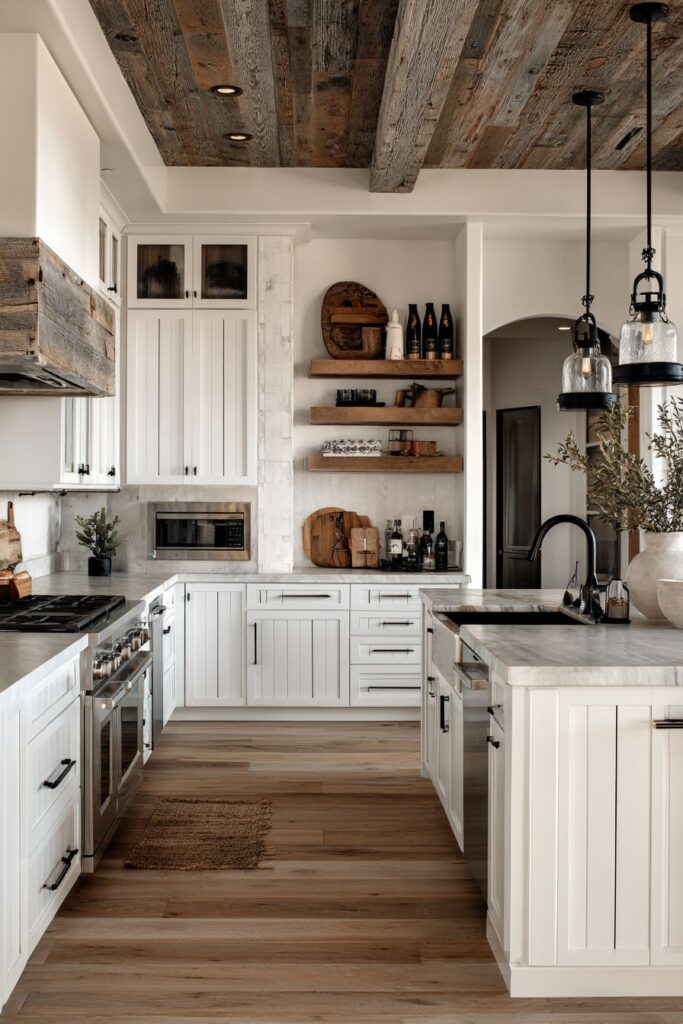
White cabinetry and stainless steel appliances create a clean, contemporary backdrop that allows the ceiling beams to take center stage without competing for attention. This strategic restraint in other design elements ensures that the dramatic ceiling treatment has maximum impact while maintaining overall balance in the space. The contrast between rustic and modern elements creates dynamic tension that keeps the design interesting.
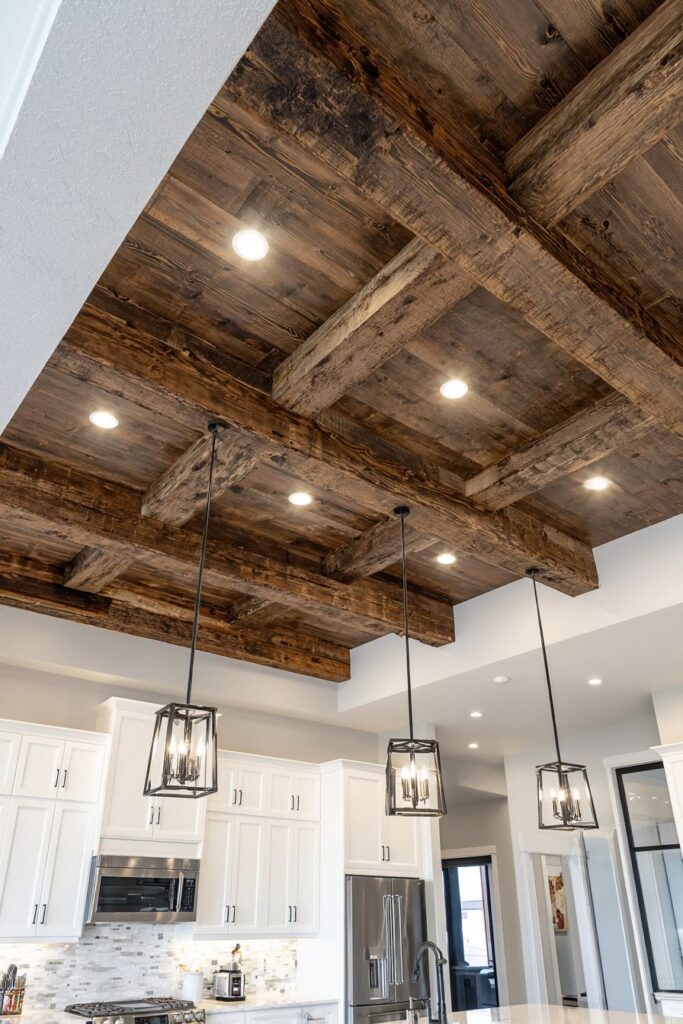
Pendant lighting with black metal shades hangs from the beams, integrating the lighting system with the architectural feature while providing necessary task illumination. The fixtures’ simple, industrial design complements both the rustic beams and contemporary cabinetry, serving as a bridge between the two design languages. The strategic placement ensures even lighting distribution across work surfaces.
This combination of rustic and modern elements demonstrates how seemingly contradictory design styles can work together when united by thoughtful planning and careful material selection. The result is a space that feels both grounded in tradition and thoroughly contemporary in its functionality.
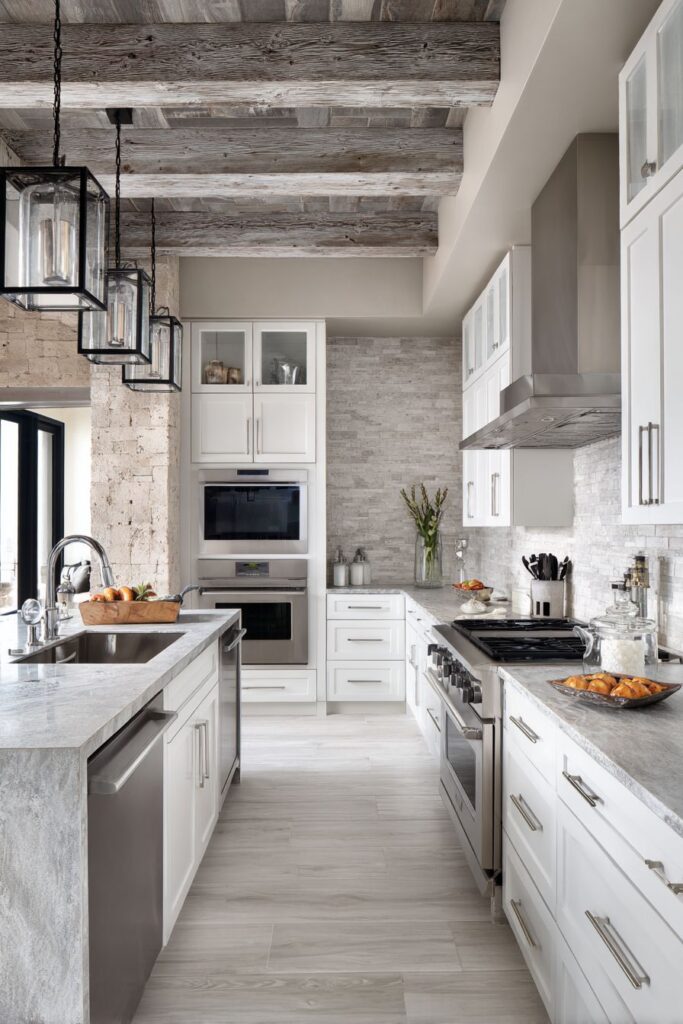
Key Design Tips:
- Source reclaimed beams with authentic weathering and character marks
- Keep other design elements simple to let the beams be the star
- Integrate lighting fixtures with the beam structure for cohesive design
- Ensure proper engineering support for the weight of reclaimed timbers
- Consider beam spacing carefully to maintain proper proportions
13. Portuguese Azulejo Tile Artistry
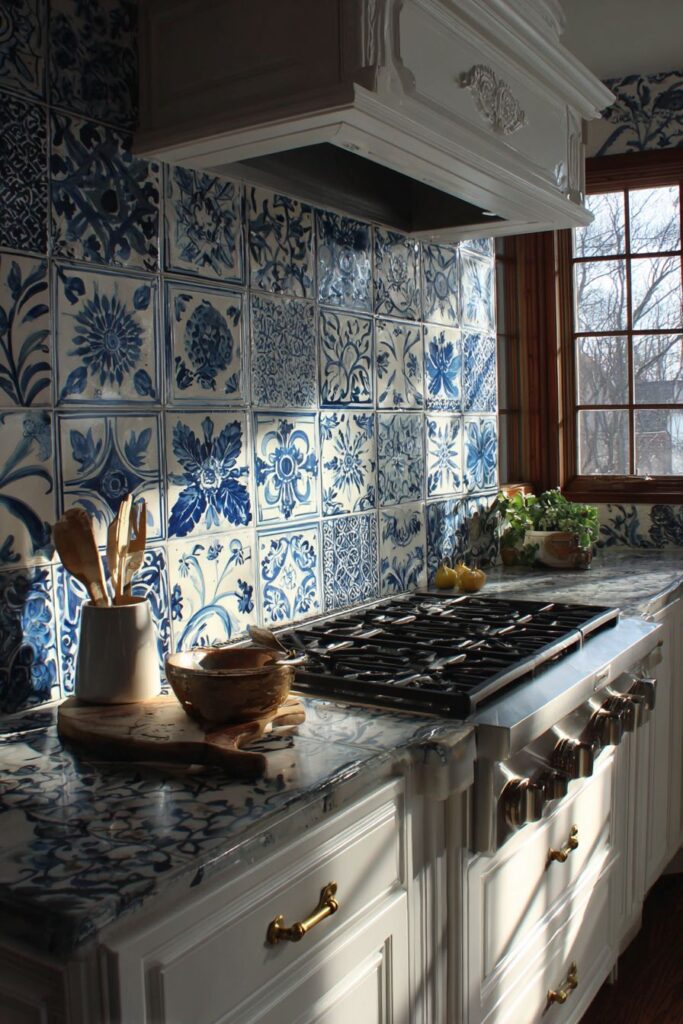
Hand-painted Portuguese azulejo tiles in traditional blue and white botanical patterns create a stunning focal point that brings centuries of ceramic artistry into contemporary kitchen design. Each tile represents individual craftsmanship, with subtle variations in brushstrokes and glazing that speak to the human hand behind the creation. The intricate botanical motifs create a garden-like quality that brings nature indoors.
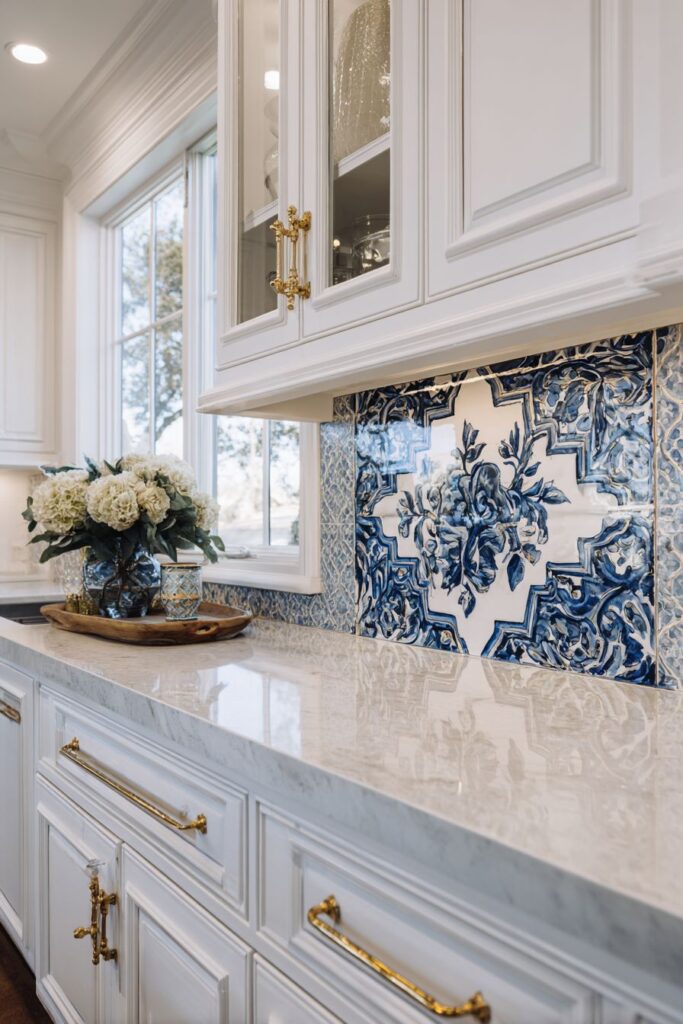
Simple white cabinetry provides the perfect neutral backdrop, allowing the decorative tiles to command attention without visual competition. This restraint demonstrates sophisticated design judgment, proving that sometimes the best approach is to let one beautiful element shine while keeping everything else quietly supportive. The clean lines of the cabinetry provide modern functionality while respecting traditional aesthetics.
Brass hardware adds warmth that complements the blue and white tile palette while introducing a metallic element that enhances the traditional Portuguese aesthetic. The warm metal finish echoes the golden glazes often found in traditional ceramics while providing a luxurious touch that elevates the overall design. Each brass element becomes a small jewel against the white cabinetry.
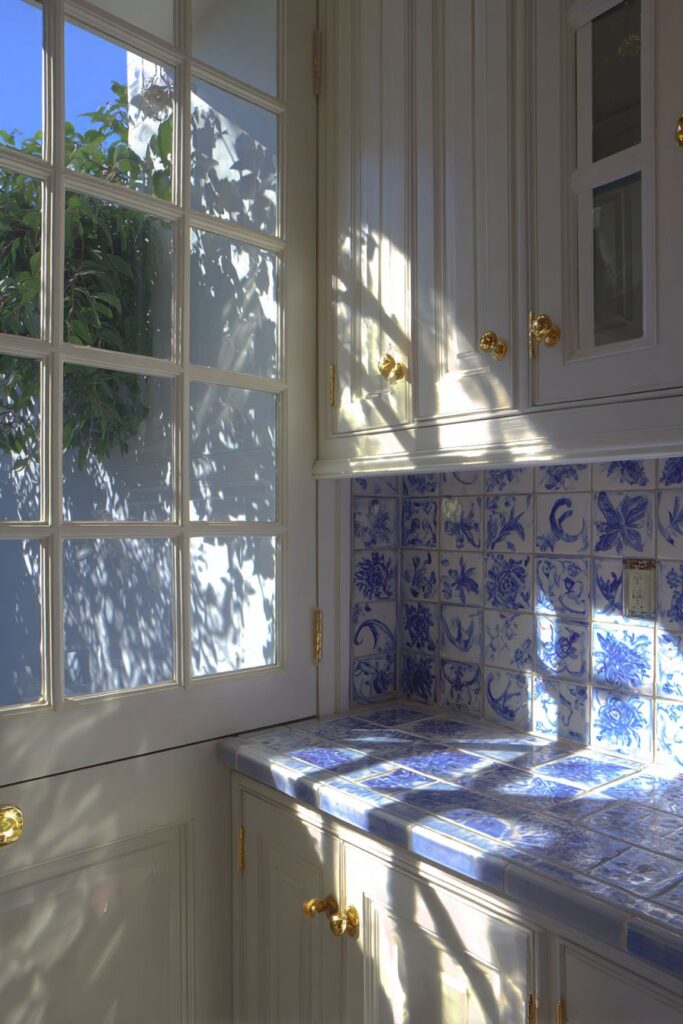
Natural daylight showcases the intricate tile details and authentic glazing techniques, revealing the depth and complexity that only hand-painted ceramics can achieve. The changing light throughout the day creates different moods and highlights various aspects of the tile patterns, ensuring that the backsplash remains interesting and dynamic throughout all hours.
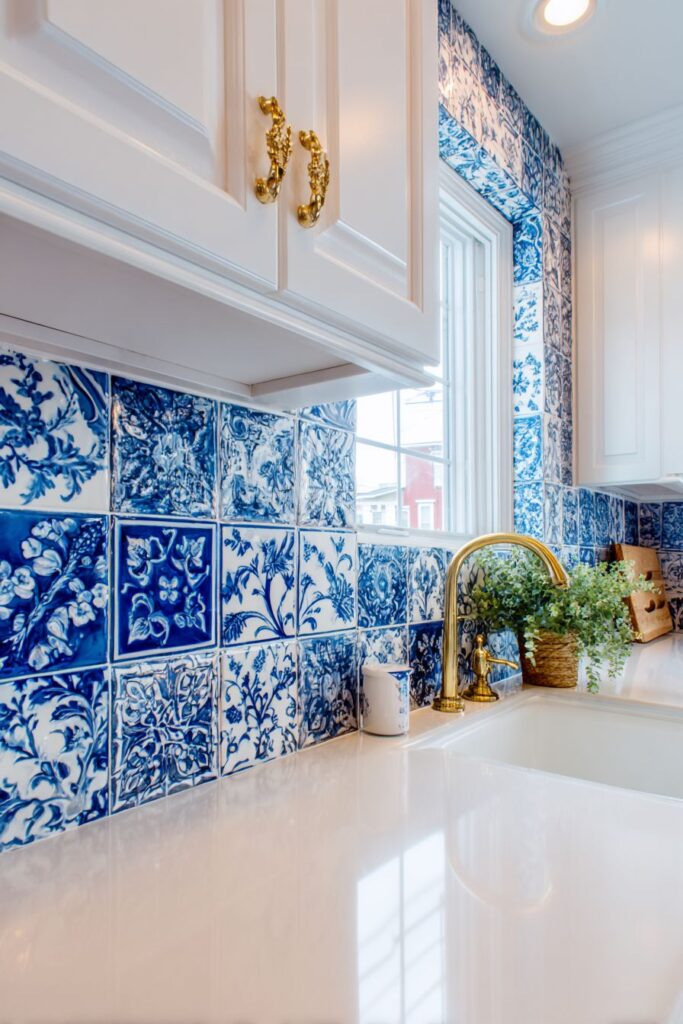
Key Design Tips:
- Choose authentic hand-painted tiles for genuine character and variation
- Use white or neutral cabinetry to showcase decorative tile patterns
- Include warm metallic hardware to complement traditional blue and white palettes
- Position tiles where natural light can highlight their handcrafted details
- Consider the tile pattern’s scale in relation to the overall kitchen proportions
14. Butler’s Pantry Elegance
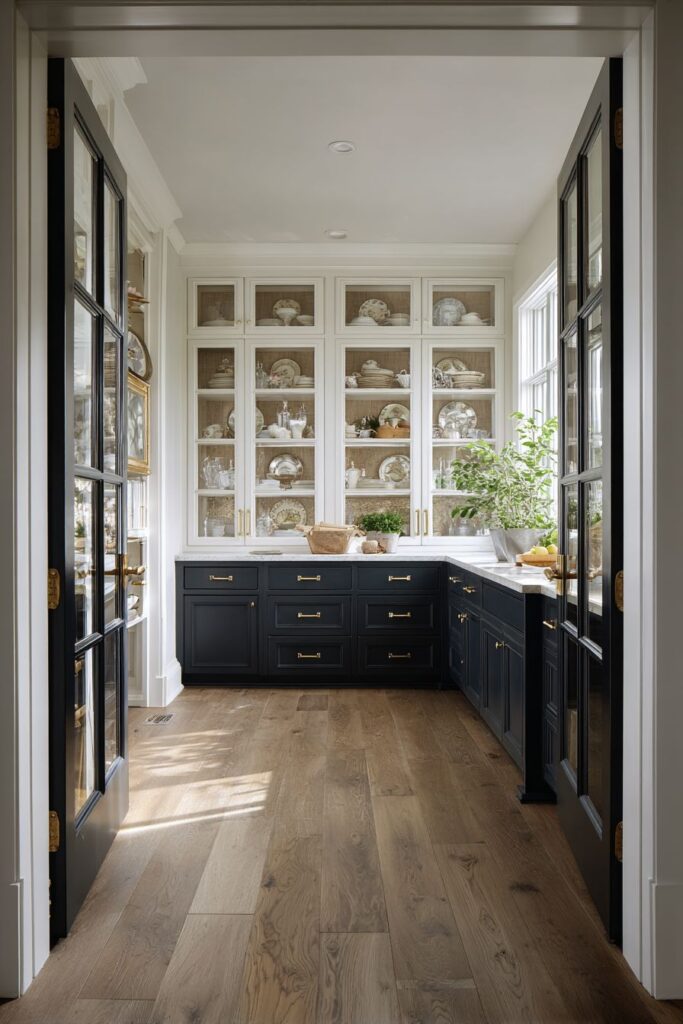
Floor-to-ceiling built-in cabinetry transforms storage into architectural beauty in this sophisticated butler’s pantry design. Glass-front upper cabinets create display opportunities for fine china and crystal glassware while maintaining protection from dust and damage. The combination of display and concealed storage creates a room that is both highly functional and visually stunning.
Dark navy paint on lower cabinets creates dramatic contrast with white upper cabinets, establishing visual weight at the base while maintaining lightness above. This two-tone approach adds sophistication and prevents the space from feeling too uniform or monotonous. The navy blue adds richness and depth while the white maintains brightness and spaciousness.
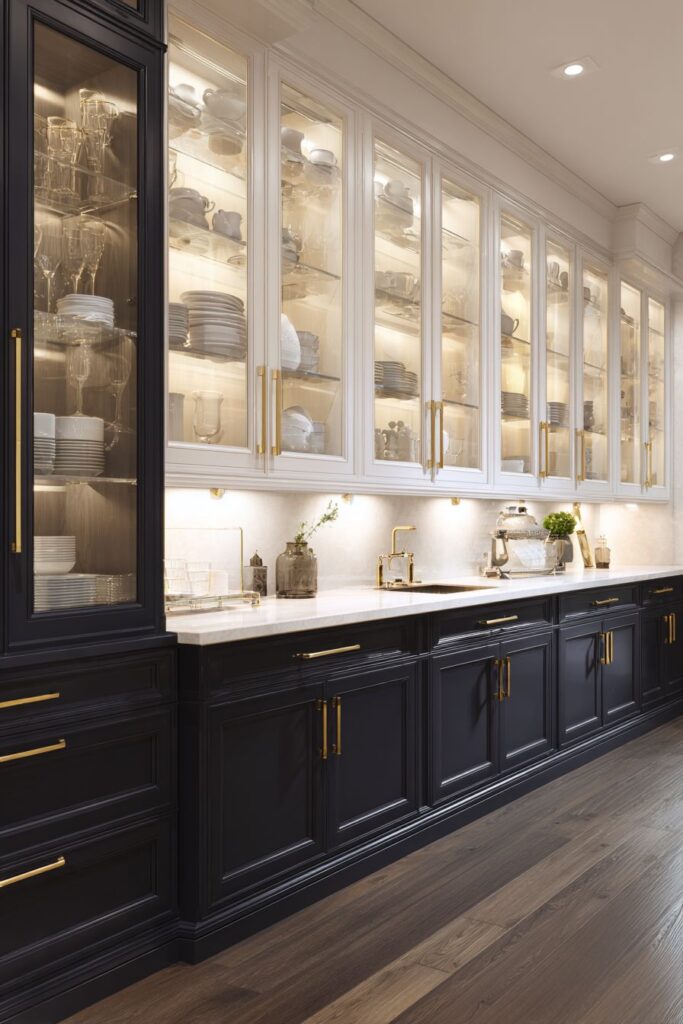
Brass hardware and interior cabinet lighting create an elegant storage solution that rivals the finest retail displays. The warm metallic finish adds luxury while the interior lighting transforms practical storage into attractive presentation. When cabinet doors open, the illuminated interior creates a jewel-box effect that makes even everyday items appear special.
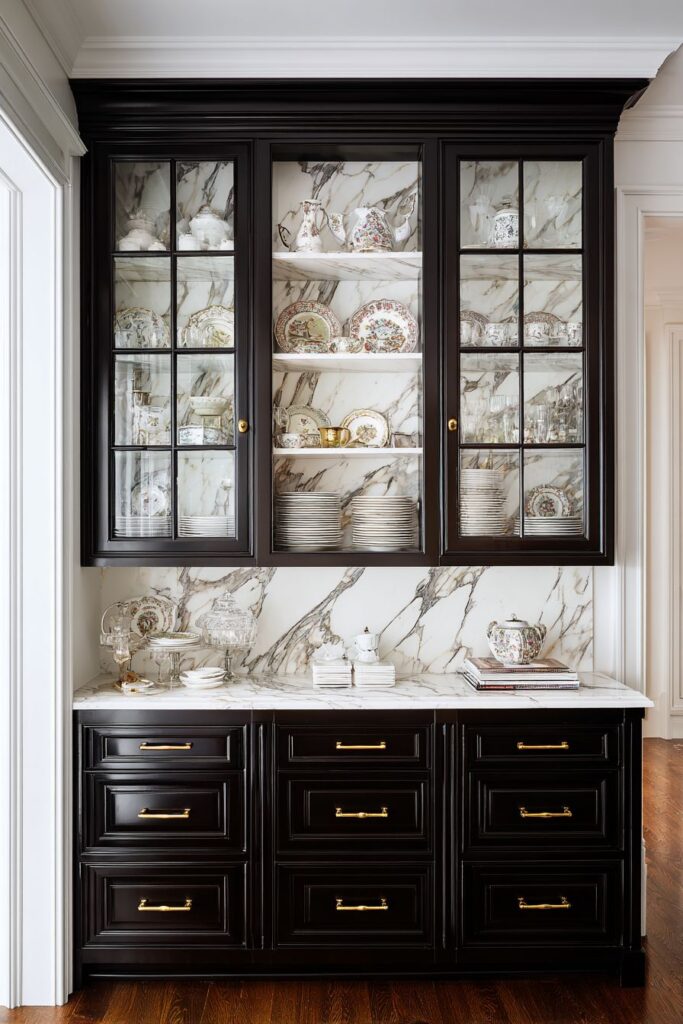
This butler’s pantry design represents a return to the sophisticated service areas of grand homes, adapted for contemporary living. The combination of beautiful materials, thoughtful lighting, and expert craftsmanship creates a space that makes organization and storage a pleasure rather than a chore.
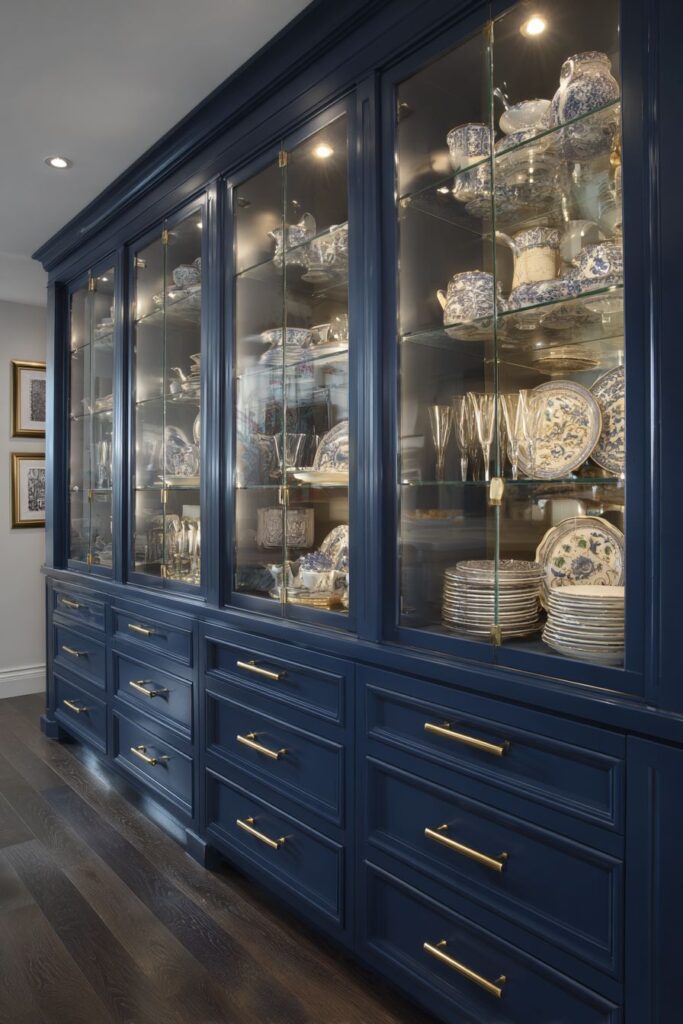
Key Design Tips:
- Use glass-front cabinets for items worthy of display
- Create visual weight with darker colors on lower cabinets
- Install interior lighting to showcase cabinet contents
- Choose brass hardware for warmth and traditional elegance
- Plan electrical during construction for optimal lighting placement
15. Custom Range Hood Integration
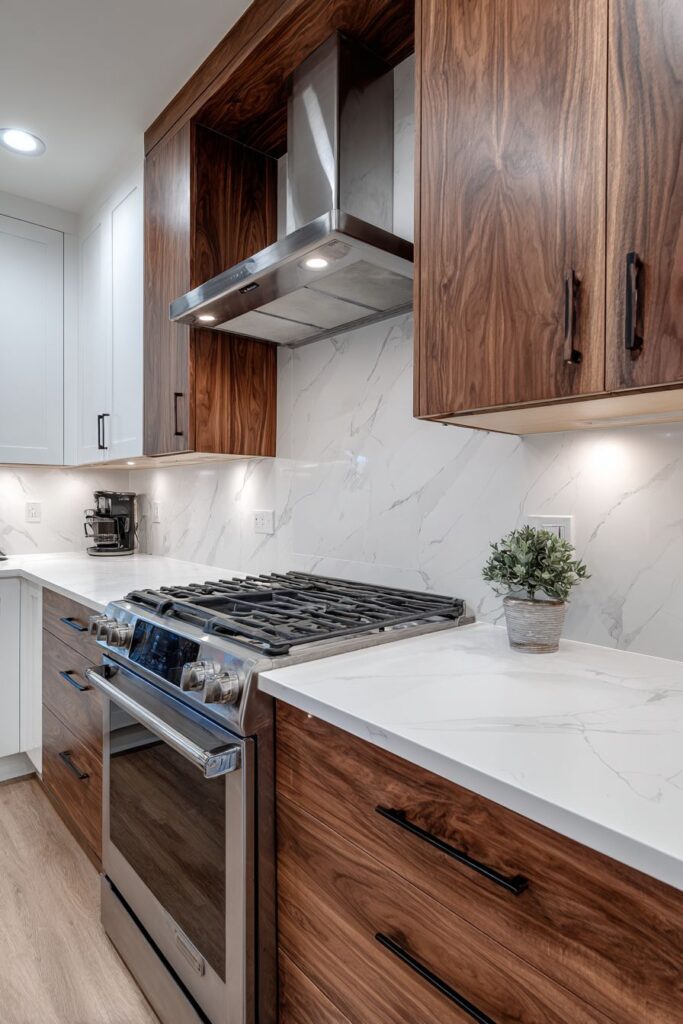
A custom wood surround transforms a functional range hood into a seamless design element that blends perfectly with surrounding cabinetry. Integrated spice storage niches demonstrate how practical needs can be incorporated into architectural features without compromising aesthetics. The craftsmanship required to achieve this level of integration represents the pinnacle of custom kitchen design.
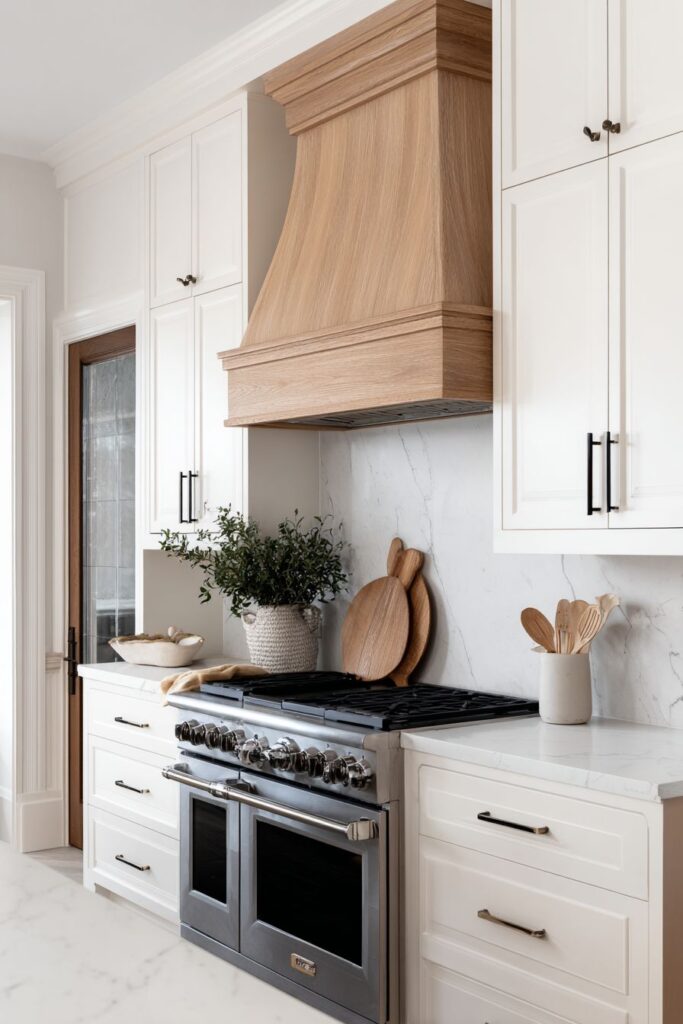
The hood design provides necessary ventilation while maintaining the kitchen’s clean aesthetic lines. Rather than treating the range hood as an appliance to be hidden or minimized, this approach embraces it as an opportunity for architectural expression. The custom millwork creates a focal point that draws attention for all the right reasons.
Stainless steel appliances and white countertops maintain a clean backdrop that allows the custom millwork to shine without visual competition. The neutral palette ensures that the range hood’s architectural details remain the focus while providing a sophisticated foundation for the entire design. The integration of materials creates a cohesive, built-in appearance.
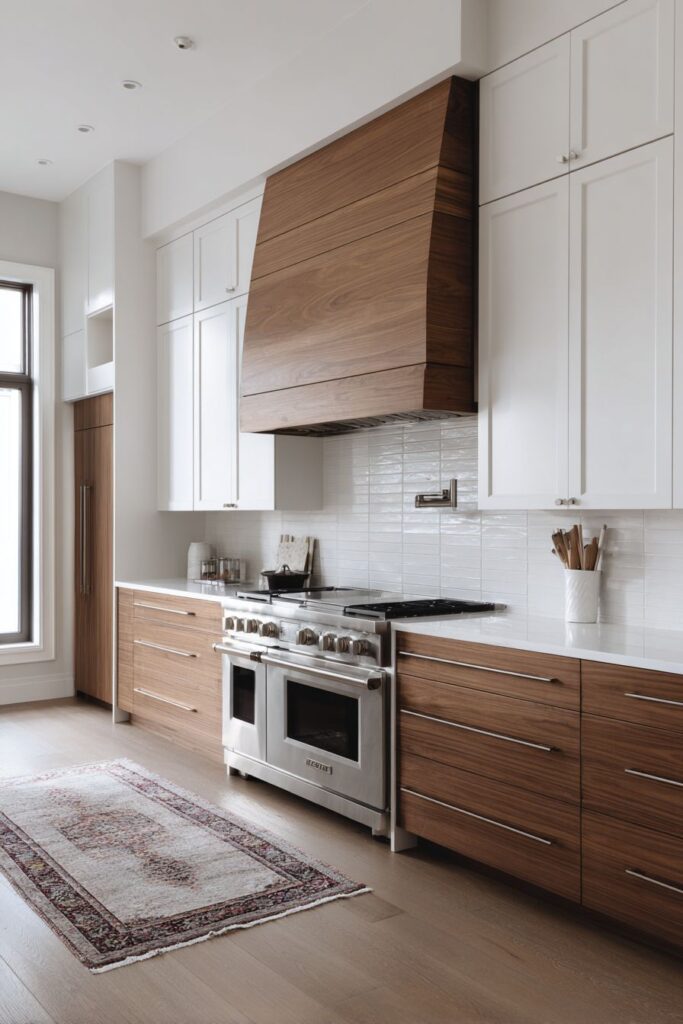
Detail-focused craftsmanship in the custom millwork demonstrates how thoughtful design can solve multiple problems simultaneously. The spice storage provides convenient access during cooking while the wood surround creates architectural interest and conceals mechanical elements. This level of integration requires careful planning but results in a truly custom appearance.
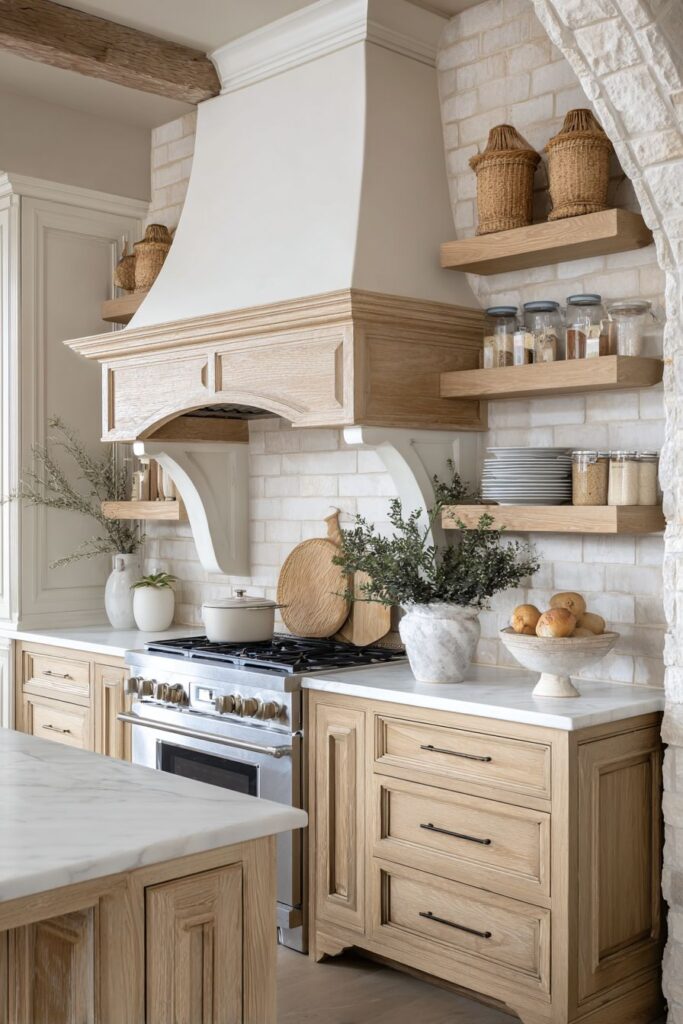
Key Design Tips:
- Plan ventilation requirements early in the design process
- Integrate storage into architectural elements for maximum efficiency
- Match millwork details to surrounding cabinetry for seamless appearance
- Consider maintenance access when designing custom surrounds
- Use contrasting materials strategically to highlight custom work
16. Cozy Breakfast Nook Haven
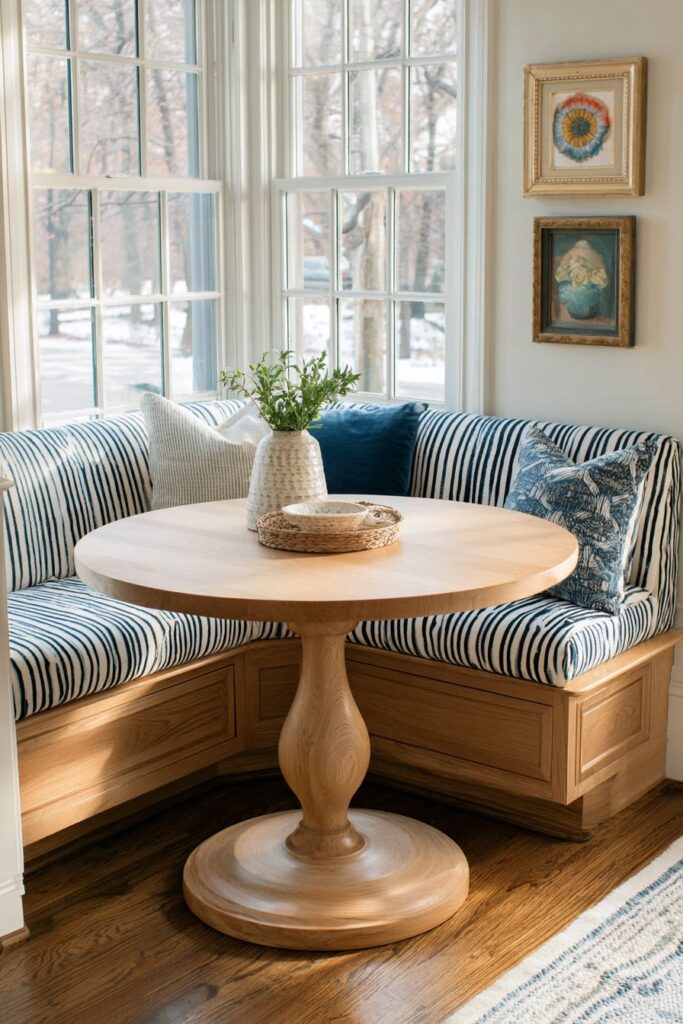
Built-in banquette seating with striped navy and white cushions creates an intimate dining area that feels both casual and sophisticated. The built-in approach maximizes seating capacity while creating clean lines that integrate seamlessly with the kitchen design. The navy and white stripes add pattern and visual interest while maintaining a timeless, nautical-inspired aesthetic.
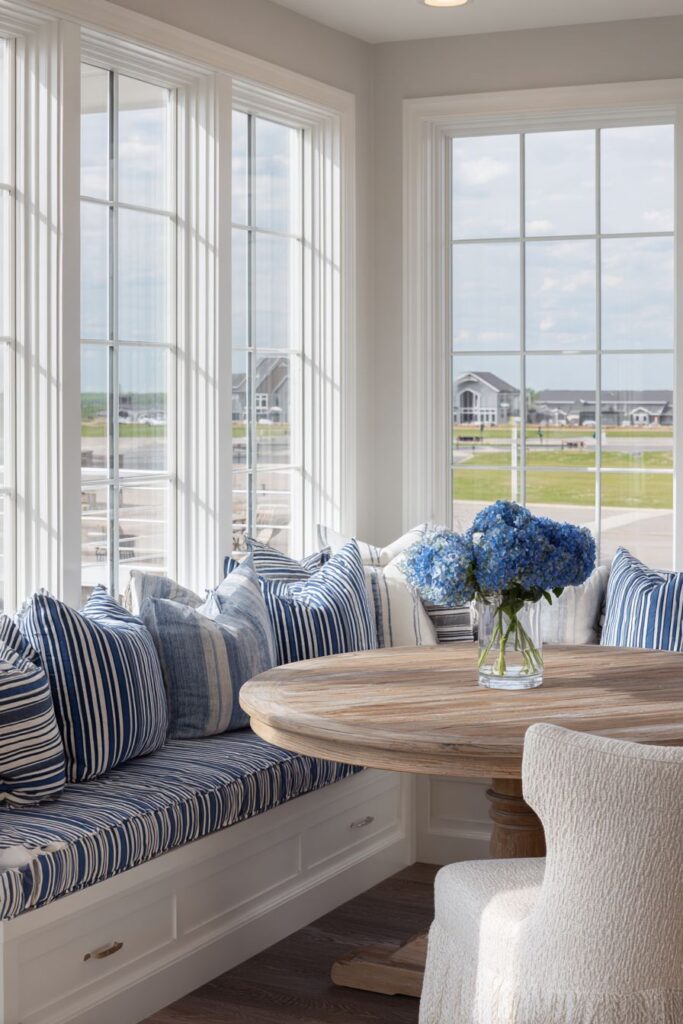
A round pedestal table in natural oak provides the perfect dining surface for intimate meals and casual conversation. The round shape encourages interaction while the pedestal base maximizes legroom and allows for flexible seating arrangements. The warm wood tone complements the navy and white color scheme while adding natural texture to the space.
Windows on two sides flood the breakfast nook with natural light, creating a bright, cheerful environment for morning meals and afternoon snacks. The abundant daylight makes the space feel larger and more connected to the outdoors while providing pleasant views during dining. The window placement creates cross-ventilation that keeps the area comfortable.
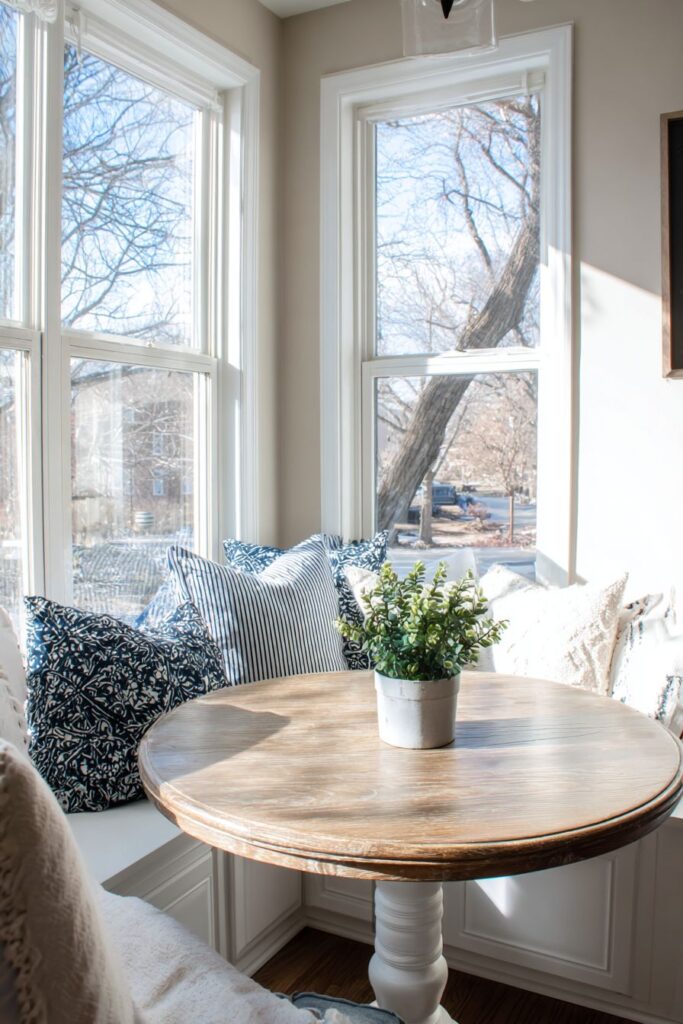
This breakfast nook design captures the essence of casual family dining while maintaining sophisticated design standards. The combination of built-in efficiency and comfortable materials creates a space that encourages lingering over coffee and conversation while remaining practical for everyday use.
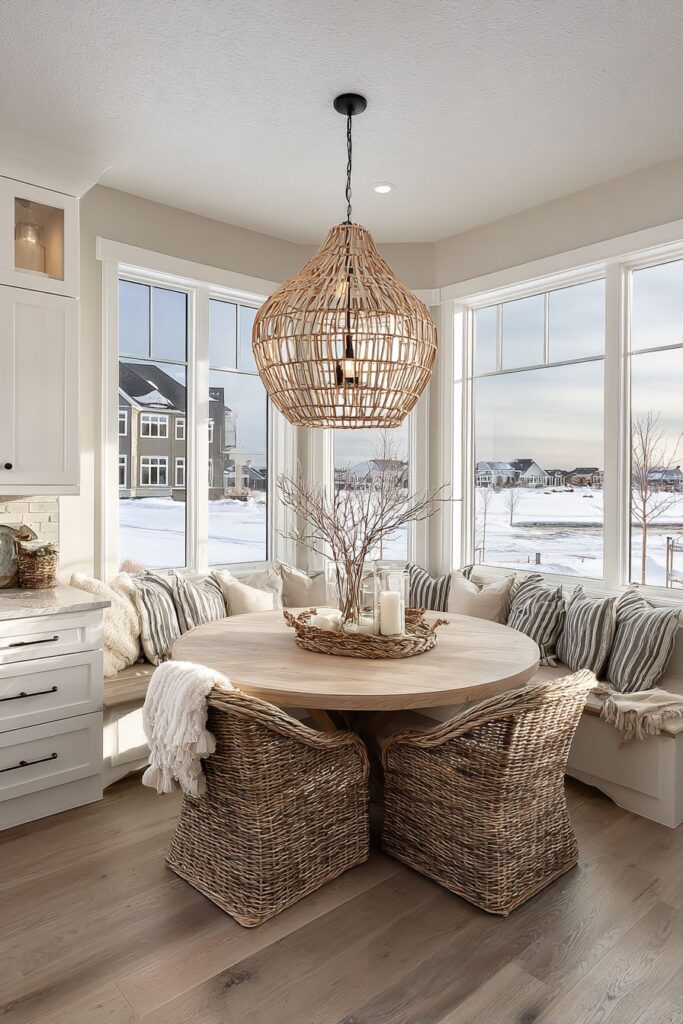
Key Design Tips:
- Use built-in seating to maximize space efficiency in compact areas
- Choose durable, washable fabrics for dining area cushions
- Position tables to take advantage of natural light and views
- Include storage within banquette seating for maximum functionality
- Select round tables to encourage conversation and maximize seating
17. Copper Cookware Display Drama
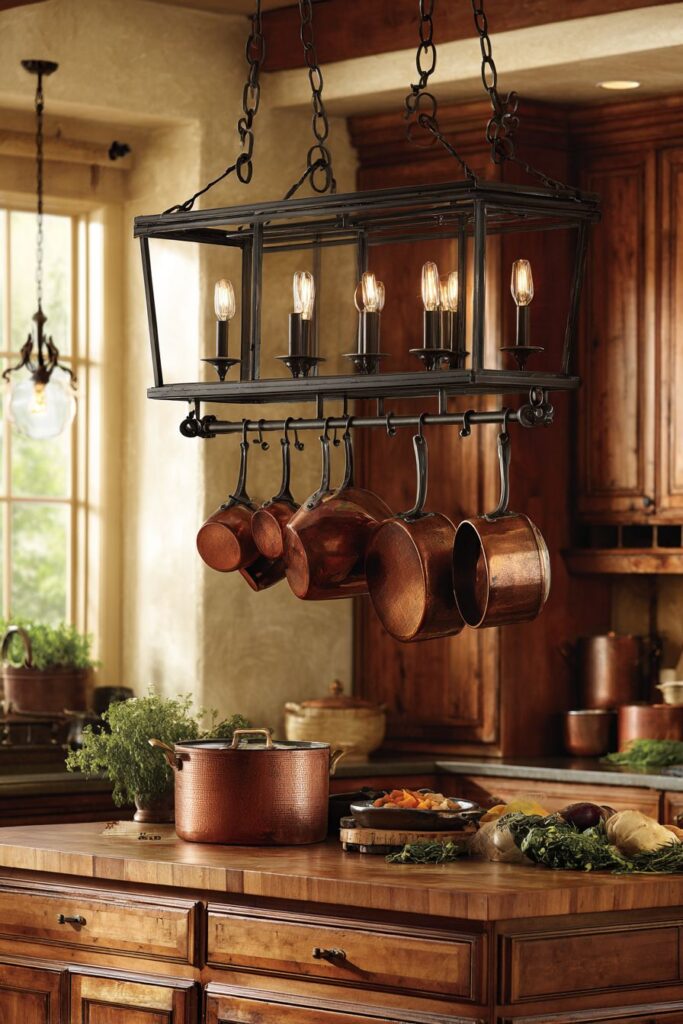
A wrought iron pot rack suspended from the ceiling creates a dramatic display for a collection of vintage copper pots and pans, transforming functional cookware into sculptural art. The warm copper tones create a beautiful patina that speaks to years of use and careful maintenance. Each piece in the collection tells a story while contributing to the overall visual impact of the hanging display.
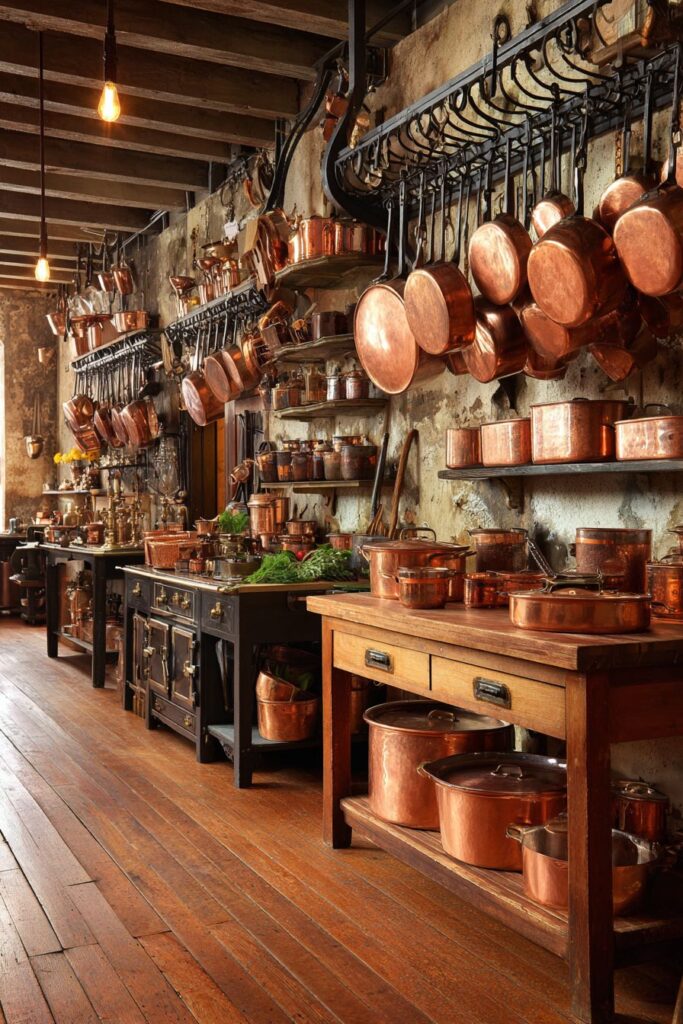
Warm wood cabinetry and butcher block countertops complement the copper’s rich tones while maintaining the kitchen’s connection to natural materials. The wood’s honey and amber tones echo the copper’s warmth while providing a substantial foundation for the design. The combination of metal and wood creates a sophisticated material palette that feels both professional and residential.
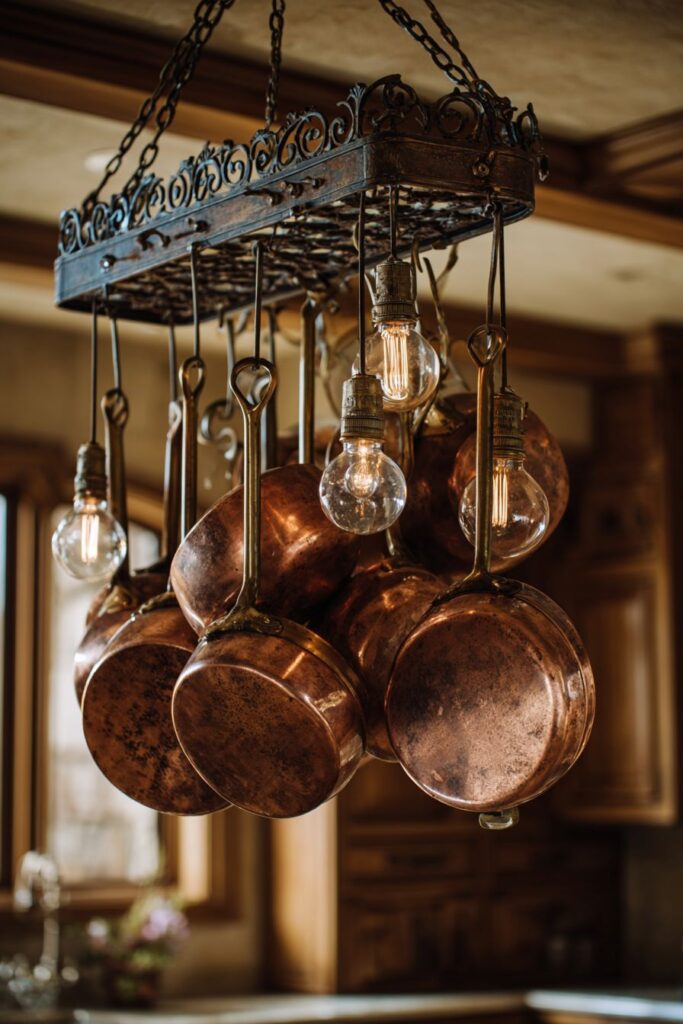
Edison bulb pendant lighting creates ambient warmth that enhances the copper’s natural glow while providing necessary task illumination. The vintage-style bulbs complement the traditional copper cookware while adding atmospheric lighting that makes the space feel inviting and comfortable. The warm light brings out the copper’s rich tones and beautiful patina.
This celebration of copper cookware demonstrates how functional items can serve as decoration when thoughtfully displayed. The overhead pot rack keeps frequently used items easily accessible while creating a focal point that commands attention and admiration from cooking enthusiasts and design lovers alike.
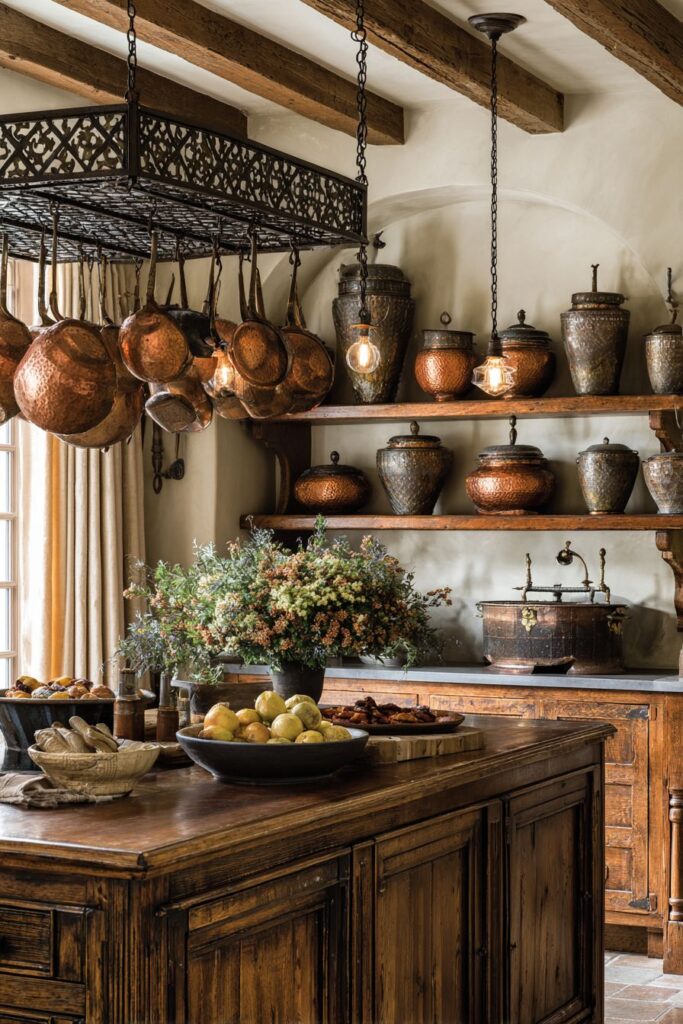
Key Design Tips:
- Choose copper pieces with natural patina for authentic character
- Ensure pot rack installation can support the weight of copper cookware
- Use warm lighting to enhance copper’s natural glow
- Complement copper tones with warm wood finishes
- Arrange pieces by size and frequency of use for both beauty and function
18. Modern Shaker Simplicity
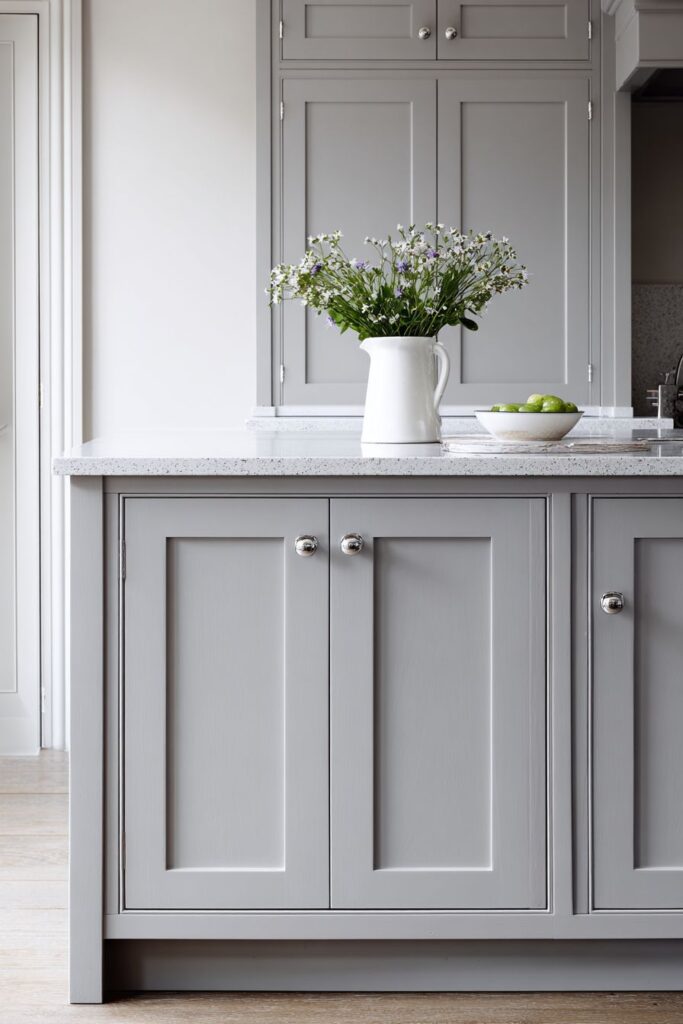
Soft grey Shaker-style cabinetry receives a contemporary update through simplified flat-panel doors and minimal hardware, proving that traditional styles can evolve while maintaining their essential character. The muted grey color adds sophistication while the clean lines keep the design feeling fresh and current. The quality craftsmanship evident in the joinery and finish work speaks to enduring construction standards.
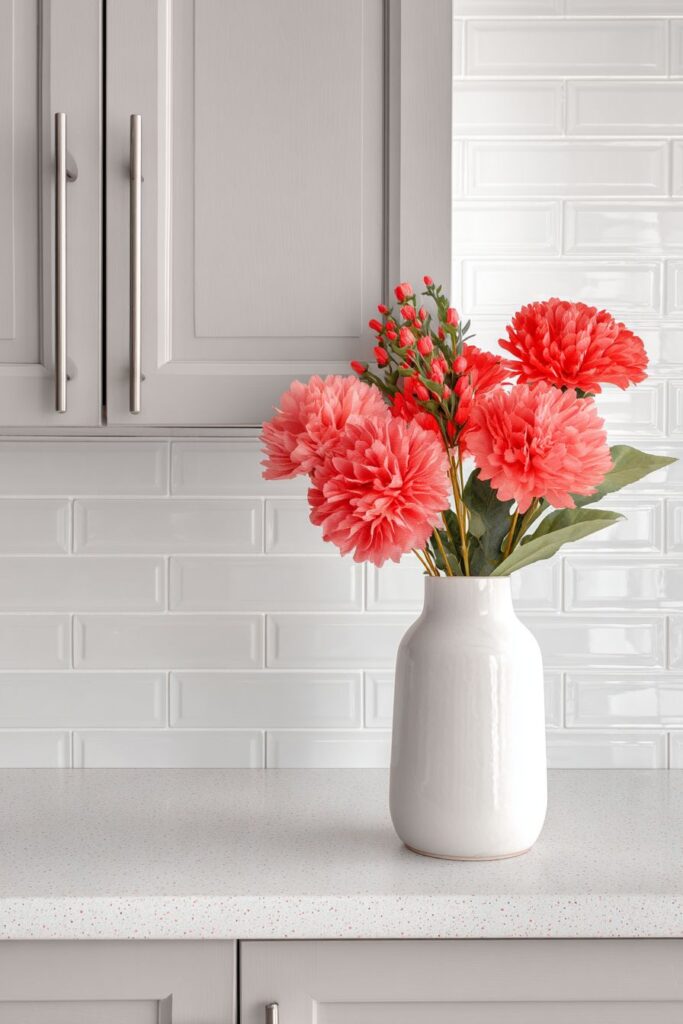
White quartz countertops with subtle sparkle provide practical work surfaces while adding a touch of glamour through their reflective properties. The sparkle catches and reflects light throughout the day, creating visual interest without overwhelming the space’s serene atmosphere. The crisp white color provides perfect contrast against the grey cabinetry.
A simple white ceramic vase with fresh flowers adds the only color accent needed, proving that sometimes restraint creates more impact than abundance. The natural elements bring life and freshness to the neutral palette while maintaining the design’s commitment to simplicity. The changing flowers provide seasonal color variation within the consistent design framework.
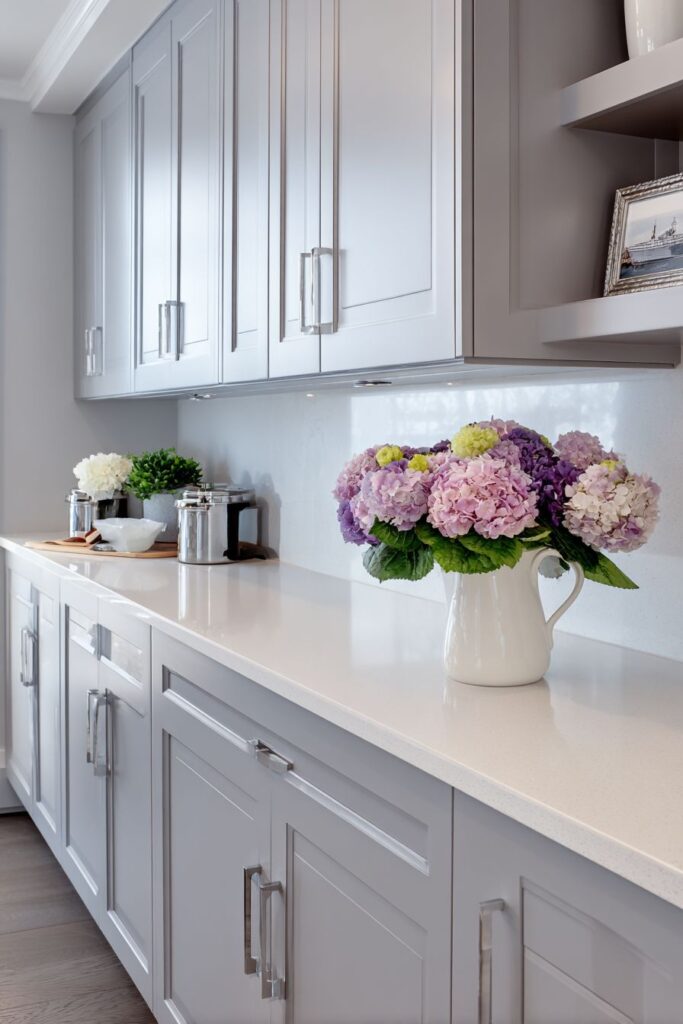
This modern Shaker kitchen demonstrates how classic design principles can be adapted for contemporary living without losing their essential appeal. The emphasis on quality materials, expert craftsmanship, and timeless proportions creates a space that will remain beautiful and relevant for decades to come.
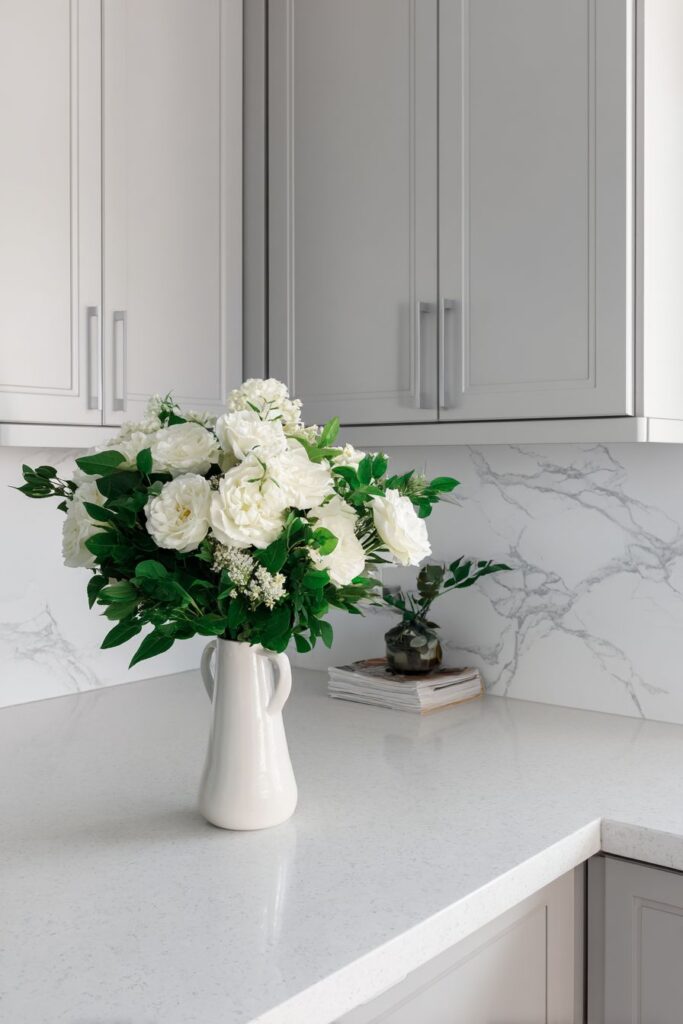
Key Design Tips:
- Update traditional styles through simplified details and contemporary colors
- Choose hardware that complements rather than competes with the cabinet design
- Use reflective surfaces to add light and visual interest
- Include natural elements like flowers for life and color
- Invest in quality craftsmanship for lasting beauty and function
19. Wine Storage Luxury
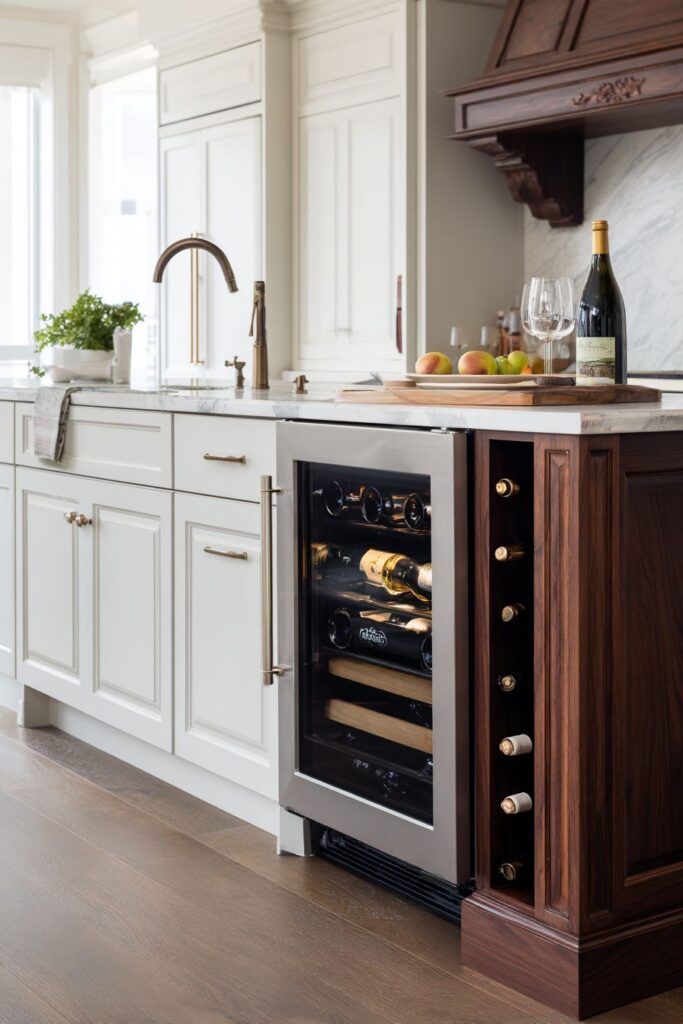
A built-in wine fridge and custom walnut wine rack create a sophisticated storage solution for wine enthusiasts who appreciate both function and display. The dark walnut wood provides rich contrast against white cabinetry while creating an elegant backdrop for the wine collection. The horizontal display allows labels to be easily read while protecting corks from drying out.
Ambient LED lighting illuminates the wine collection while creating a dramatic focal point that celebrates the beauty of well-designed bottles. The lighting transforms storage into a presentation, making the wine collection a decorative element that adds sophistication and personal interest to the kitchen design. The warm light enhances the wood’s rich grain and creates inviting shadows.
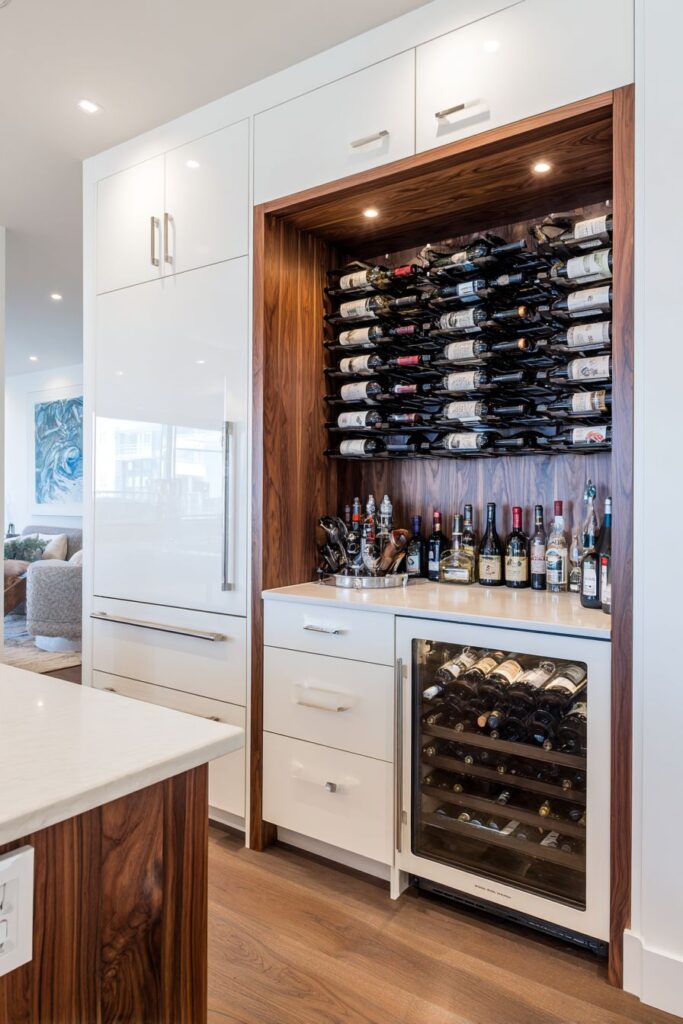
The integration of refrigerated and ambient storage demonstrates thoughtful planning for different wine types and serving temperatures. White wines and champagnes benefit from refrigerated storage, while reds are properly stored at cellar temperature in the wooden racks. This dual approach ensures optimal wine preservation while maintaining aesthetic appeal.
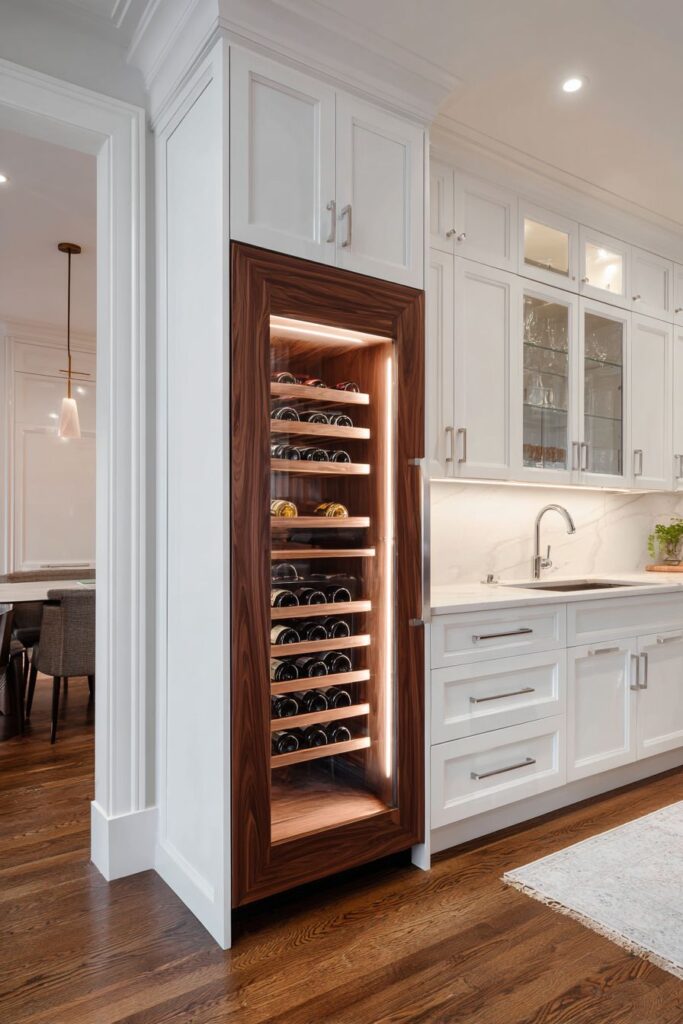
This wine storage solution brings cellar-quality storage into the kitchen environment, making wine selection and service convenient while maintaining proper preservation conditions. The combination of functional and display storage creates a feature that wine lovers will appreciate while adding luxury to the overall kitchen design.
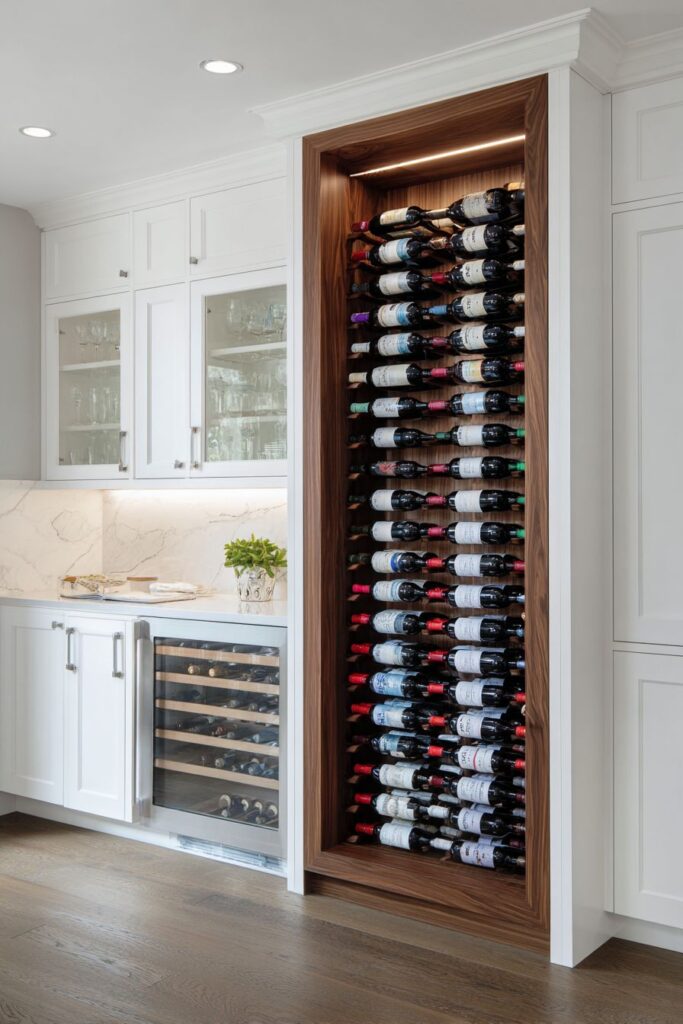
Key Design Tips:
- Combine refrigerated and ambient storage for different wine types
- Use dark wood to create dramatic contrast and showcase bottles
- Include LED lighting to highlight the collection and create ambiance
- Design horizontal storage to protect corks and display labels
- Plan electrical and ventilation requirements for wine refrigeration
20. Authentic Farmhouse Island Character
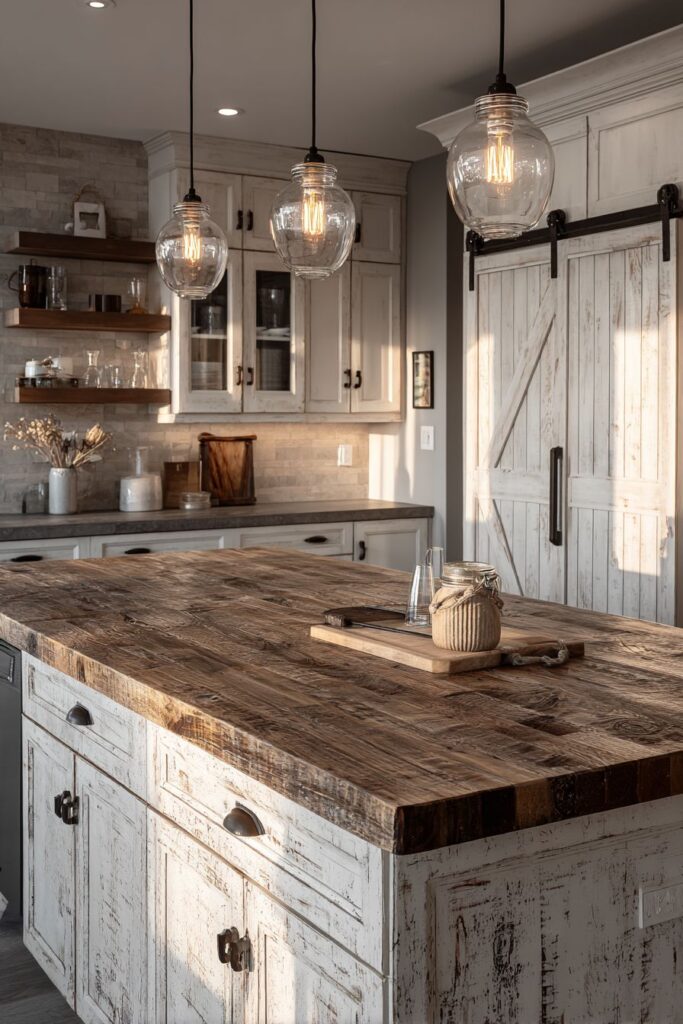
Distressed white paint finish on a farmhouse-style kitchen island reveals layers of history and character that cannot be replicated by new construction. The weathered appearance suggests decades of use while the substantial proportions provide generous workspace and storage. Natural wood grain shows through the distressed paint, creating texture and visual interest that speaks to authentic craftsmanship.
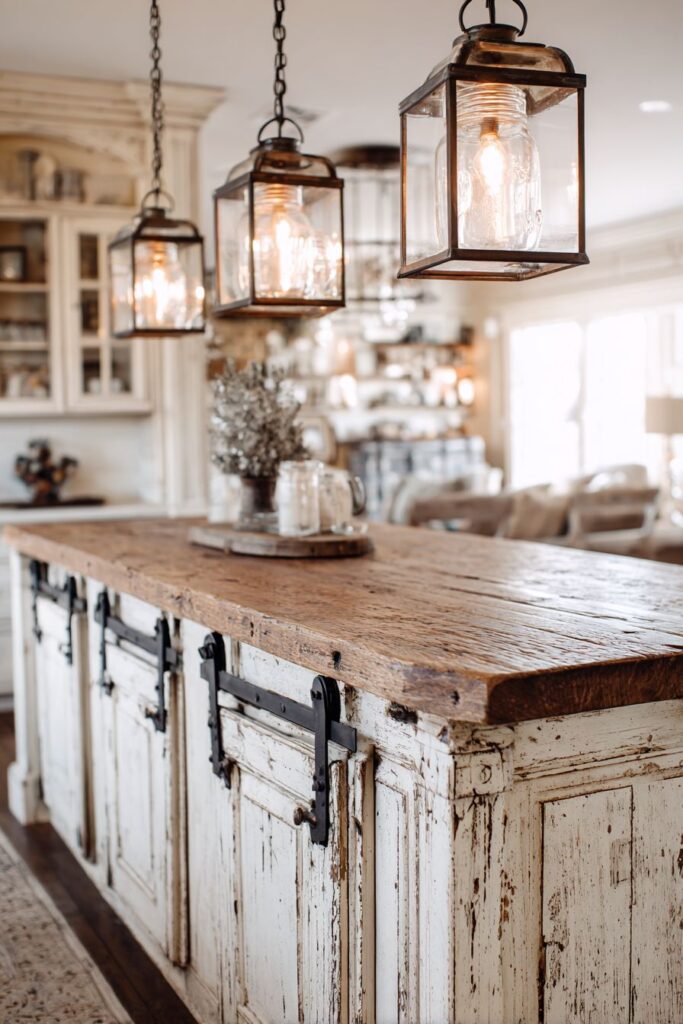
A butcher block countertop displays the honest marks of daily use – knife cuts, stains, and wear patterns that tell the story of countless meals prepared. This working surface embraces the philosophy that kitchen tools should show their use rather than hide it. The natural wood provides warmth and contrast against the painted base while offering a practical cutting surface.
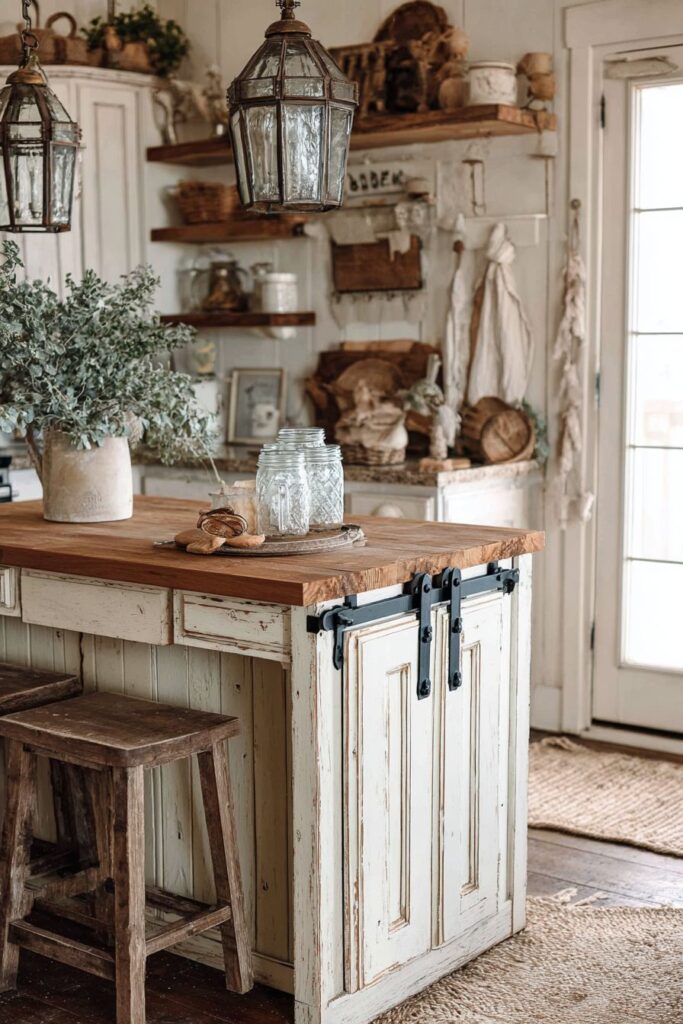
Vintage-style barn door hardware on cabinet doors adds authentic character while providing smooth operation and visual interest. The black metal hardware creates contrast against the white paint while maintaining the rustic aesthetic. Mason jar pendant lights provide task lighting with period-appropriate style that complements the island’s farmhouse character.
This farmhouse kitchen island celebrates the beauty of imperfection and the honesty of working surfaces. Rather than striving for pristine perfection, this design embraces the patina and character that comes with use, creating a piece that feels like a treasured family heirloom.
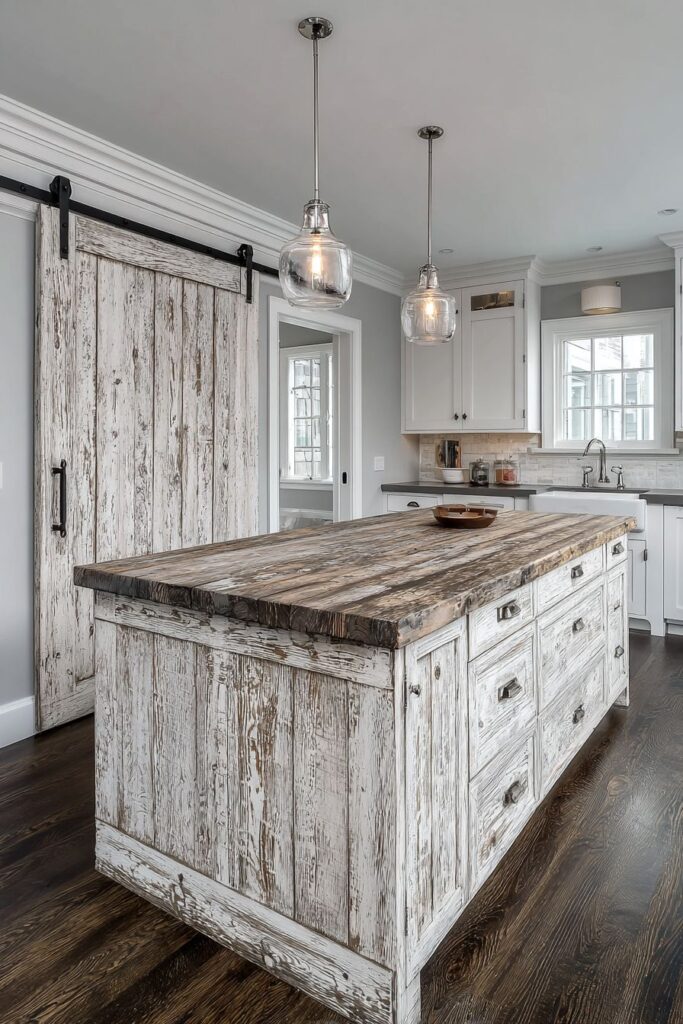
Key Design Tips:
- Choose distressing techniques that look natural rather than artificial
- Use authentic hardware styles that match the period aesthetic
- Embrace imperfections and wear patterns as design features
- Include practical surfaces like butcher block for food preparation
- Select lighting that complements the rustic character
21. Curated Gallery Wall Display
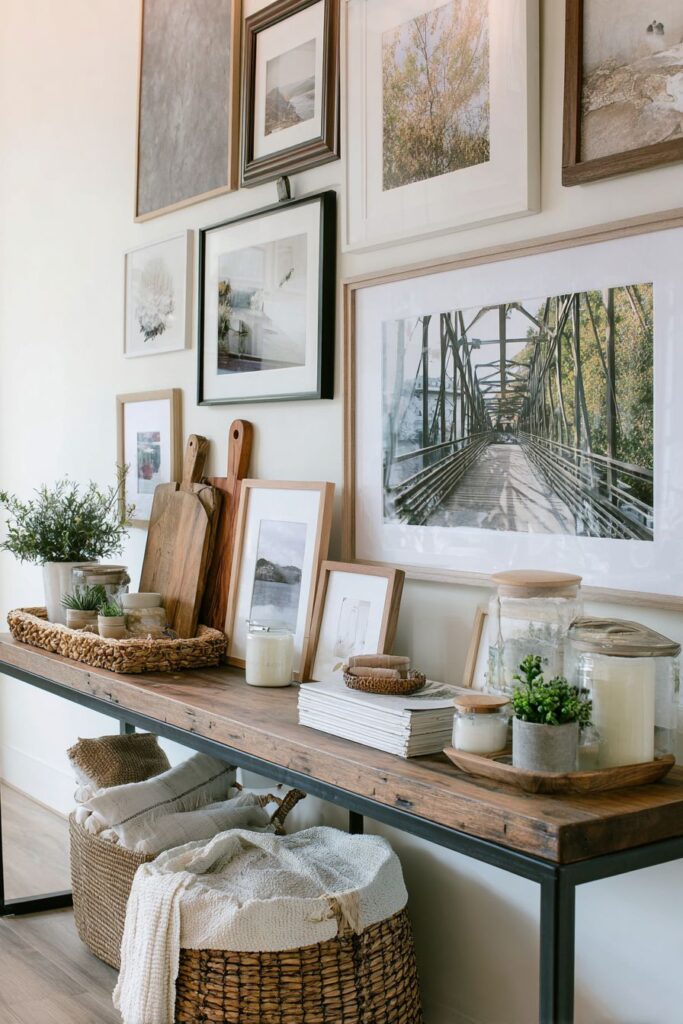
A thoughtfully arranged gallery wall above a console table creates visual interest and personal expression in an otherwise simple white kitchen. Framed botanical prints provide natural motifs that bring the outdoors inside while maintaining the space’s serene atmosphere. Vintage cutting boards add functional beauty and speak to the kitchen’s connection to food preparation and cooking traditions.
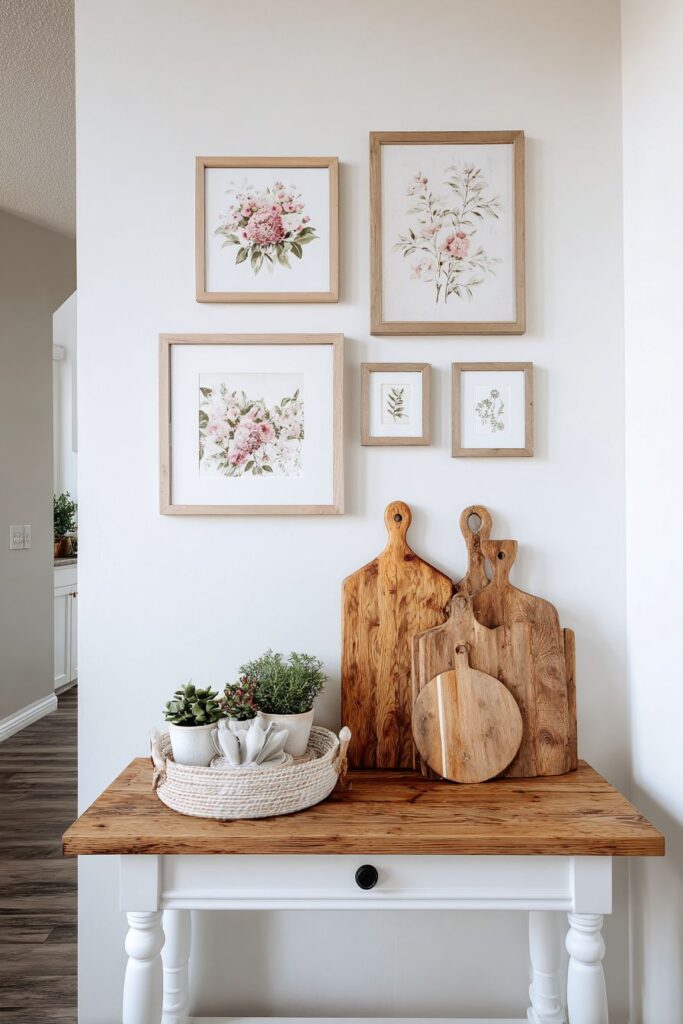
Small potted herbs introduce living elements that provide both visual appeal and culinary functionality. The combination of art, functional objects, and living plants creates a dynamic display that changes with the seasons and reflects the homeowner’s personality. Natural wood frames in various sizes add organic texture while maintaining visual cohesion.
The gallery wall arrangement demonstrates how personal collections can be thoughtfully curated to create focal points that feel intentional rather than cluttered. Each element serves a purpose while contributing to the overall composition. The varying sizes and shapes create visual rhythm while the consistent color palette maintains harmony.
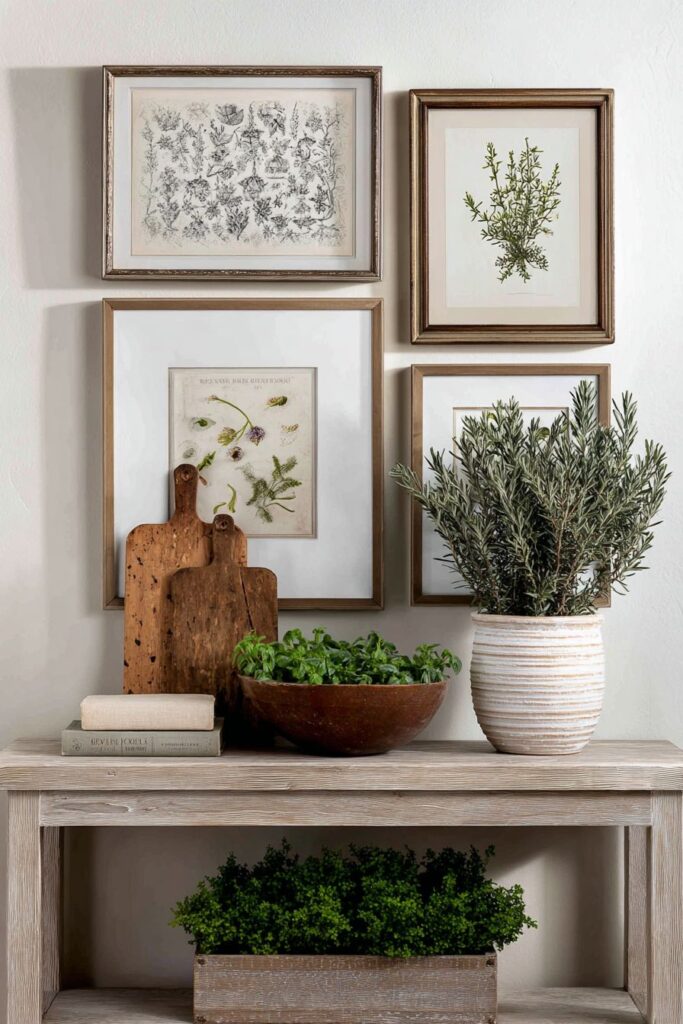
This approach to kitchen wall decor proves that even simple spaces can accommodate personal expression and visual interest through thoughtful curation and arrangement. The combination of functional and decorative elements creates a display that is both beautiful and practical.
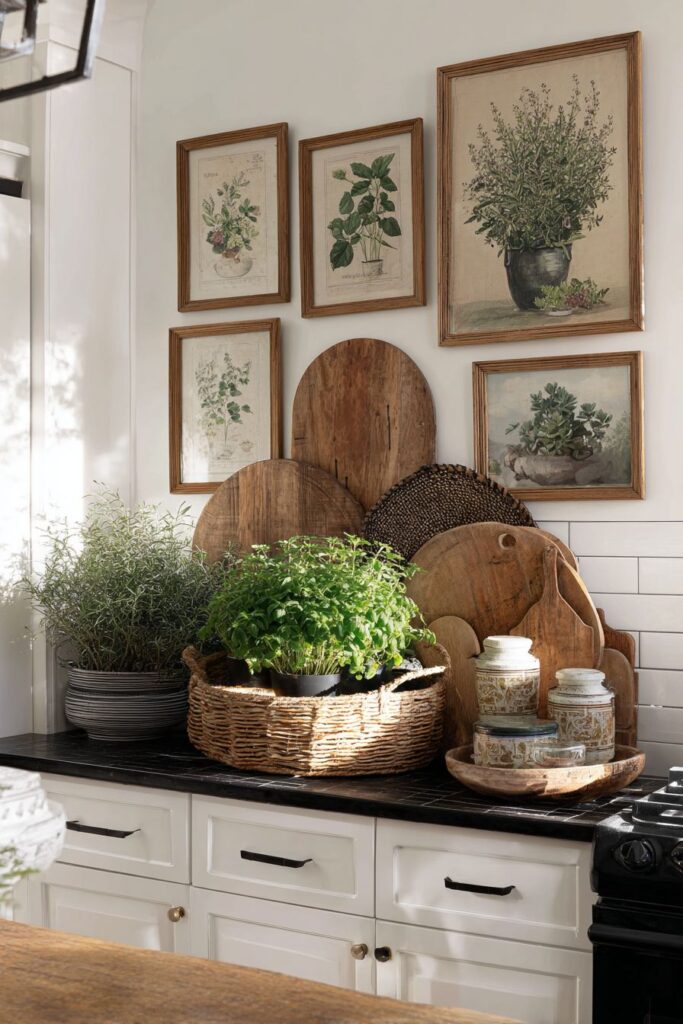
Key Design Tips:
- Mix functional items with purely decorative pieces for interesting contrast
- Use natural frames to add warmth and organic texture
- Include living elements like herbs for freshness and functionality
- Arrange items in odd numbers for natural-looking compositions
- Plan the arrangement on the floor before hanging for optimal composition
22. Sophisticated Dark Drama
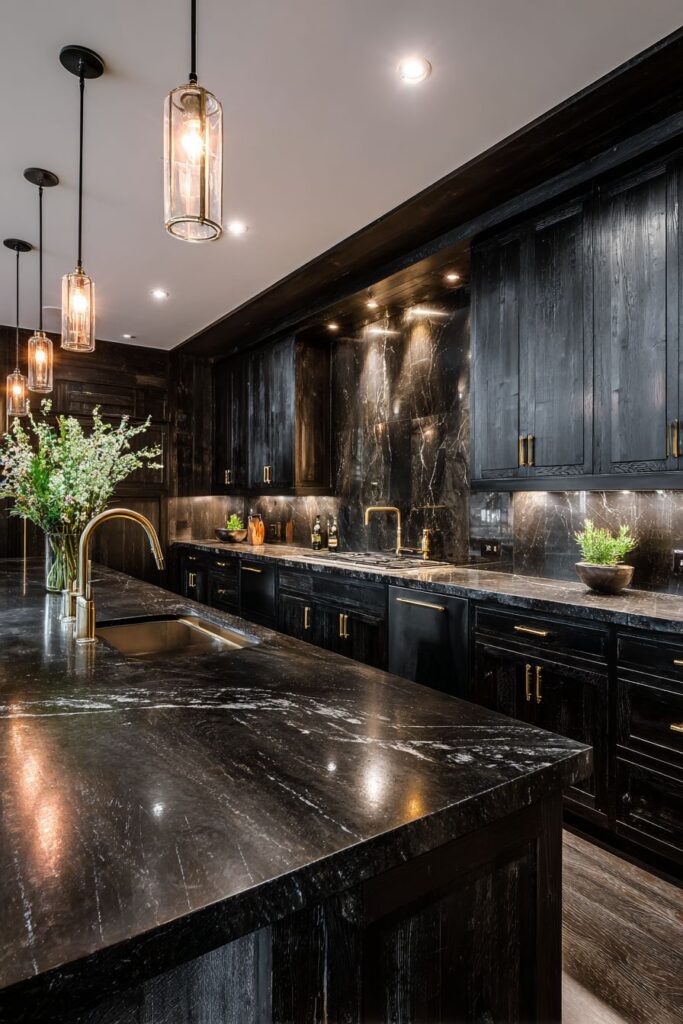
Charcoal grey cabinetry creates a dramatic foundation for this sophisticated kitchen design that embraces dark surfaces without sacrificing functionality or comfort. Black granite countertops provide practical work surfaces while reinforcing the dramatic color palette. Brass hardware creates warm accents that prevent the dark scheme from feeling cold or unwelcoming.
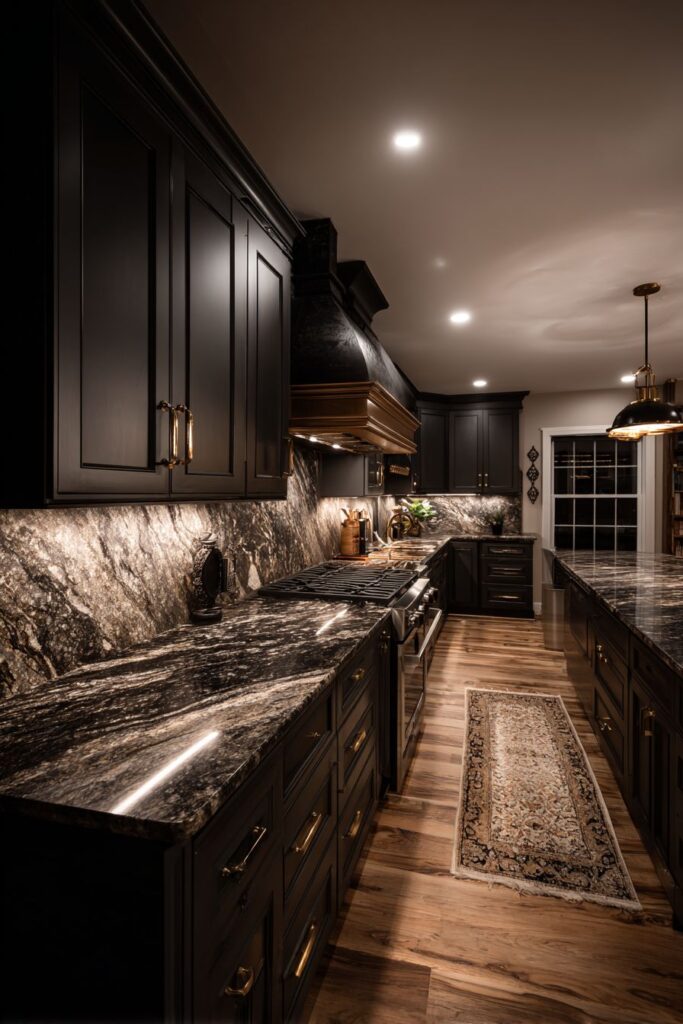
Under-cabinet LED lighting provides essential task illumination while pendant lights offer ambient glow that creates layers of light throughout the space. The strategic lighting ensures that dark surfaces don’t create shadowy work areas while maintaining the dramatic atmosphere that makes this design so compelling. The interplay of light and dark creates visual depth and interest.
The brass hardware and fixtures add warmth and luxury that elevates the dark palette from merely dramatic to genuinely sophisticated. The warm metallic finish creates focal points throughout the space while maintaining consistency in material selection. Each brass element becomes a jewel-like accent against the dark background.
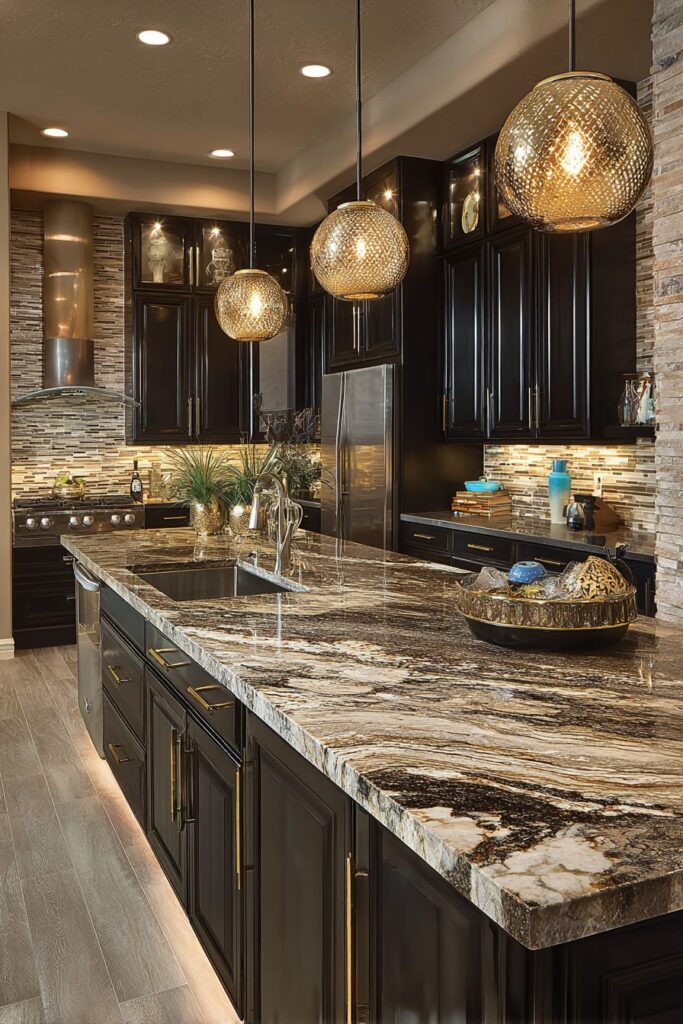
This dark kitchen design demonstrates that sophisticated drama can be achieved without sacrificing livability or function. The careful balance of dark and metallic elements creates a space that feels both intimate and luxurious while remaining highly practical for everyday cooking and entertaining.
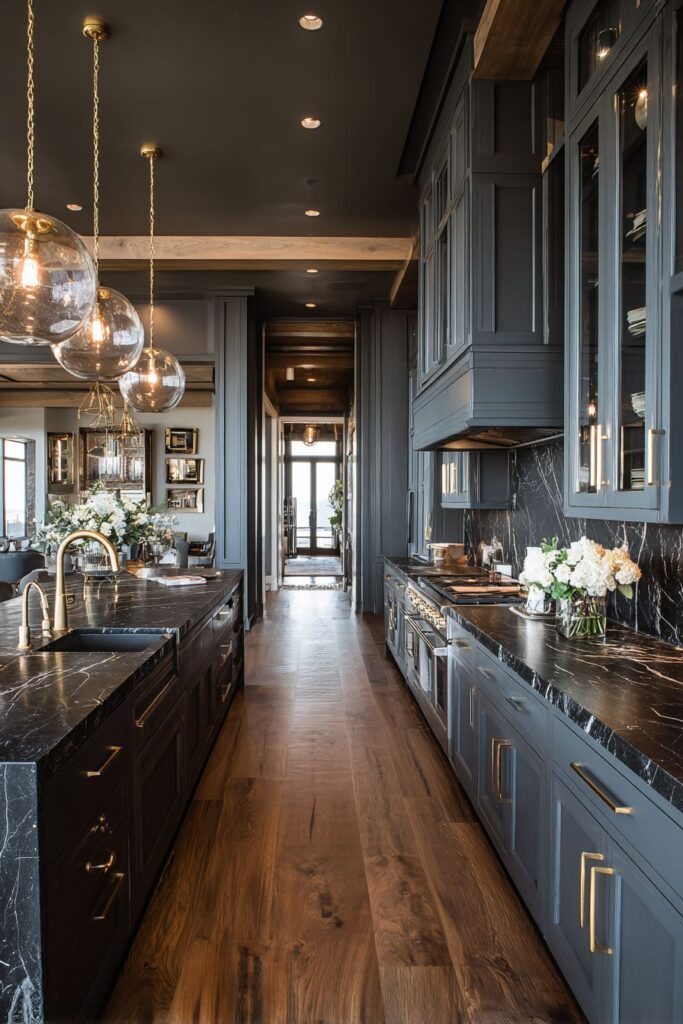
Key Design Tips:
- Include multiple light sources to prevent dark surfaces from creating shadows
- Use warm metallic accents to add warmth to cool dark palettes
- Choose high-quality finishes that can withstand close inspection
- Plan sufficient task lighting for food preparation safety
- Balance dark elements with strategic light accents
23. Minimalist Innovation Excellence
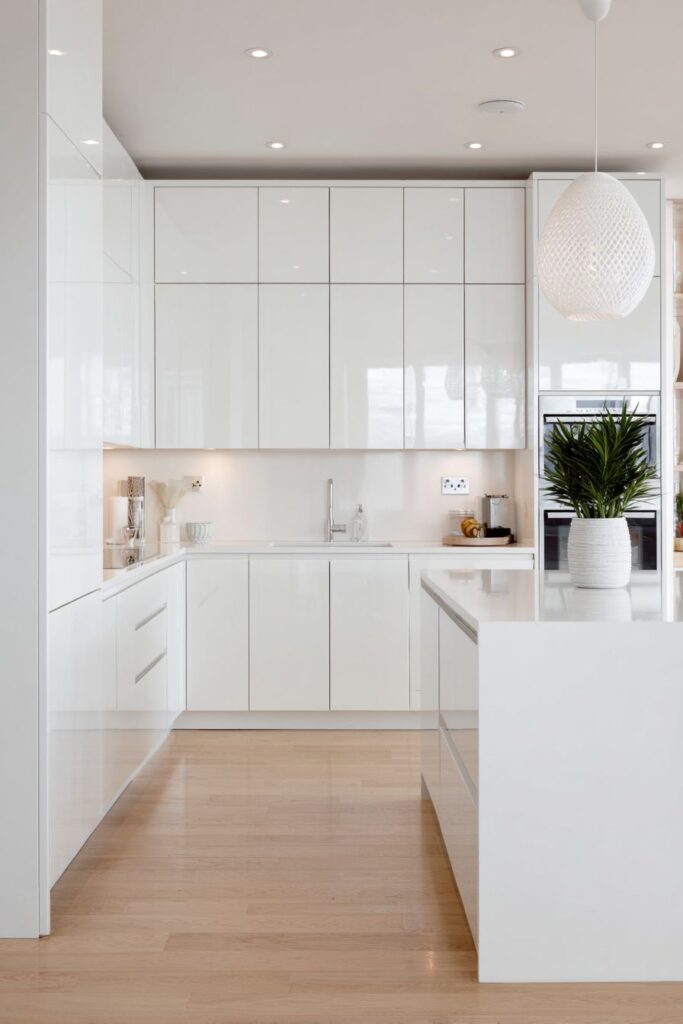
Handleless white cabinetry with push-to-open mechanisms creates seamless surfaces that embody the principles of minimalist design while incorporating innovative functionality. The absence of visible hardware creates clean lines that allow the eye to focus on proportions and materials rather than decorative details. Hidden storage solutions maximize functionality while maintaining the uncluttered aesthetic.
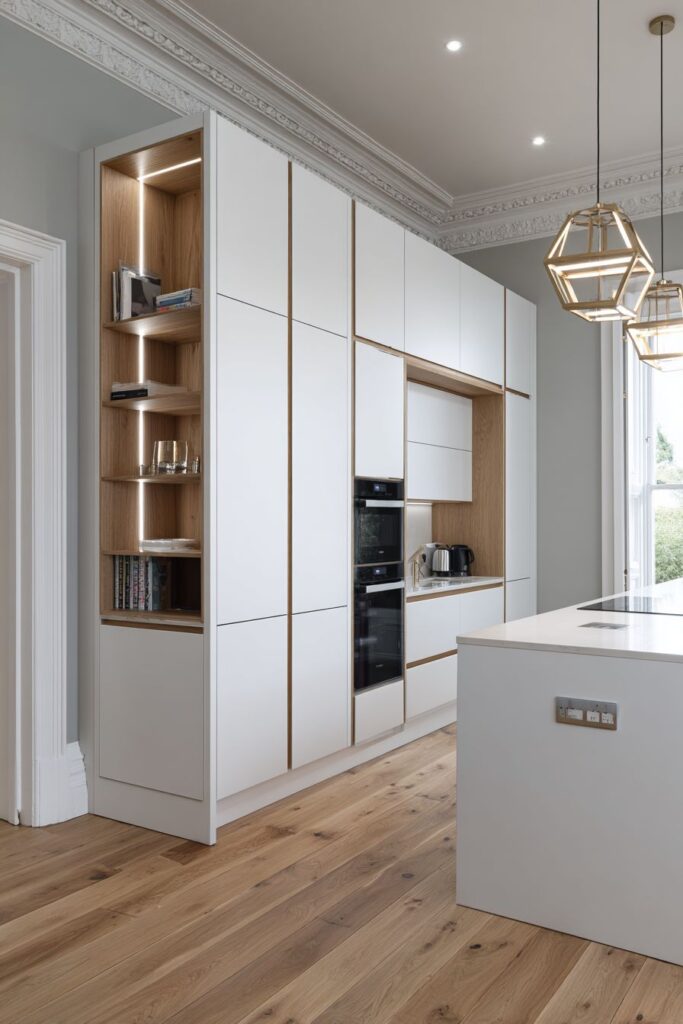
A single statement pendant light with geometric form provides task lighting over a waterfall-edge island while serving as the space’s only decorative element. The fixture’s sculptural quality creates visual interest without compromising the minimalist philosophy. The geometric design echoes the clean lines found throughout the space while providing necessary illumination.
Hidden storage solutions throughout the kitchen demonstrate how innovative design can maximize functionality while maintaining visual simplicity. Pull-out organizers, hidden drawers, and concealed appliance garages ensure that everything has a place while keeping surfaces clear and uncluttered. The storage systems represent the latest in kitchen organization technology.
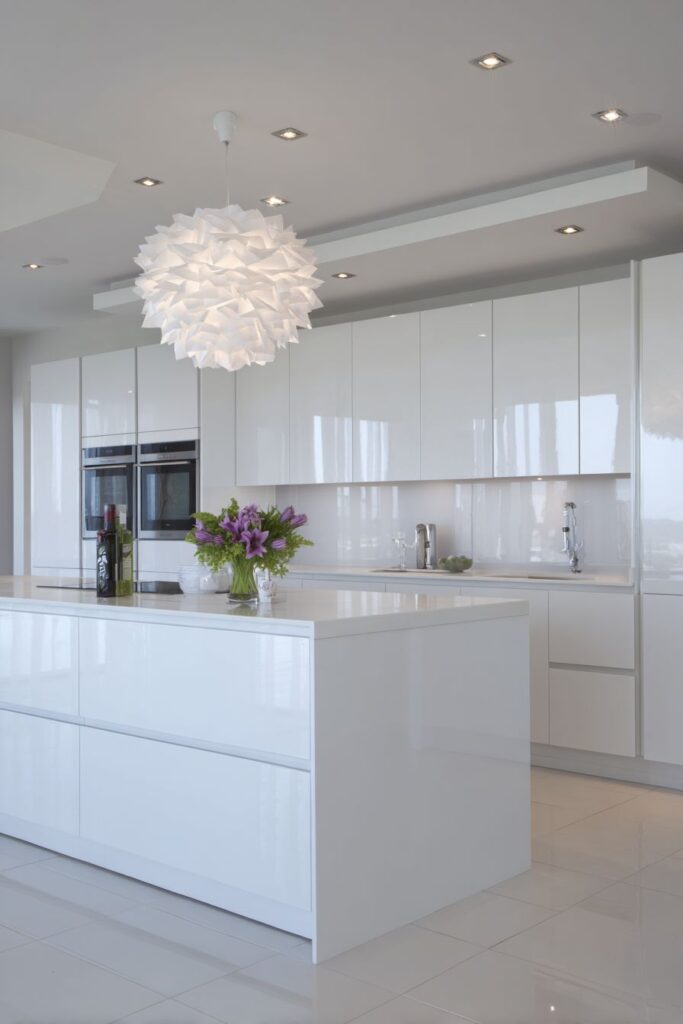
This minimalist kitchen design pushes the boundaries of simplicity while proving that minimal does not mean lacking in functionality. The innovative storage solutions and hardware-free surfaces create a space that feels both futuristic and timeless in its commitment to essential functionality.
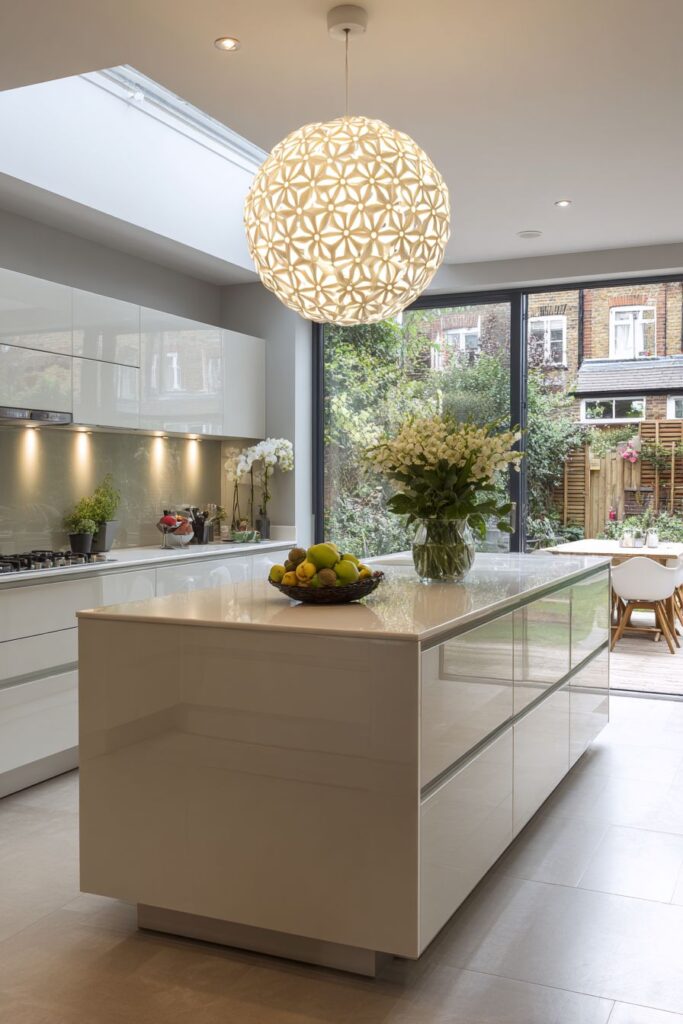
Key Design Tips:
- Invest in quality push-to-open hardware for reliable operation
- Include one statement element to prevent the space from feeling sterile
- Plan hidden storage carefully to maintain organized surfaces
- Use consistent materials throughout for seamless appearance
- Consider maintenance requirements of handleless surfaces
24. Transitional Style Balance
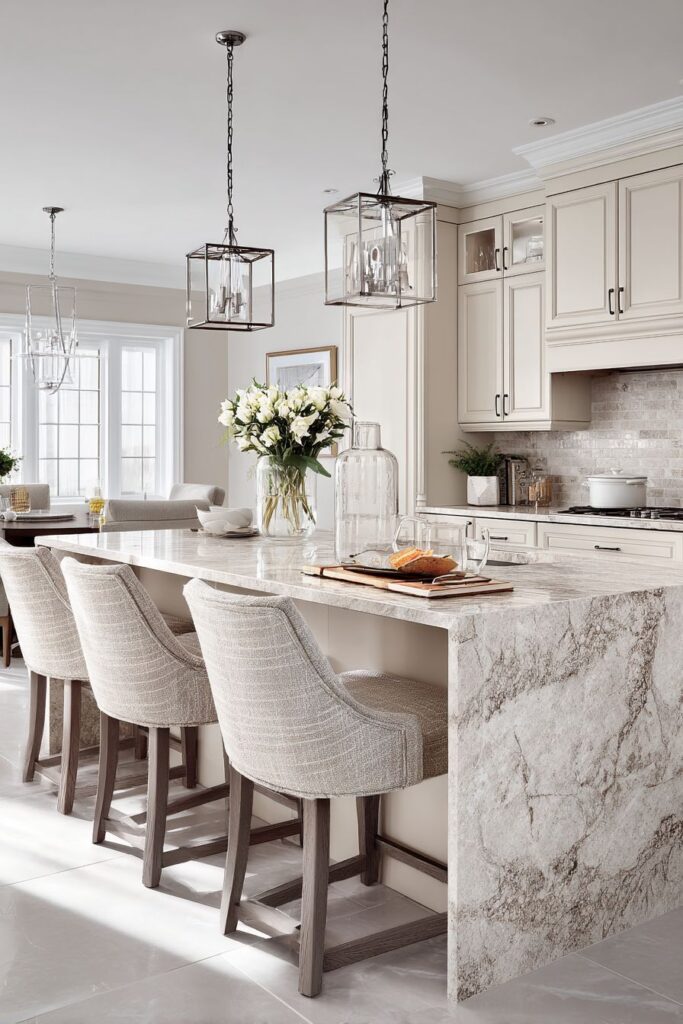
Traditional raised panel cabinetry in warm white provides classic elegance while modern conveniences ensure contemporary functionality in this perfectly balanced transitional design. Large format tile backsplash adds contemporary appeal while maintaining neutral tones that complement the traditional cabinetry. Contemporary lighting fixtures provide efficient illumination with clean, modern lines.
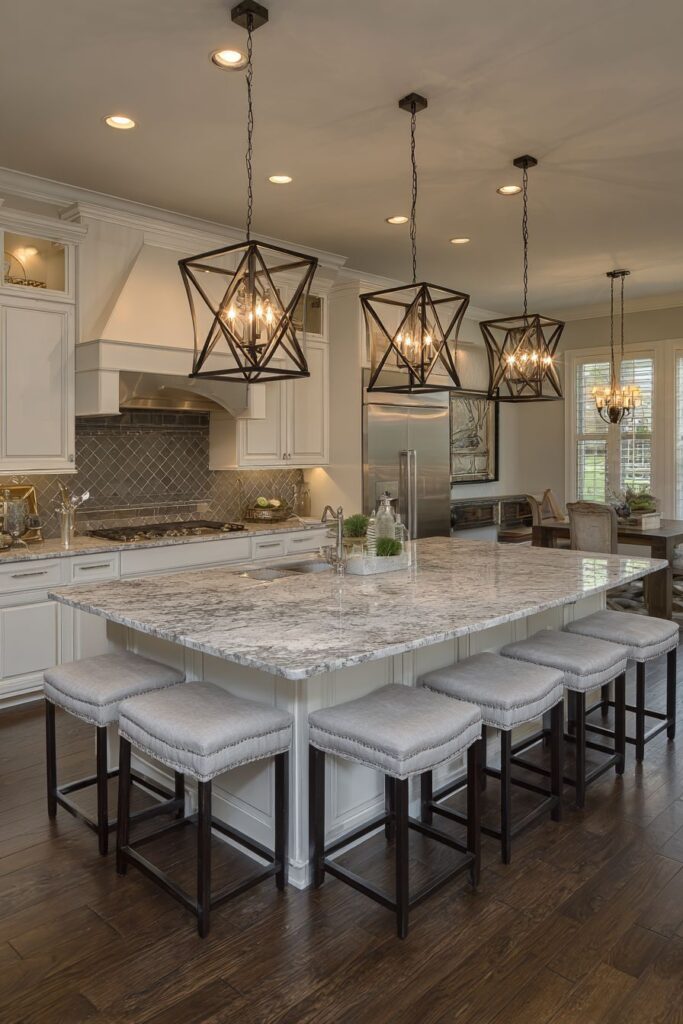
Mixed metal finishes in brushed nickel and oil-rubbed bronze add depth and visual interest while maintaining sophisticated restraint. The combination prevents the design from feeling too uniform while ensuring that all elements work together harmoniously. Each metal finish serves specific functions while contributing to the overall aesthetic balance.
The successful blend of classic and contemporary elements demonstrates how transitional design can satisfy both traditional and modern sensibilities without compromising either aesthetic. The careful selection of materials and finishes creates a space that feels both timeless and current. The proportions and details speak to quality craftsmanship and thoughtful design.
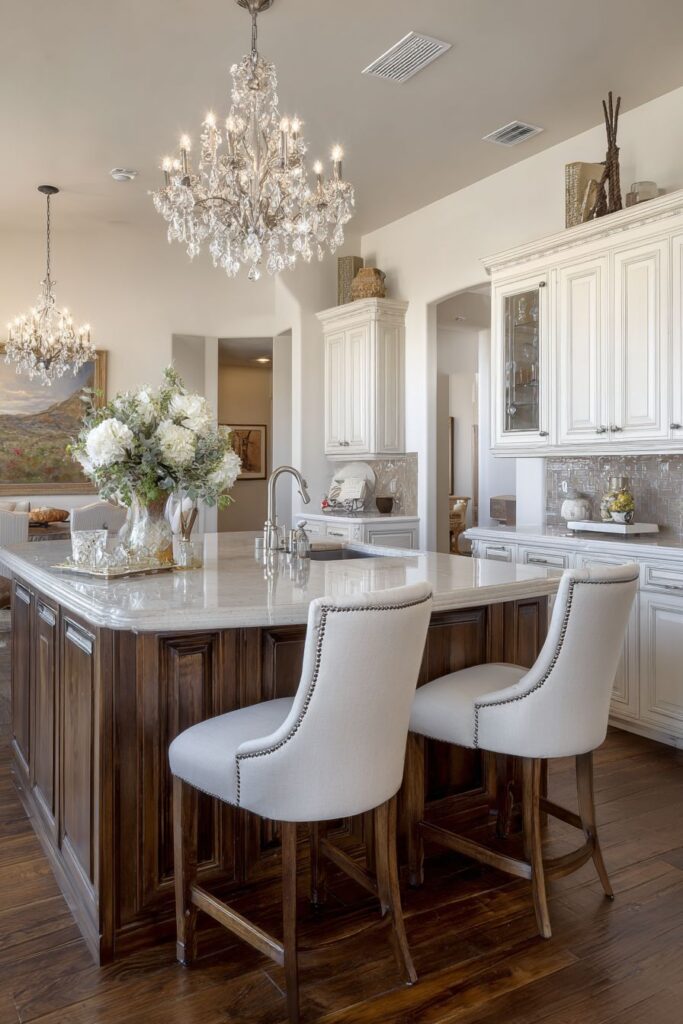
This transitional kitchen design proves that style fusion can create something greater than the sum of its parts when executed with skill and restraint. The combination of traditional and contemporary elements creates a space that appeals to a wide range of tastes while maintaining sophisticated design standards.
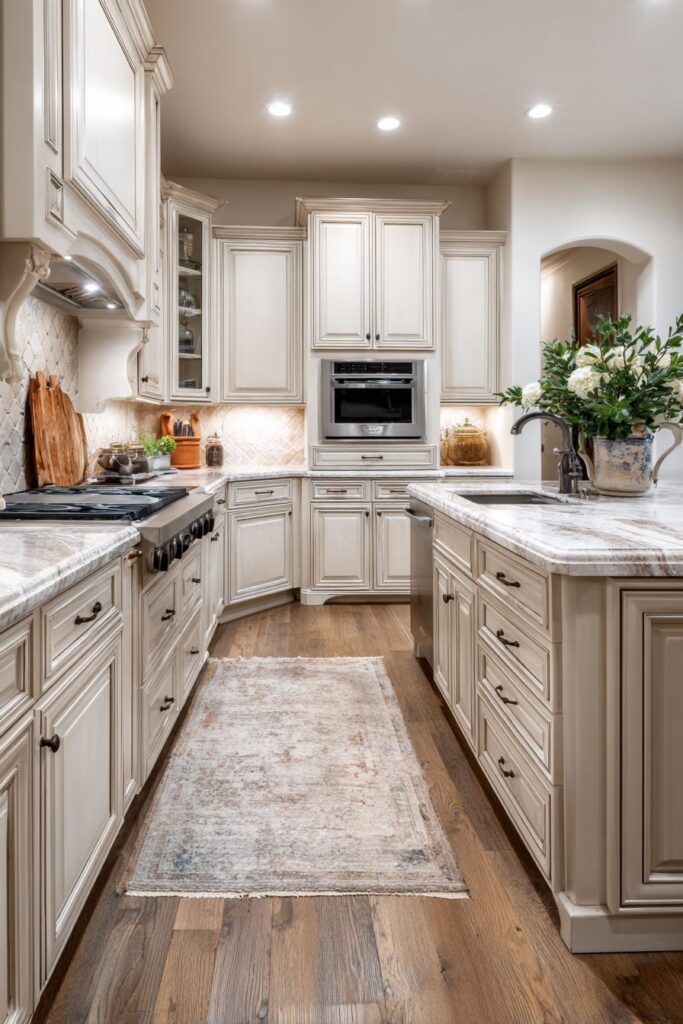
Key Design Tips:
- Balance traditional and contemporary elements in equal proportions
- Use mixed metals strategically for visual interest without chaos
- Choose classic proportions with contemporary materials
- Include both warm and cool elements for visual balance
- Focus on quality over quantity in material and finish selection
25. Compact Galley Efficiency
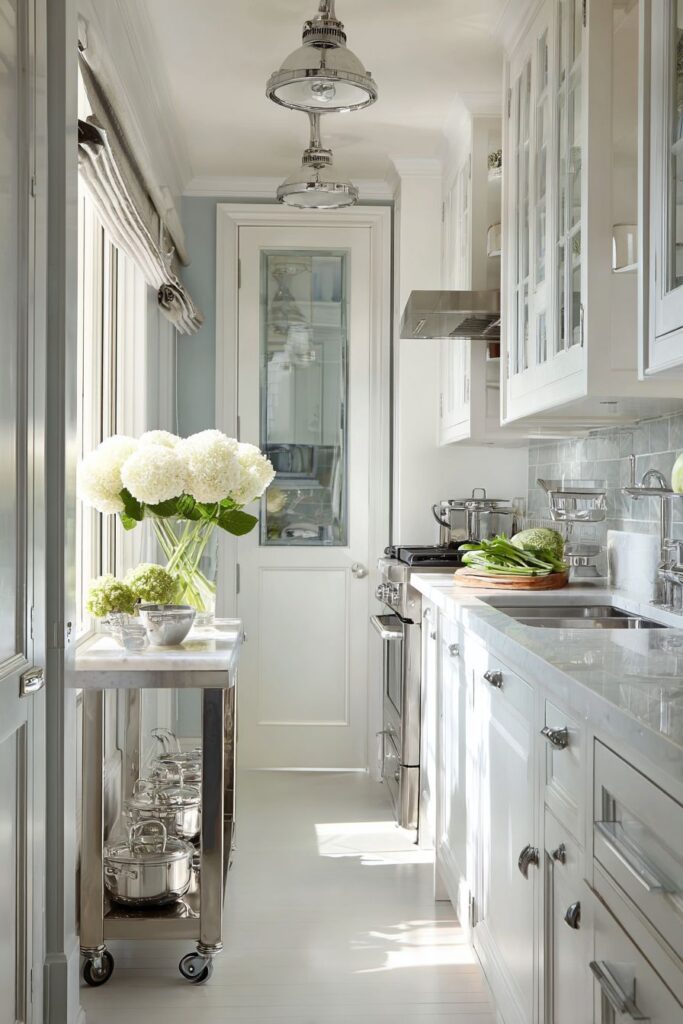
Floor-to-ceiling cabinetry maximizes storage capacity in this thoughtfully designed galley kitchen where every inch serves a purpose. Pull-out storage solutions ensure that even the deepest cabinets remain accessible and functional. A narrow island on wheels provides additional prep space that can be moved as needed for optimal workflow and accessibility.
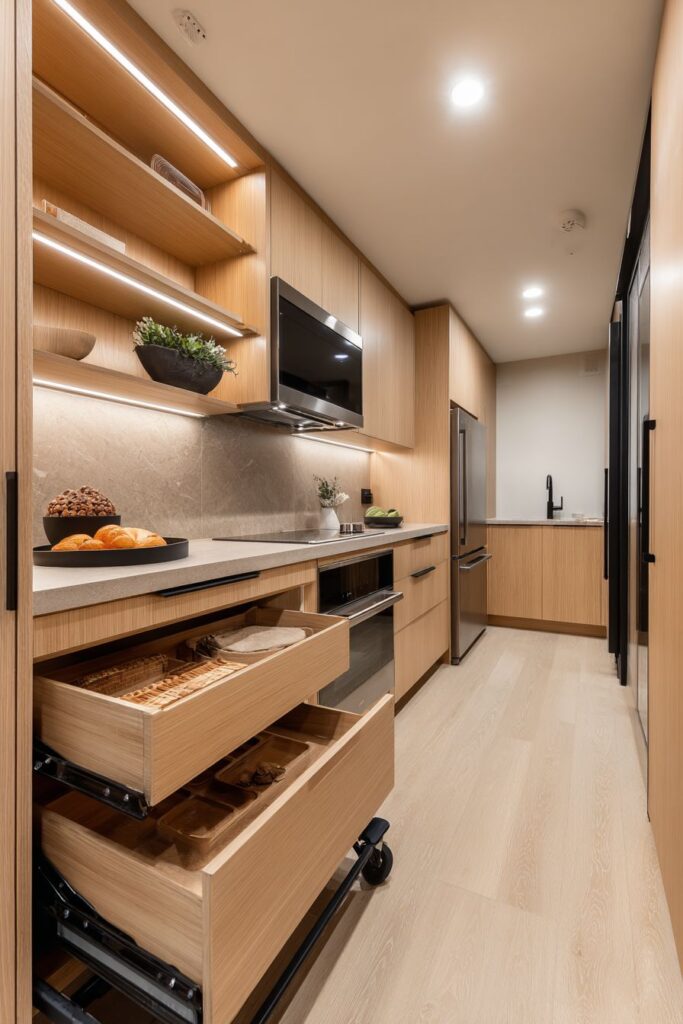
Light colors throughout the space create an illusion of greater size while strategic lighting eliminates shadows that could make the narrow space feel claustrophobic. White cabinetry reflects light and creates brightness while pale countertops maintain the open feeling. The consistent light palette creates visual continuity that makes the space feel larger than its actual dimensions.
Smart storage solutions demonstrate how compact spaces can be highly functional when every element is carefully planned. Vertical storage, pull-out drawers, and multi-functional furniture ensure that no space is wasted while maintaining easy access to frequently used items. The mobile island provides flexibility that static furniture cannot match.
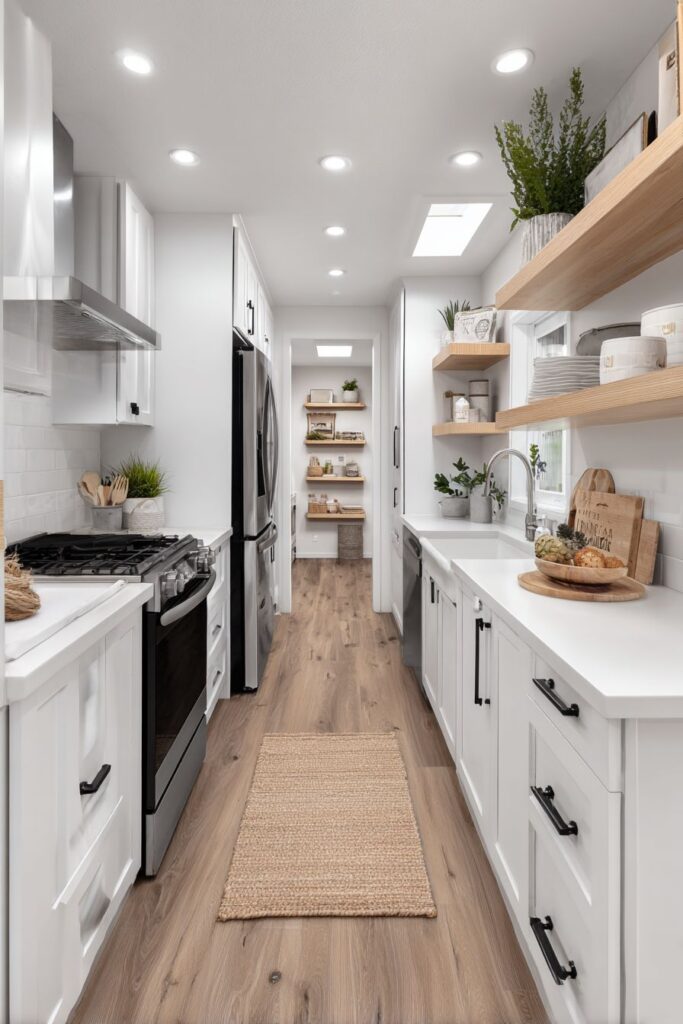
This small kitchen design proves that size limitations can inspire creative solutions that result in highly efficient and beautiful spaces. The combination of smart storage, light colors, and flexible furniture creates a kitchen that functions far beyond its modest square footage.
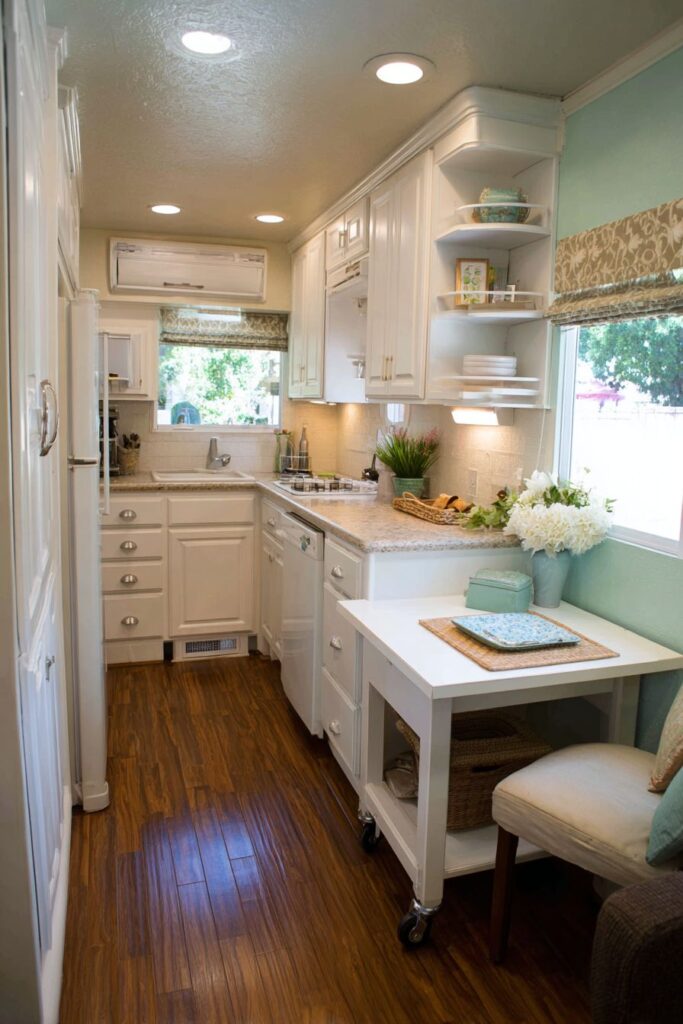
Key Design Tips:
- Use light colors throughout to maximize the sense of space
- Include mobile elements for flexibility in tight spaces
- Plan vertical storage to maximize capacity
- Install pull-out systems in deep cabinets for accessibility
- Include multiple light sources to eliminate shadows
26. Coastal Relaxation Retreat

Weathered wood shelving and sea glass blue cabinet accents create an immediate connection to coastal environments in this beach-inspired kitchen design. The soft blue-green color palette evokes ocean waters while natural materials like jute and rattan add texture that speaks to seaside living. Rope hardware details reinforce the nautical theme while providing functional cabinet and drawer pulls.
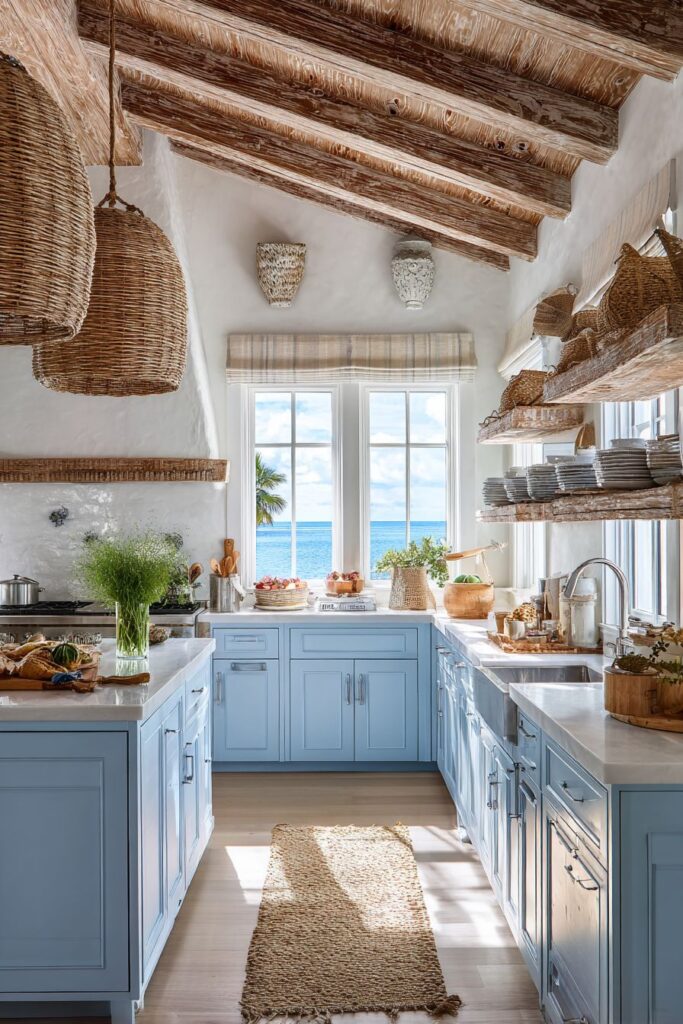
Natural materials throughout the space create texture and visual interest while maintaining the relaxed, casual atmosphere associated with coastal living. Jute light fixtures and rattan accessories add organic shapes and neutral tones that complement the blue accents without overwhelming the space. The combination of materials creates depth and interest while maintaining a cohesive aesthetic.
Large windows reveal ocean views while natural light highlights the weathered wood’s texture and the blue accents’ ocean-like qualities. The abundant daylight creates the bright, airy atmosphere that defines successful coastal design while providing pleasant views that make cooking and dining more enjoyable. The window placement maximizes both light and views.
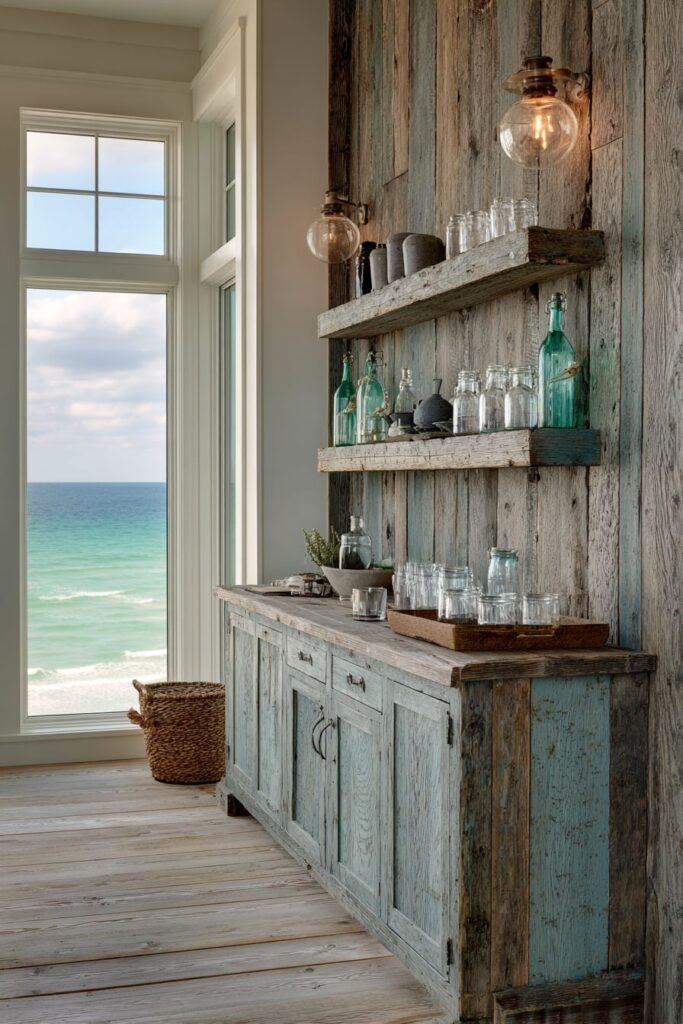
This coastal kitchen design captures the essence of beachside living while remaining practical for everyday use. The combination of weathered materials, ocean-inspired colors, and natural textures creates a space that feels like a permanent vacation retreat.
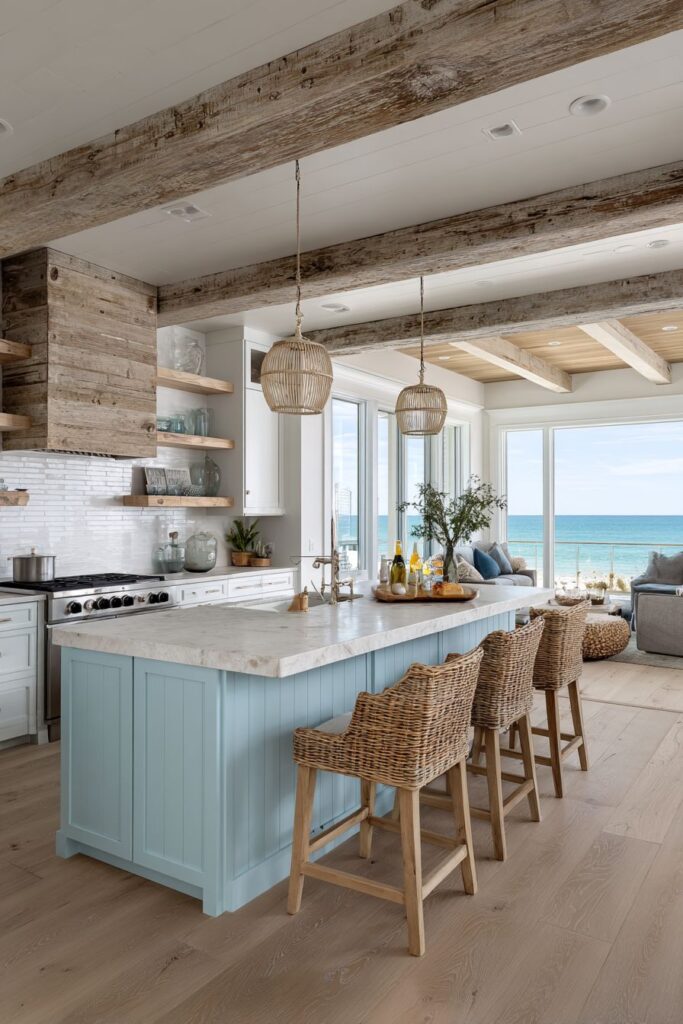
Key Design Tips:
- Use weathered and natural materials for authentic coastal appeal
- Include ocean-inspired colors in strategic accents rather than overwhelming applications
- Maximize natural light and views whenever possible
- Choose natural fiber accessories for texture and casual comfort
- Embrace imperfections in materials for authentic weathered appearance
27. Art Deco Glamour Revival
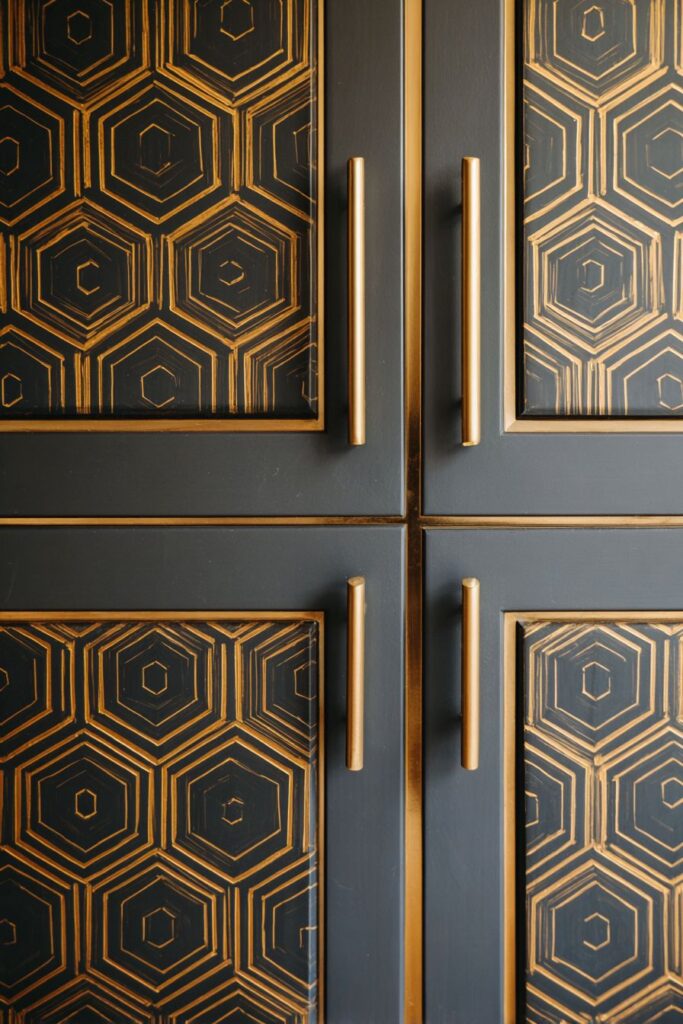
Geometric tile patterns in black and gold create dramatic focal points that capture the glamorous essence of the Art Deco period while maintaining contemporary functionality. Streamlined cabinetry with decorative metal accents reinforces the period aesthetic while providing modern storage solutions. Period-appropriate lighting fixtures with frosted glass shades complete the authentic 1920s atmosphere.
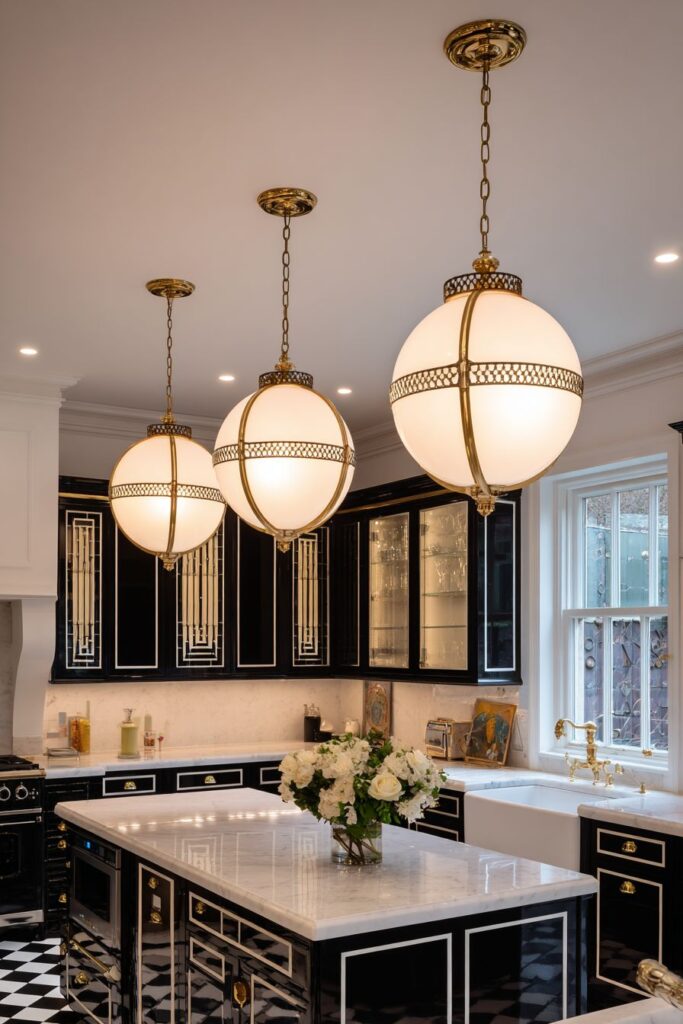
Rich materials like marble and brass create luxury and sophistication that define the Art Deco aesthetic. The combination of geometric patterns and luxurious materials creates visual drama while maintaining the refined elegance that makes this style eternally appealing. Each material selection reinforces the period’s commitment to quality and craftsmanship.
The successful integration of authentic style elements with modern functionality demonstrates how historical design periods can be adapted for contemporary living without losing their essential character. The geometric patterns and metallic accents create visual interest while modern appliances and storage solutions ensure practical functionality.
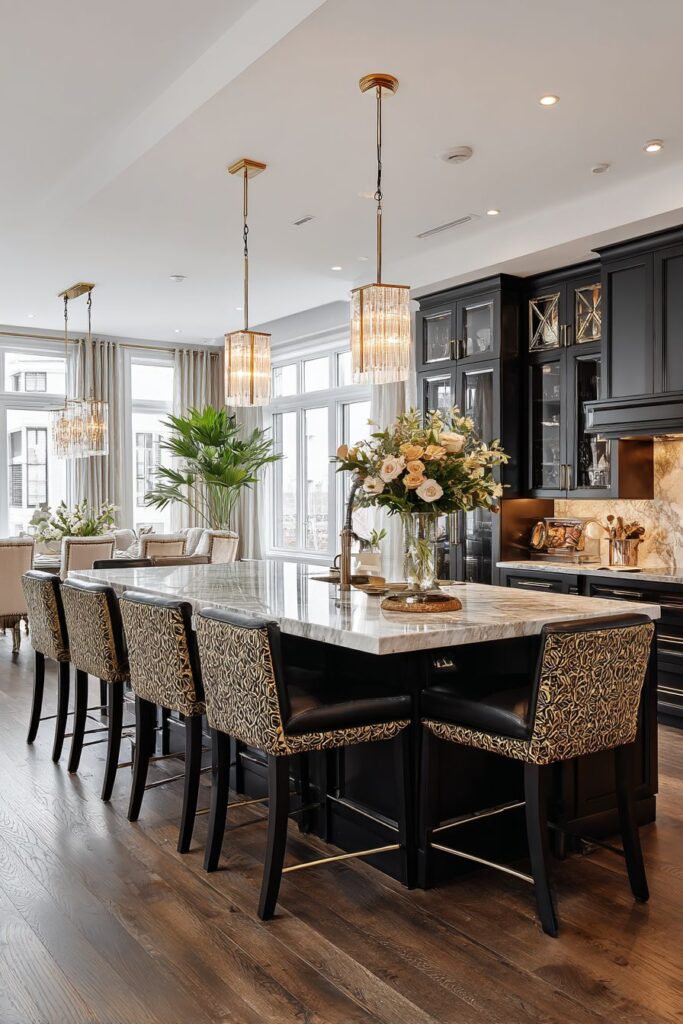
This Art Deco kitchen design brings the glamour and sophistication of the Jazz Age into contemporary homes while maintaining the period’s commitment to luxury materials and expert craftsmanship. The result is a space that feels both historically authentic and thoroughly modern in its functionality.
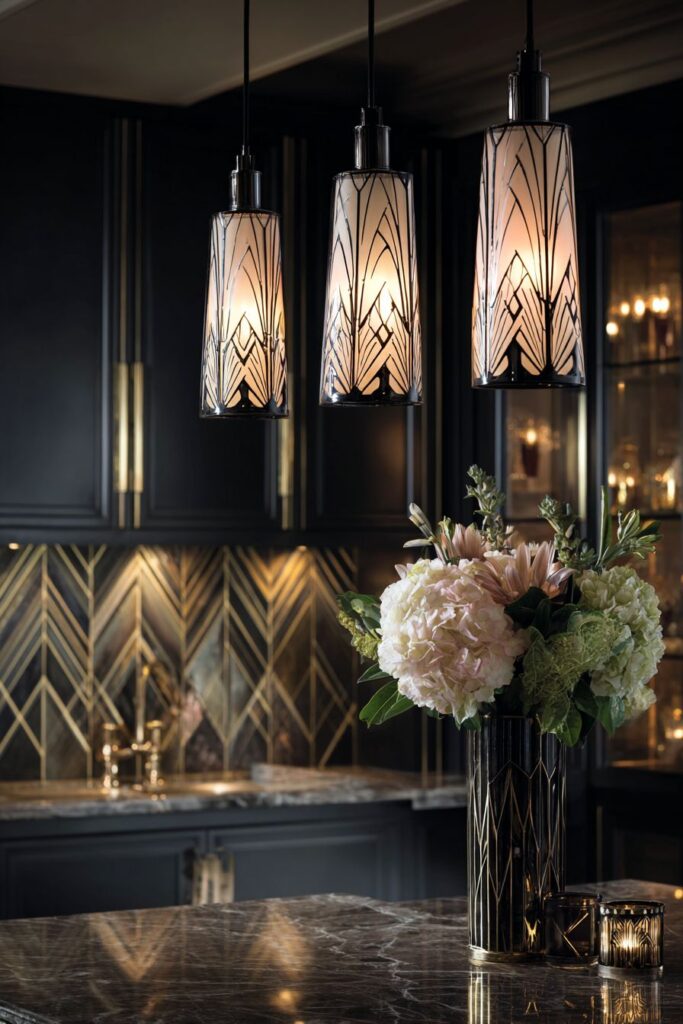
Key Design Tips:
- Use geometric patterns strategically for maximum impact
- Include authentic period materials like marble and brass
- Choose lighting fixtures that reinforce the historical aesthetic
- Balance dramatic patterns with simpler elements
- Focus on quality materials and finishes for authentic luxury
28. Modern Country Comfort
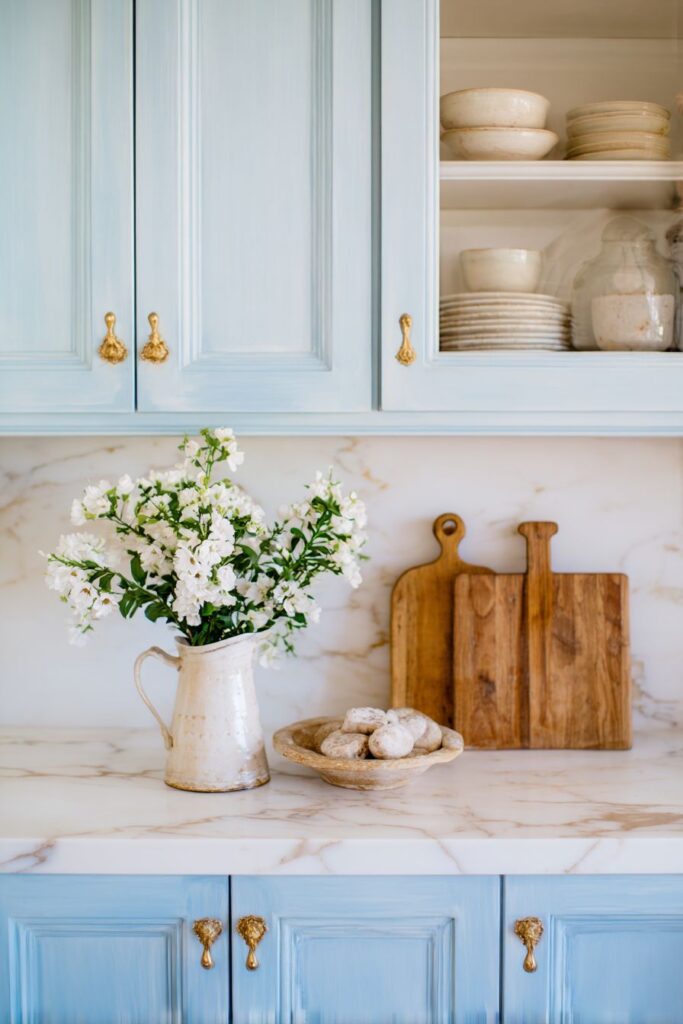
Painted wood cabinetry in soft blue-grey creates a fresh take on country style that feels both traditional and contemporary. Natural stone countertops with visible fossils add geological interest while maintaining the connection to natural materials that defines country design. Vintage-inspired hardware in aged brass provides authentic detail while offering modern functionality.
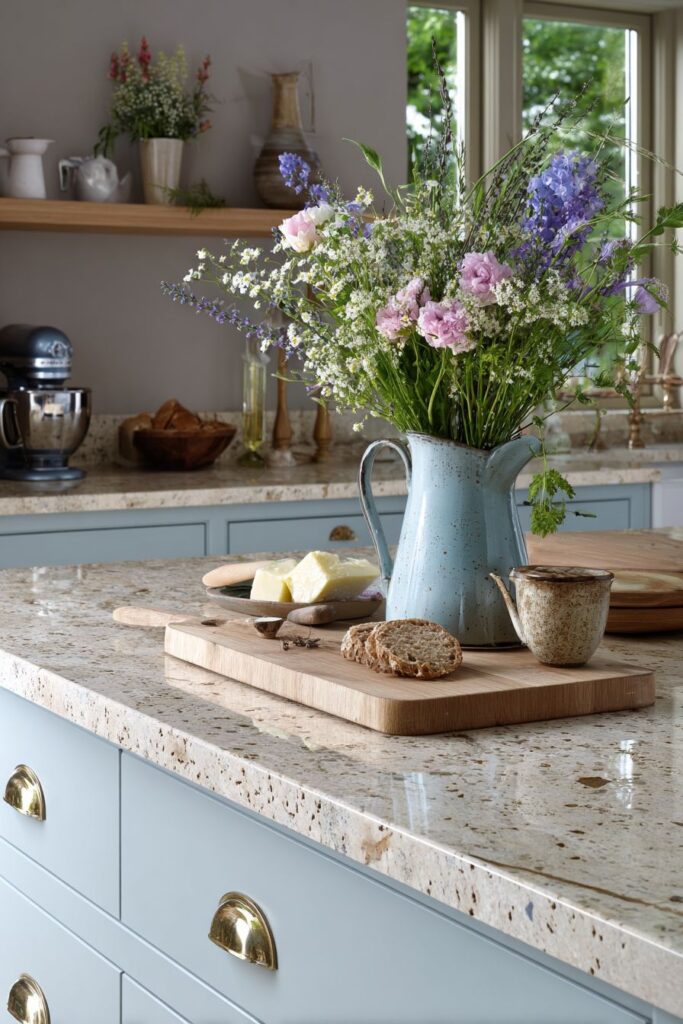
Fresh flowers in ceramic pitchers and wooden cutting boards create natural styling that speaks to the country kitchen’s connection to farming and food preparation. These functional decorative elements change with the seasons while maintaining the space’s commitment to natural beauty and practical functionality. The organic shapes and materials create visual softness.
Warm interior lighting with golden hour qualities enhances the country aesthetic while creating the comfortable, lived-in atmosphere that makes country kitchens so appealing. The soft lighting brings out the blue-grey cabinet color while highlighting the natural stone’s texture and the wooden accessories’ grain patterns.
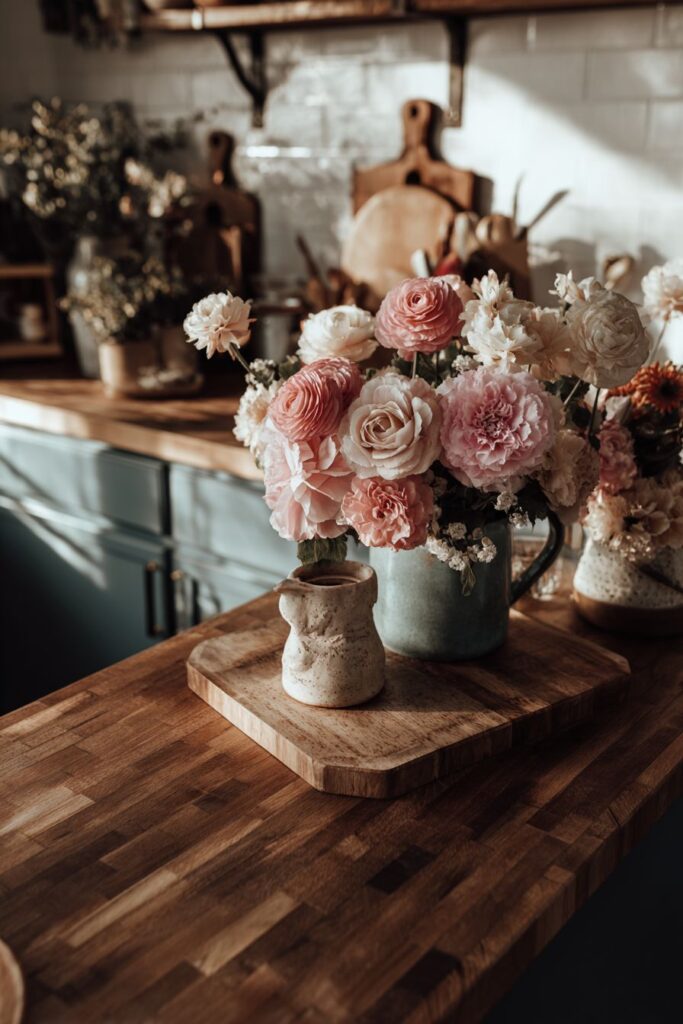
This modern country kitchen successfully updates traditional country style for contemporary living while maintaining the warmth and comfort that makes this aesthetic eternally popular. The combination of natural materials, soft colors, and comfortable functionality creates a space that feels both timeless and current.
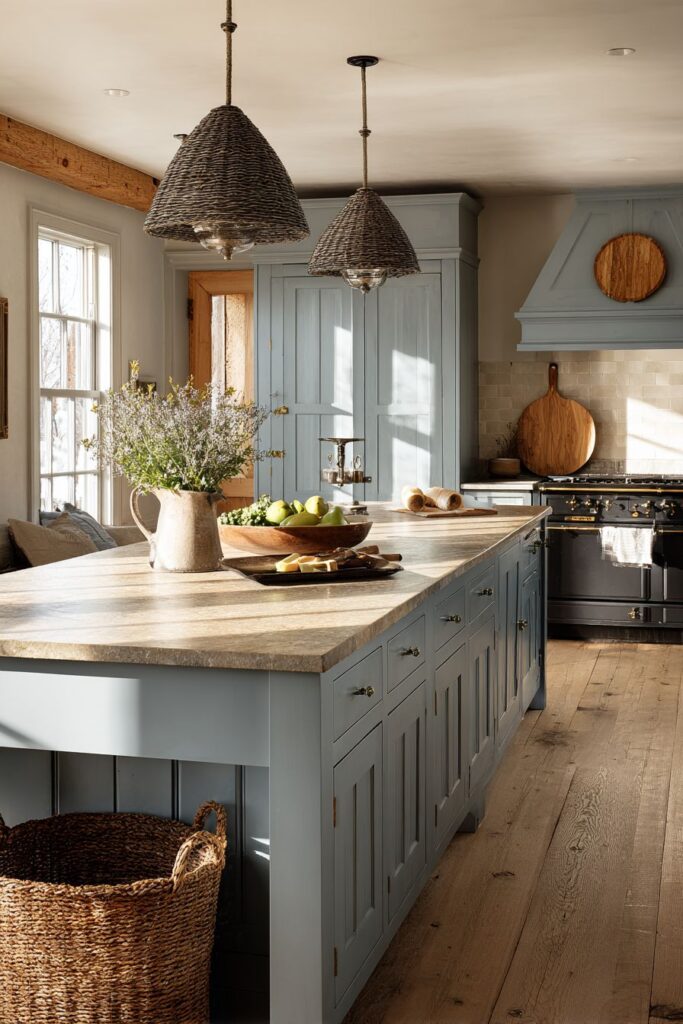
Key Design Tips:
- Choose paint colors that feel fresh while maintaining country character
- Include natural materials with interesting textures and patterns
- Display functional items as decoration for authentic country appeal
- Use warm lighting to enhance the comfortable, lived-in atmosphere
- Balance traditional elements with contemporary conveniences
29. Urban Loft Industrial Edge
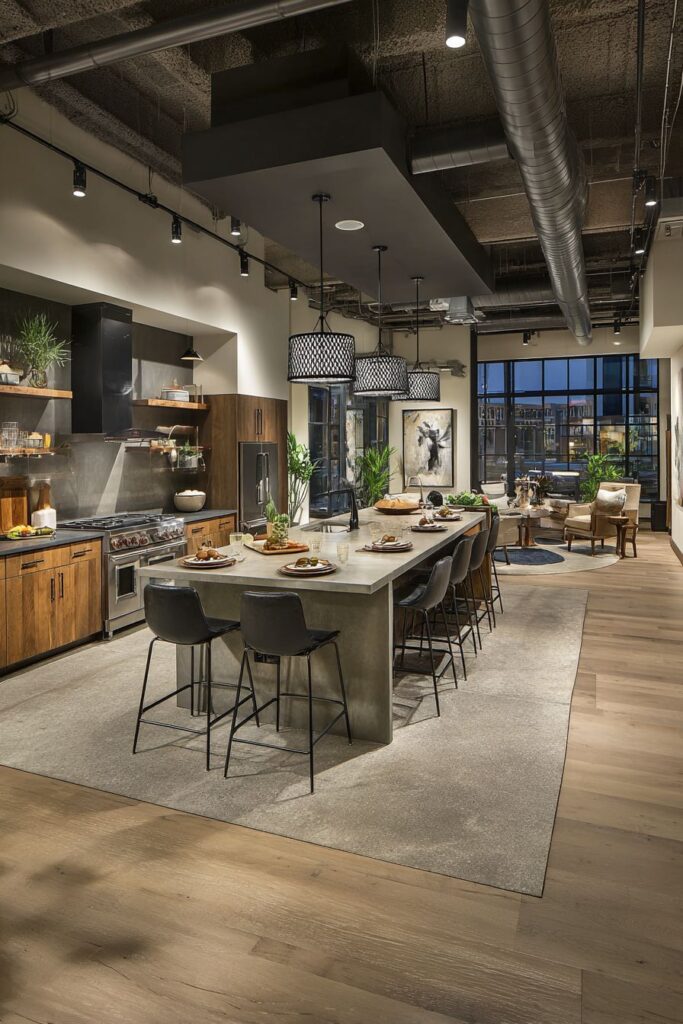
Exposed ductwork painted black and concrete countertops with visible aggregate create an authentic urban loft aesthetic that celebrates industrial materials and honest construction. Industrial-style pendant lights with metal mesh shades provide task lighting while reinforcing the urban aesthetic. The raw materials create texture and visual interest while maintaining the space’s industrial credibility.
Reclaimed wood accents on open shelving soften the hard industrial materials while adding warmth and human scale to the space. The contrast between hard and soft materials creates visual balance while maintaining the loft’s industrial character. The wood’s natural imperfections provide relief from the precision of industrial materials.
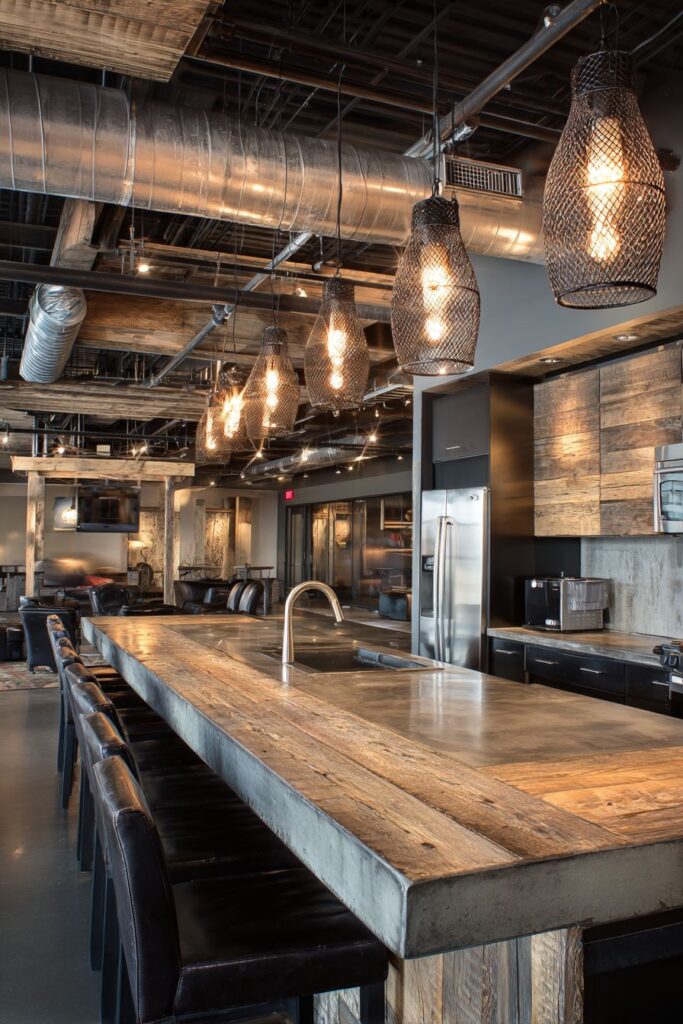
The exposed systems and raw materials celebrate the beauty of functional elements rather than hiding them behind decorative facades. This honest approach to construction creates authenticity that cannot be replicated through surface applications. The industrial elements tell the story of urban adaptive reuse and sustainable design practices.
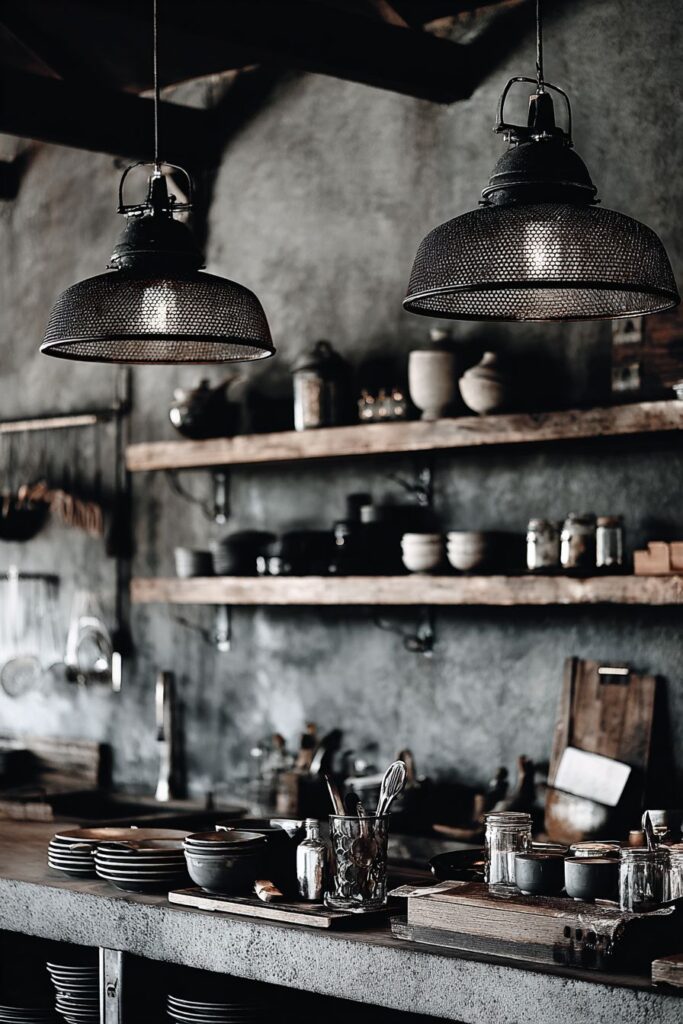
This urban loft kitchen demonstrates how industrial materials and exposed systems can create sophisticated living spaces when thoughtfully integrated and balanced with warmer elements. The result is a space that feels both urban and residential while maintaining industrial credibility.
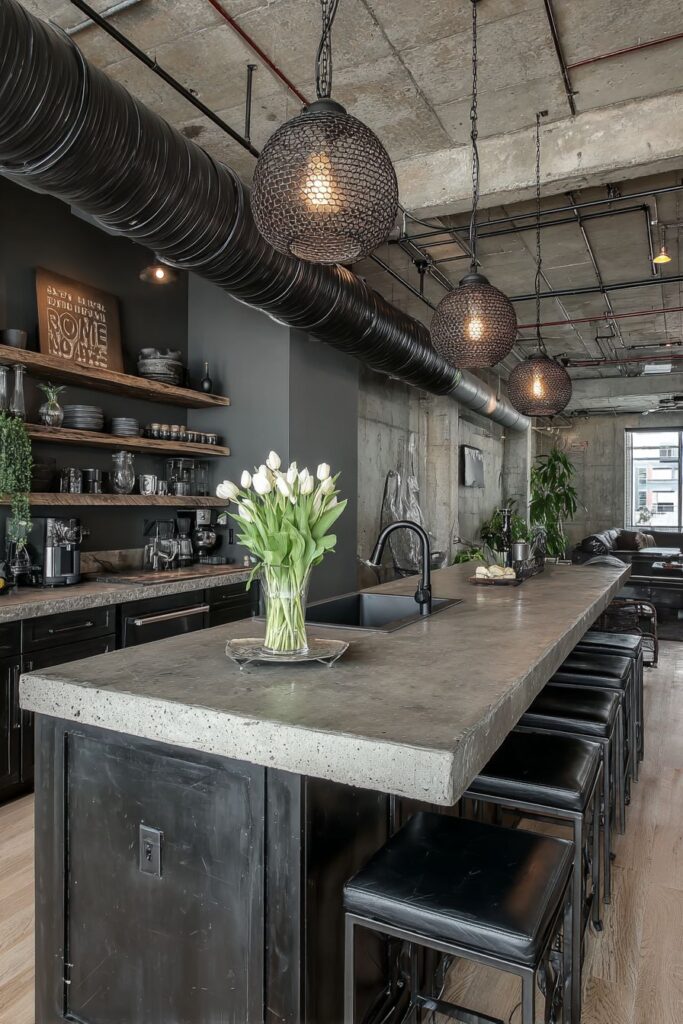
Key Design Tips:
- Paint exposed systems in consistent colors for intentional appearance
- Balance hard industrial materials with warm natural elements
- Use authentic industrial lighting fixtures for credible aesthetic
- Include reclaimed materials for sustainability and character
- Maintain consistent material palette for cohesive design
30. Traditional English Country Elegance
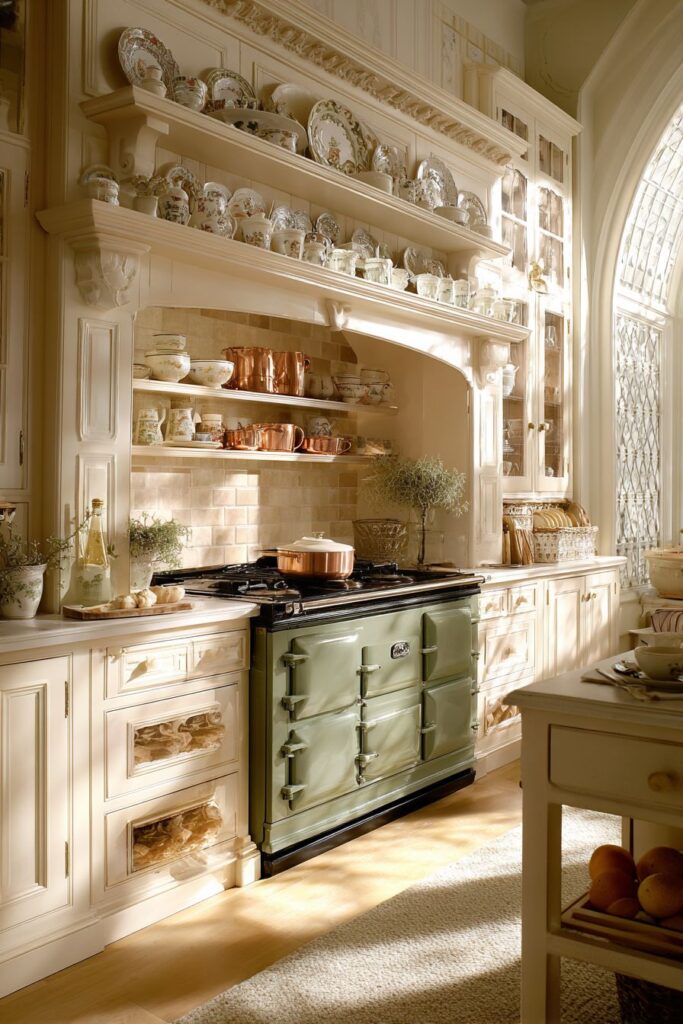
Cream-colored cabinetry with decorative crown molding creates the foundation for authentic English country style that celebrates traditional craftsmanship and timeless design principles. A classic AGA-style range in sage green provides the focal point while maintaining period-appropriate color and form. Open shelving displays transferware dishes and copper molds that reinforce the traditional aesthetic.
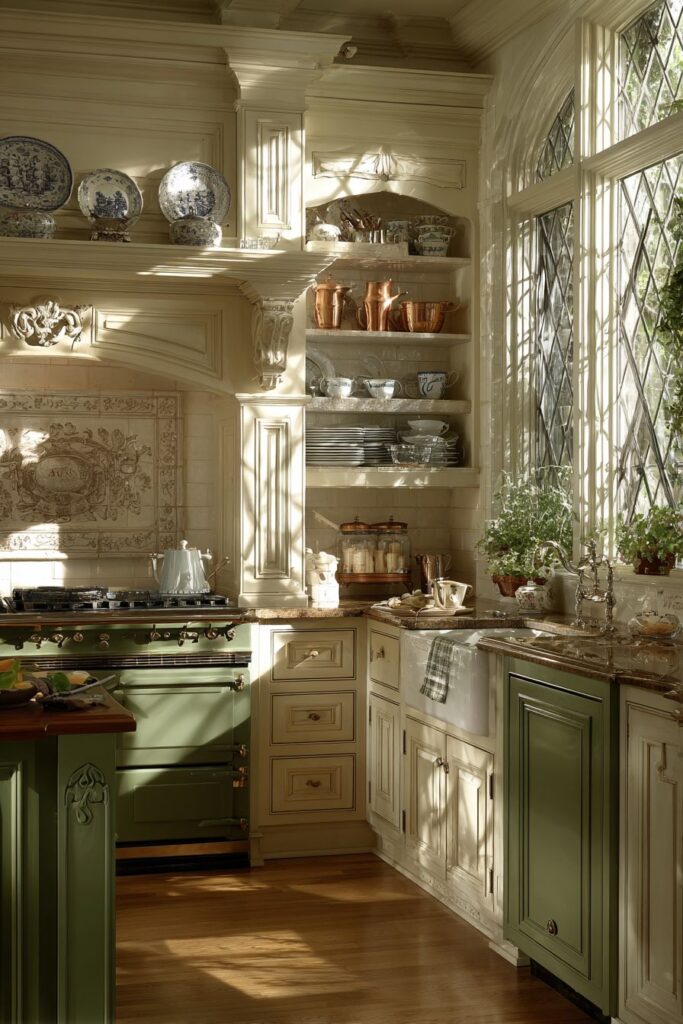
Natural light through mullioned windows creates gentle shadows that enhance the traditional materials while providing the soft, diffused lighting that characterizes English country interiors. The window details add architectural interest while maintaining authentic period character. The natural light brings out the cream cabinetry’s warm undertones.
The display of traditional English ceramics and copper cooking implements creates authentic period atmosphere while providing functional storage for frequently used items. These collections speak to generations of cooking traditions while adding visual interest and cultural authenticity to the space. Each displayed item contributes to the overall narrative.
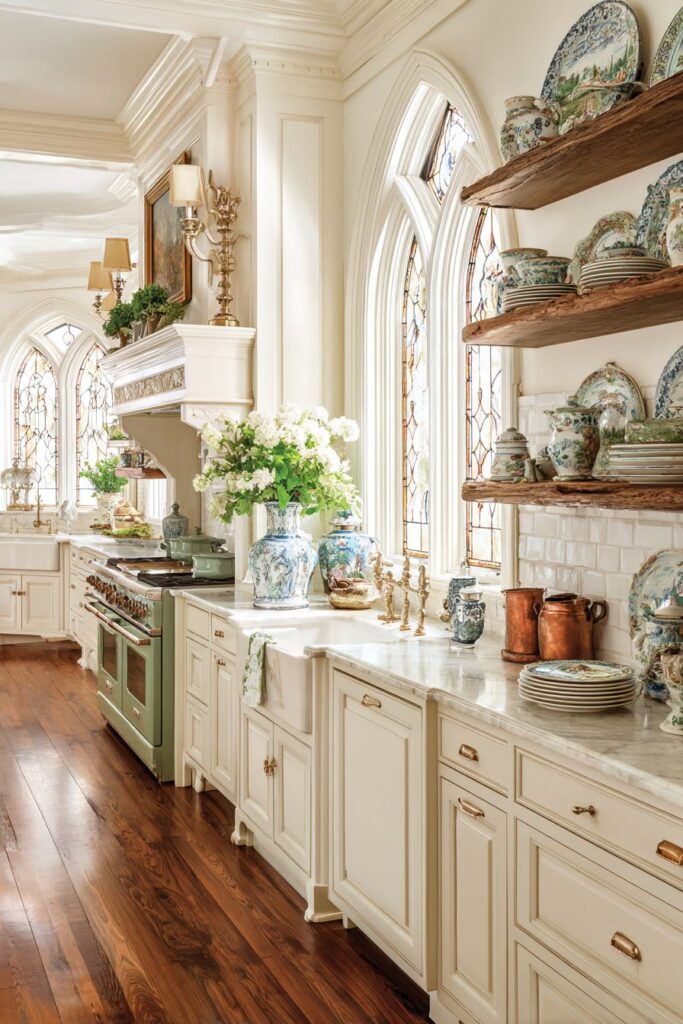
This English country kitchen successfully captures the essence of traditional English design while adapting historical elements for contemporary living. The combination of authentic materials, traditional colors, and period-appropriate details creates a space that feels genuinely historical while remaining highly functional.
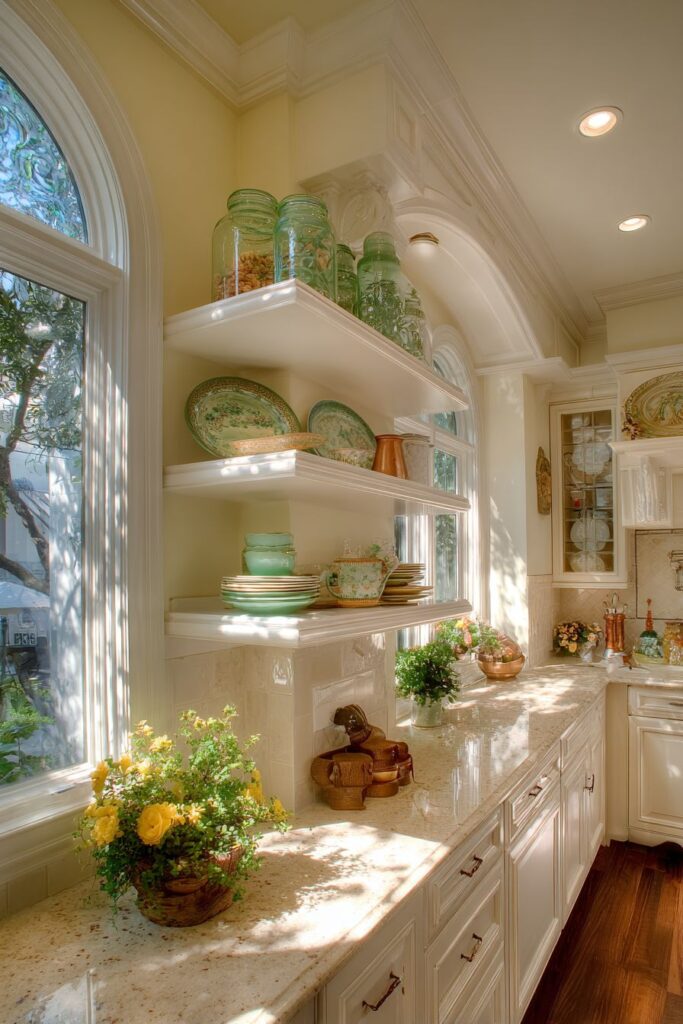
Key Design Tips:
- Include authentic architectural details like crown molding and mullioned windows
- Choose period-appropriate appliance styles and colors
- Display traditional ceramics and implements for cultural authenticity
- Use cream and sage color palettes for traditional English appeal
- Focus on quality craftsmanship in millwork and cabinetry details
Conclusion
These thirty distinctive kitchen design concepts demonstrate the incredible versatility and potential that exists within kitchen design today. From the rustic warmth of farmhouse styling to the sleek sophistication of modern minimalism, each approach offers unique solutions to the challenges of creating beautiful, functional spaces for cooking, dining, and gathering. The key to successful kitchen design lies not in following trends blindly, but in understanding how different materials, colors, textures, and layouts can work together to create spaces that reflect personal style while meeting practical needs.
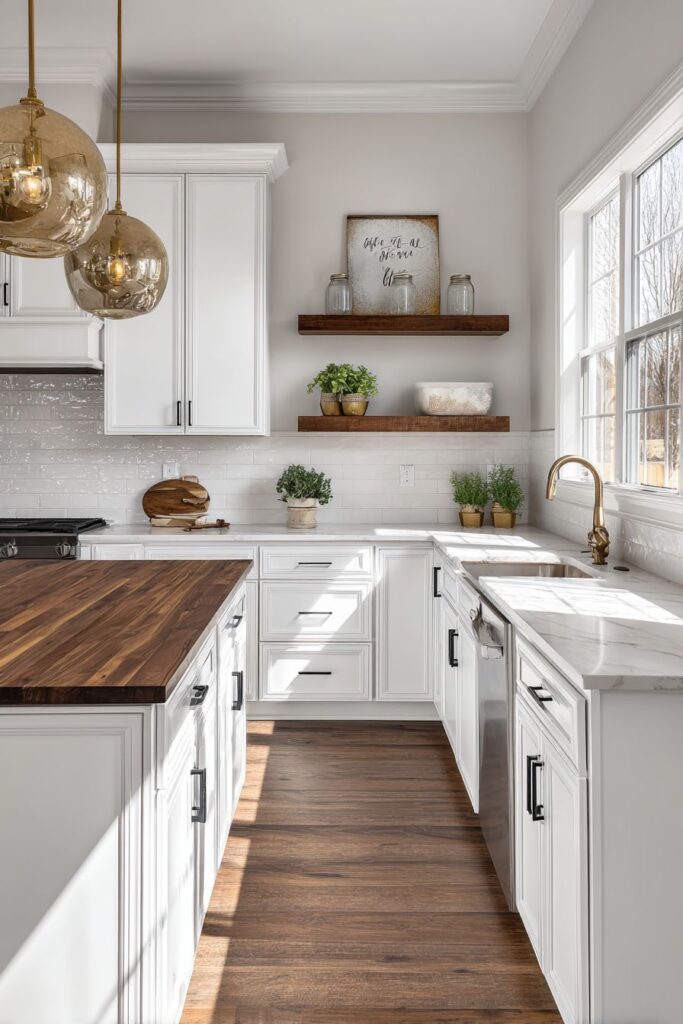
The designs showcased here prove that exceptional kitchen design is achievable regardless of budget constraints, spatial limitations, or architectural style. Whether you’re drawn to the dramatic contrast of black and white schemes, the warm comfort of country aesthetics, or the clean lines of contemporary design, the principles remain consistent: thoughtful material selection, careful attention to proportion and scale, and a commitment to balancing beauty with functionality.
As you consider implementing these ideas in your own home, remember that the best kitchen designs evolve organically over time, incorporating personal collections, seasonal changes, and the natural patina that comes with daily use. The most successful kitchens are those that not only look beautiful on the day they’re completed but continue to grow more beautiful and functional as they adapt to the rhythms of daily life. Whether you choose to implement one dramatic change or gradually incorporate multiple elements, these design concepts provide a foundation for creating a kitchen that truly serves as the heart of your home.
